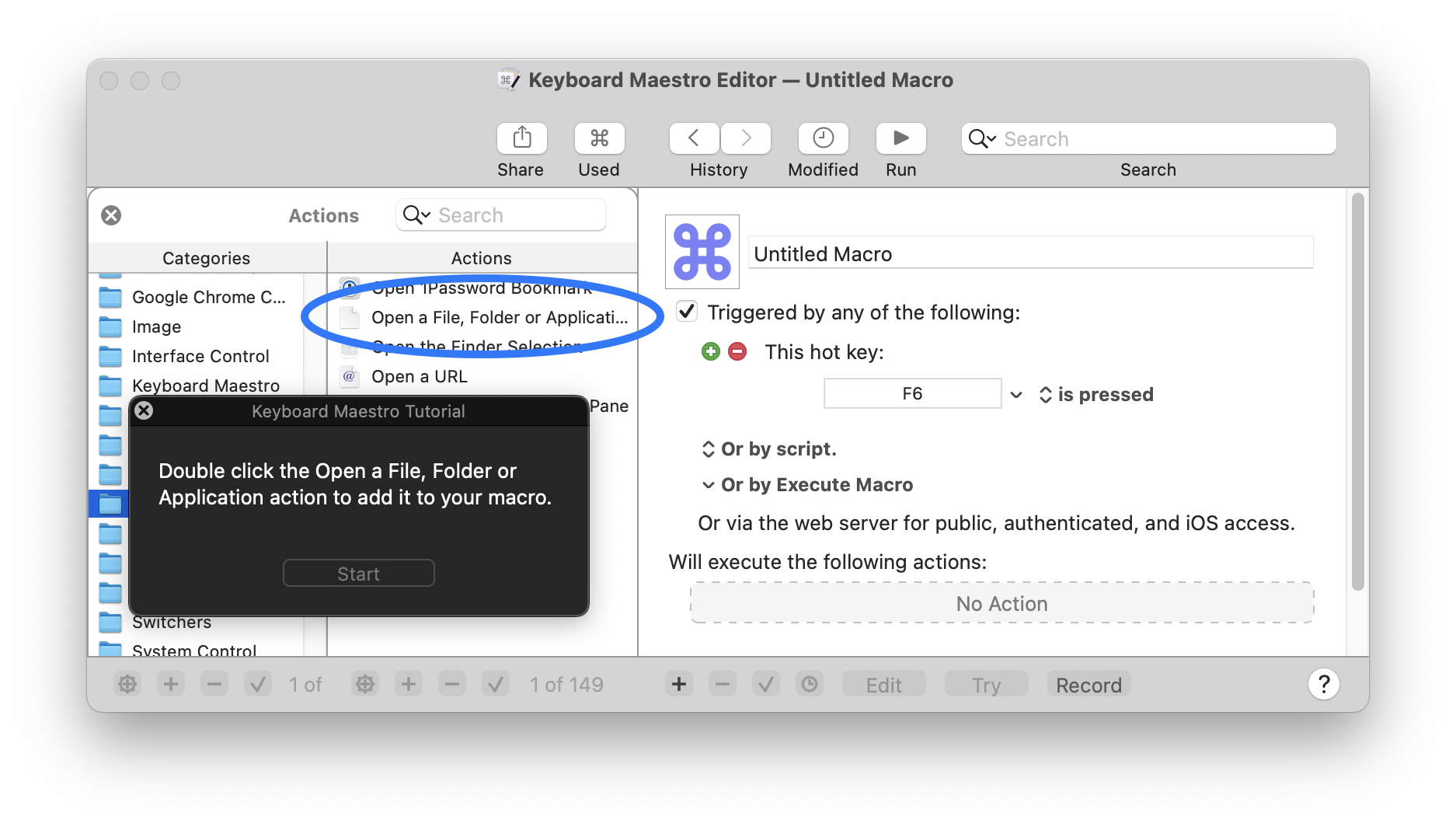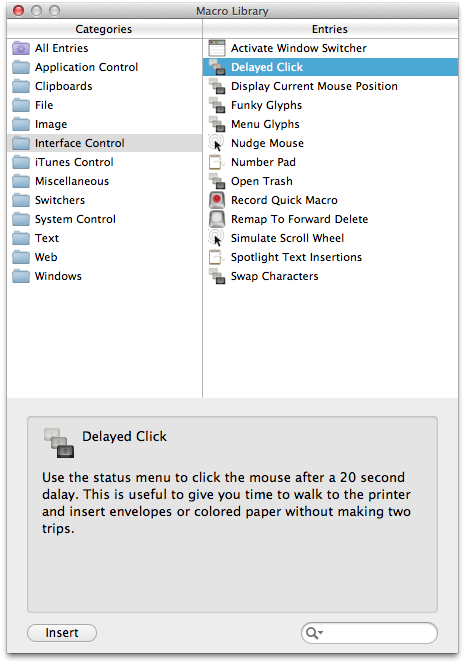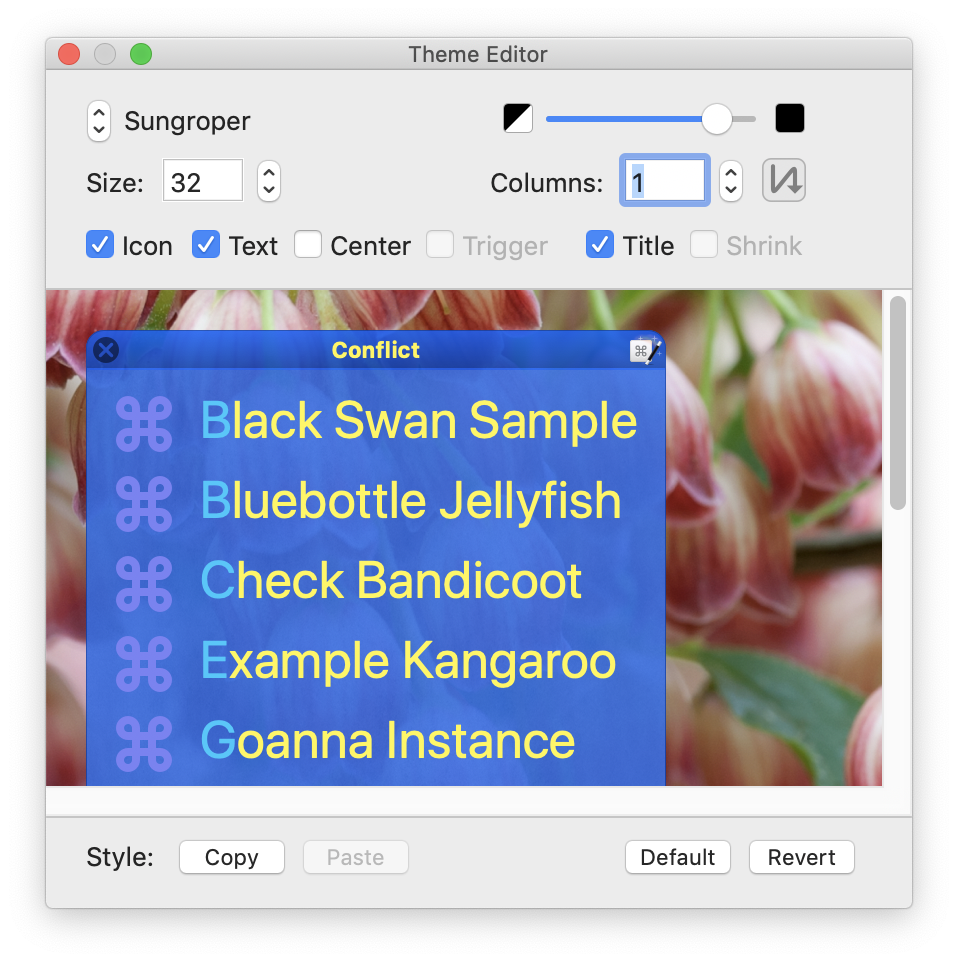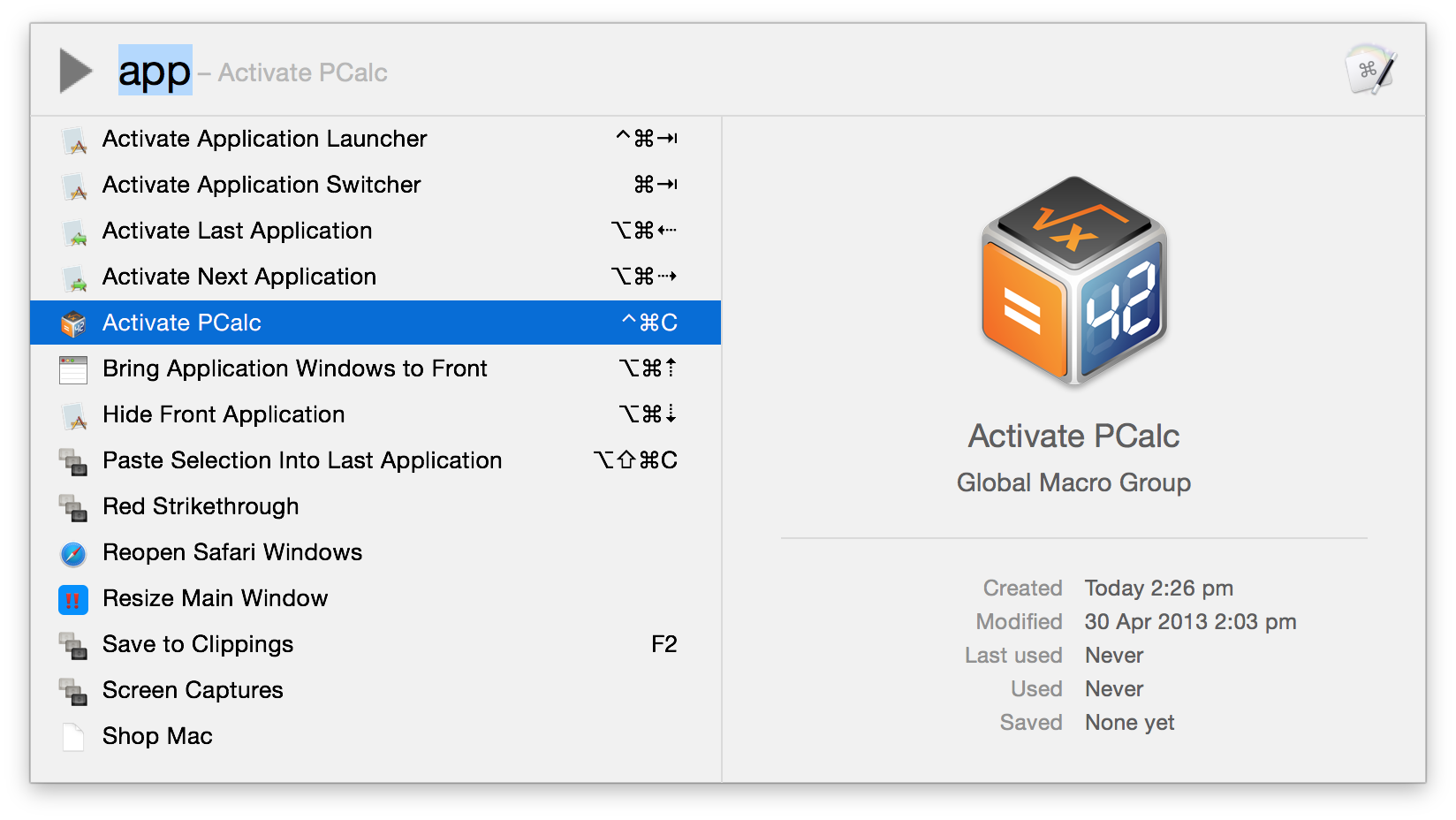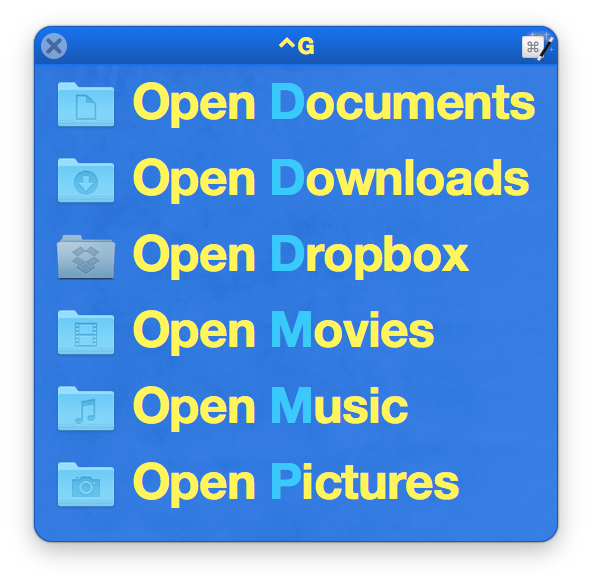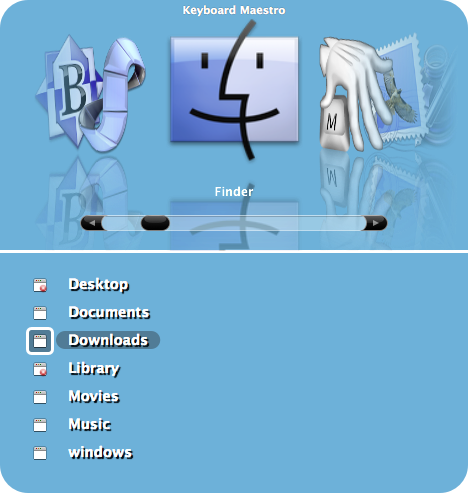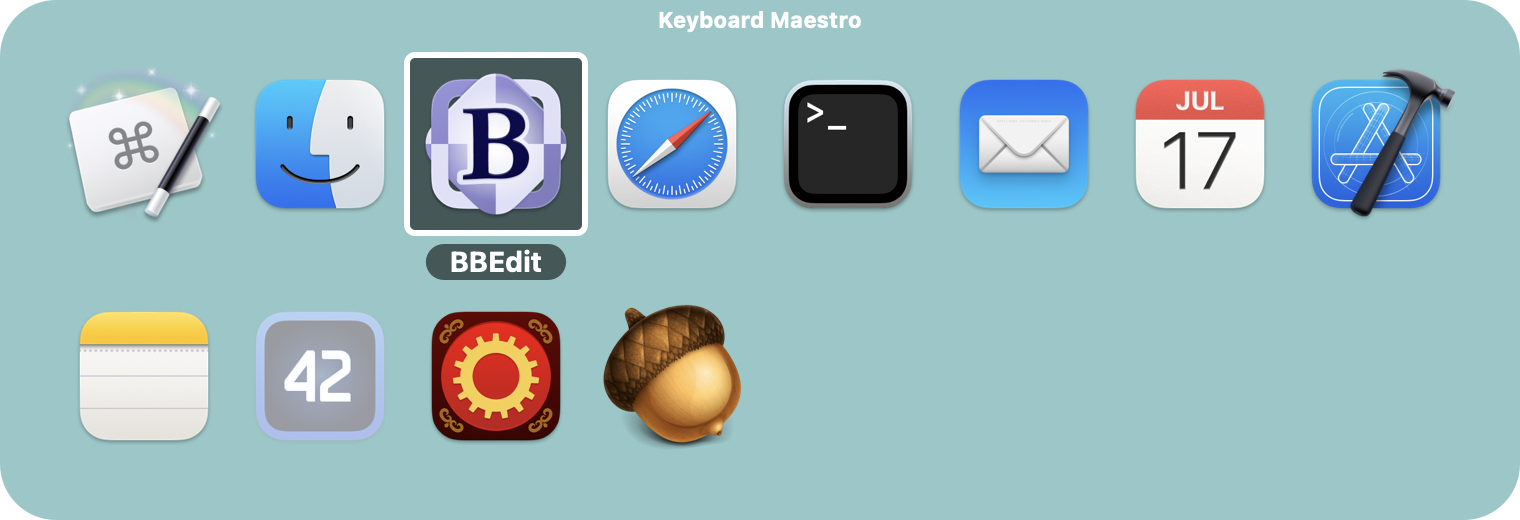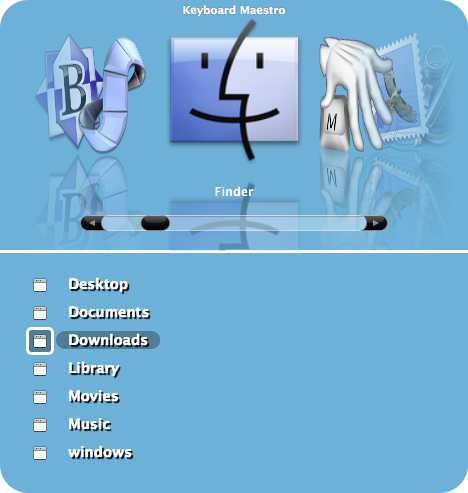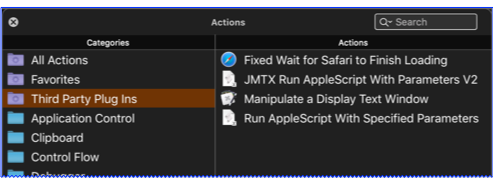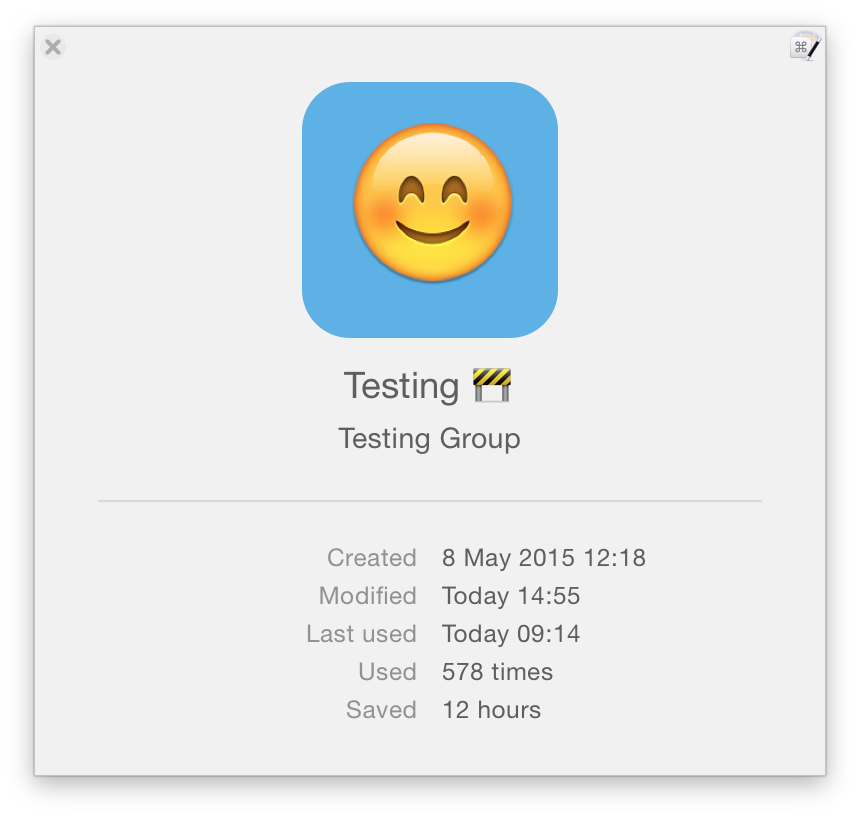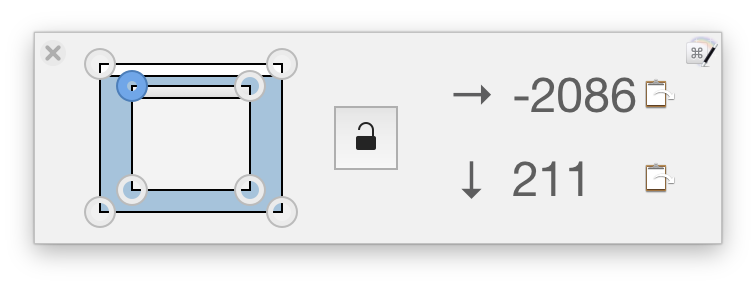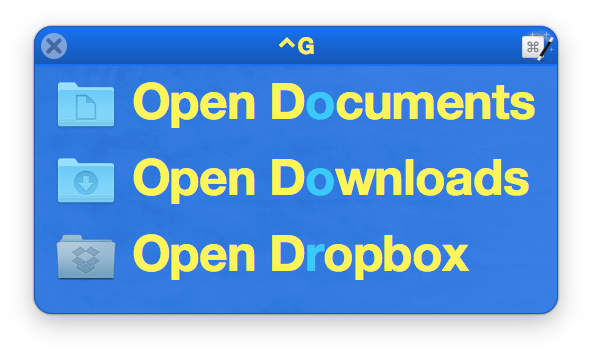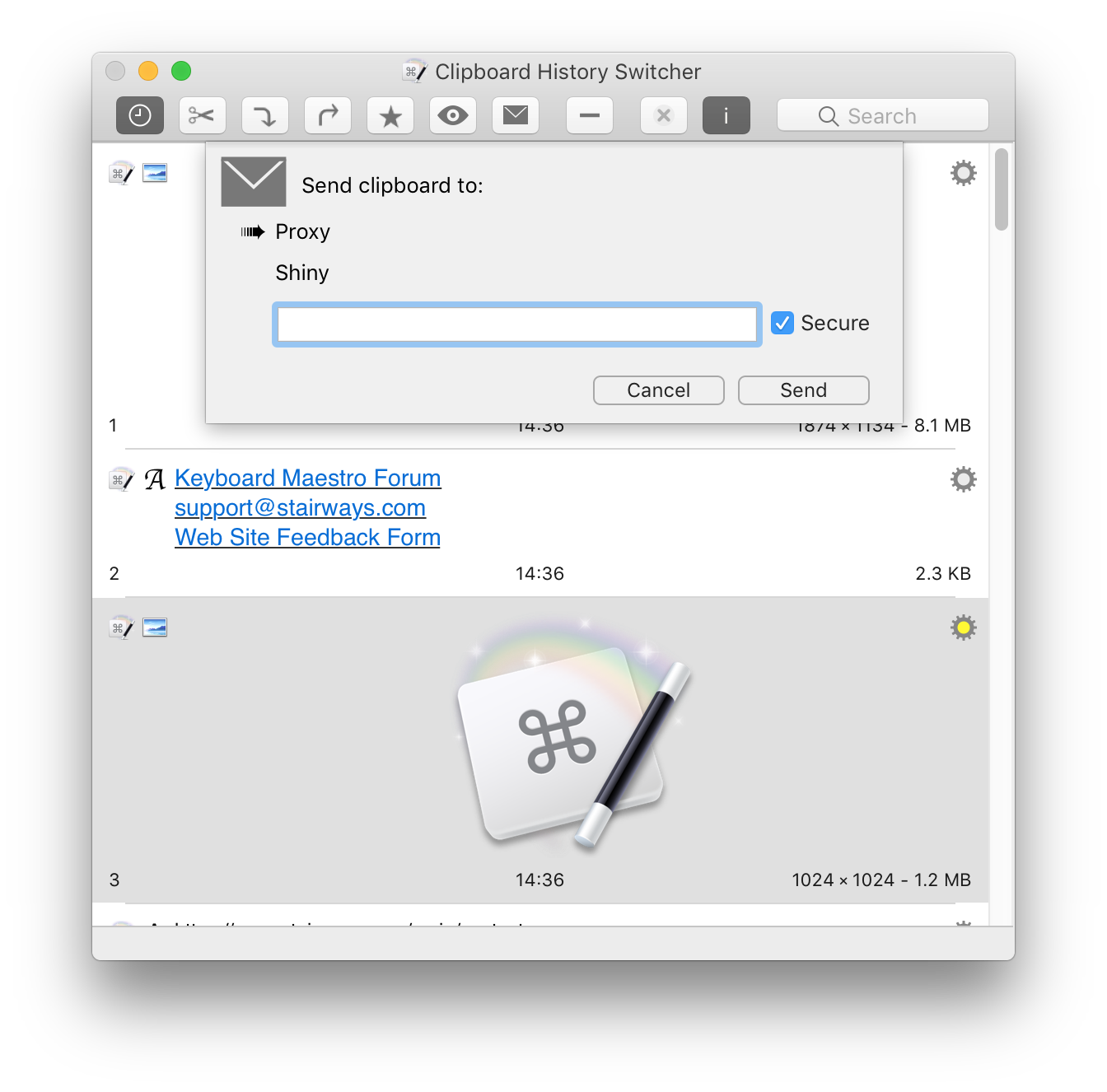Table of Contents
Keyboard Maestro 11 User Manual
Overview
Keyboard Maestro will take your Macintosh experience to a new level. Keyboard Maestro enables you to create or record custom macro shortcuts that you can activate at any time. For example, your macros could help you navigate running applications or work with an unlimited number of clipboards. Best of all, every macro you create is available using simple keystrokes you choose or a variety of other triggers. The only limit to Keyboard Maestro is your imagination!
Using Keyboard Maestro’s powerful Macros, you can make your Mac behave the way you want it to behave – open documents when and where you want them, type sentences with the press of a key, expand abbreviations into entire paragraphs, control web applications, and much more. You simply define what you want your Mac to do and when you want it done.
Keyboard Maestro comes complete with a clipboard history, saving everything you copy for later use so you’ll never lose something on your clipboard again, as well as named clipboards where you can store commonly used images or text.
Keyboard Maestro also includes a powerful Application Switcher and Window Switcher so you can cycle through applications or windows, closing, hiding, launching, and more as well as an Application Launcher that lets you quickly launch applications.
Keyboard Maestro requires a Mac running macOS 10.13 High Sierra or later.
Keyboard Maestro is free to try with no limitations. Once the trial period ends, a license must be purchased to continue using it.
What’s New?
Keyboard Maestro 11 expands on the powerful base of previous versions, improving the editor, adding many new actions and triggers, New Macro Wizard, a new Security preference pane, a keyboardmaestro command line tool, support for Apple Text Recognition, and more. Keyboard Maestro 11 requires macOS 10.13 High Sierra or later.
Changed in 11.0.4
- Added display to Switch/Case actions to indicate which entries are true/would execute currently.
- Adjusted Set Variable to Calculation format to be a token text filed. (forum)
- Show Macro Group name when multiple macros from the same group are displayed in the Macro Inspector. (forum)
- Default to Apple Text Recognition in OCR action/conditions in 10.15+.
- Added Tool Tips for Macro Debugger window. (forum)
- Ensure all export default names are consistent.
- Added
com.microsoft.ShadowWorkbookto clipboard flavor exclusion list. - Removed animation of some lists because of performance issues in modern macOS.
- Re-enable
existscondition for Environment Variable condition. - Added warning if you use
document.kmvarin a script when in modern syntax. (forum) - Allow Environment Variable values as script input.
- Added display name for Menu/Application key.
- Return true for
has imagecondition when the clipboard contains an image reference. (forum) - Display Mouse lock time now honours hidden preference. (forum)
- Fixed Macro Library Clipboard Filter Rotate 180° to actually Rotate 180°.
- Fixed an issue with Subroutine trigger not being searchable.
- Fixed a possible bug in Engine Window details.
- Fixed an issue with Filter HTML List.
- Fixed an issue with search highlighting triggers. (forum)
- Fixed an issue with some icon displays in Sonoma and later.
- Fixed an issue with the Prompt With List action not being canceled in all cases when Cancel All Macros is used. (forum)
- Fixed an issue with the Typed String condition. (forum)
- Fixed incorrect trigger value for USB Device Key Control keys. (forum)
- Fixed Select Macros Column menu item not being disabled when the column is selected. (forum)
Changed in 11.0.3
- Support dragging a file on to the File Selection button in the Write to File action. (forum)
- Added the SelectMenuByNameText token. (forum)
- Corrected %LongSystemVersion% token to %SystemLongVersion%. (forum)
- Worked around a bug in NSRegularExpression erroneously setting NSMatchingHitEnd. (forum)
- Worked around an issue with Open the Finder Selection action. (forum)
- Remove
existscondition for Variable condition which has no single meaning. - Resolved a crash if you enter percent characters in USB Device or Mounted Volume trigger names.
- Fixed Manipulate a Window action not working on multiple windows when it should have.
- Fixed an issue with Focused Window Titled Changed trigger on activation. (forum)
- Fixed an issue with displaying some forms of styled text. (forum)
- Fixed an issue where the Active Macro Groups palette could be incorrect.
- Fixed a possible issue with New Google Chrome Window action putting the URL in the old window.
- Fixed an issue where modifiers could be added to the search field if it was the focussed field when the editor activated. (forum)
- Tried again to resolve issues with non-integer refresh rates and the Set Screen Resolution action.
Changed in 11.0.2
- Resolved an issue Display Large Text action stealing focus in Sonoma.
- Worked around an issue when setting window position and size when the system is animating the changes and gets confused.
- Resolved an issue with keys in the status menu not being handled for a period of time after the Status Menu is opened.
- Resolved an issue with Set Variable to Text action and arrays within tokens. (forum)
- Set Variable to Text action will error if it is setting an indexed element and the index is out of range. (forum)
- Resolved a performance issue with the %FrontDocumentPath% token in the editor.
- Possibly resolved an issue with USB Device Key triggers when lots of 0 packets are sent by the device.
- Fixed an issue with the non-edit display of OCR languages.
- Fixed an issue with non-integer screen refresh rates.
Changed in 11.0.1
- Request Calendar permission when using the Create Calendar Event action.
- Fixed an issue with Press a Button and other actions when it fails but does not abort the macro.
- Fixed some issues with the Select Menu by Name action.
- Fixed Search and Replace action to fail when the source cannot be read.
- Mitigate issue with 1Password corrupted bookmarks causing a crash/lag.
- Fixed an issue with Show Palette of Macros action not using the default theme initially. (forum)
- Fixed the %TriggerBase% token for the Periodic, Time of Day and other triggers. (forum)
- Fixed an issue with %FinderSelections% and other tokens on pre-Ventura systems.
- Added a TokenTimeout and ForceSynchronousTokens preference. (forum)
- Fixed some false positives with modifier only Typed String triggers.
- Fixed an issue with Find Image & Click Mouse With Found Image actions when Waiting For Match.
- Resolved an issue with the macro group Toggle window stealing focus in Sonoma.
- Fixed a possible issue with some Wireless Network trigger names.
- Fixed a minor issue with the non-Edit display of Smart Groups.
Editor
- Added New Macro Wizard to quickly make new macros.
- Added Security preference pane to summarise the state and adjust the various system security settings.
- Added Macro Group synching option to Disable Macro Group on All Macs. (forum)
- Report if macros that are deleted are in use by other macros.
- Added deprecated: search string.
- Added action:1234 search string.
- Added word:wombat search string.
- Show Click Location in Quick Look view of images in Click at Found Image action (contstant offsets only).
- Added “Do Not Ask Again” option to Evaluate Conditions alert.
- Added link to wiki Preferences in the General preferences settings.
- Support inserting “¬” characters with option-Return in AppleScript script fields.
- Support text completion for Path fields.
- Support
macrosin AppleScript smart groups. (forum) - Added warning if the Keyboard Maestro application is moved while it is running. (link)
- Added Find button when deleting a named clipboard that is used by one or more macros.
- Added Move Action Up/Down menu items.
- Added support to Press a Button action to scan application windows for buttons.
- Default new Execute a JavaScript actions to modern syntax.
- Added live results to the Search and Replace action. (forum)
Engine
- Added keyboardmaestro command line tool for triggering or editing macros.
- Added modern JavaScript syntax mode.
- Added support for limiting variables passed to scripts.
- Added Apple Text Recognition to OCR options (macOS 10.15+). (forum)
- Added Active Macro Groups palette to show which groups are active (available via the Help menu or the Status Menu).
- Simplified
Paste "xyz"submenu in the status menu to just display the text. - Added an option to include macro icons in the status menu.
- Added an option to include macro icons in the group status menus.
- AppleScript
do scriptnow returns results from the Return action. - Execute Macro shortcut returns results from the Return action.
- Added Blue Topaz palette theme. (forum)
- Request Screen Recording permission if the Pixel condition is used.
- Request Contacts permission if the %AddressBook% token is used.
- Allow Create Unique File action without an output variable to execute without error.
- Improved detection and reporting of errors in Browser Actions.
- Added an option to show only images in the Clipboard History Switcher. (forum)
- Support Command & Command-Shift Arrows in Spotlight-like windows.
- Support
\processing in variable token array item separators (eg %Variable%Lines[3]\n%). - Limit %JavaScript% tokens maximum execution time to half a second.
- Support arbitrarily large numbers of files dropped on a palette entry. (forum)
- Resolve symlinks for Applications (specifically this helps with the move of Safari in Ventura).
- Removed use of deprecated SecKeychainUnlock et al.
- Remove the “The text is” (and similar) from the Display Text windows. (forum)
- Allow Prompt for User Input sliders to return decimals. (forum)
Triggers
- Added Space Changed trigger. (forum)
- Added tapped only once/twice/3 times options to Hot Key and USB Device Key triggers.
- Added support for modifiers in Typed String triggers (eg “em⇧” means e, m, tap the shift key). (forum)
Actions
- Added Prompt for Snippet action.
- Added Create Calendar Event action (macOS 10.14+).
- Added Send Pushover Notification action.
- Added Set Screen Resolution action.
- Added Select Menu by Name action.
- Added Remove Clipboard Flavors action.
- Added Set Audio Input/Output/Sound Effects Device actions.
- Added Mute/Unmute Audio Device actions.
- Added Get Location action.
- Added option to Click at Found Image action to wait for the image to appear.
- Added option to Find Image on Screen action to wait for the image to appear.
- Added Progress Bar option to Repeat action.
- Added support for other kinds of behaviours (eg showing a menu) to the Press a Button action. (forum)
- Added an optional HelpURL field to Plug In Actions. (forum)
- Added support to Set JSON Value action to delete dictionary or array entries by setting to
%Delete%. - Added explicit File Move and File Rename options to the Move or Rename a File action. (forum)
- Added Hide Other Applications, Bring All Windows to Front and Reopen Initial Windows options to Activate a Specific Application action when already at front.
- Added an option to reduce the CPU usage of Pause Until actions for long running pauses.
- Support Set Variable to Text action setting array elements of a variable. (forum)
- Added configurable themes for Show Palette of Macros action. (forum)
- Added option to Applications Palette to default to Hide Others when switching.
- Added option to Apply Modifiers to Application action to default to Hide Others when switching.
- Add options for All Windows and Reopen Windows to Activate Last Application action. (forum)
- Added File option to Stream Deck Set Image action. (forum)
- Support Save to File as an output option to the Get a URL, Execute Script/Shortcut, and Plug In actions. (forum)
- Support saving images to Clipboard/File in a variety of formats for Get a URL, Execute Script/Shortcut, and Plug In actions.
- Adjusted Hide Front Application action to wait for the application to no longer be active before proceeding.
- Adjusted Quit Application (et al) actions to wait for the application to terminate (or relaunch).
Conditions
- Add a File Attribute condition. (forum)
- Added Macro is Executing condition condition.
Filters
Tokens
- Added %Safari/Chrome/FrontBrowserWindowName% tokens.
- Added %Safari/Chrome/FrontBrowserVersion/LongVersion% tokens.
- Added %Safari/ChromeBundleID/Path/Name% tokens.
- Added %FrontDocumentPath% token (thanks Chris!). (forum)
- Added %ApplicationVersion/LongVersion% tokens. (forum)
- Added %KeyboardMaestroVersion/LongVersion% tokens. (forum)
- Added %SystemVersion/LongVersion% tokens. (forum)
- Added %LastAbortedActionID% token. (forum)
- Added %OptionReturn% token (valid in Insert Text by Typing only).
- Added %ScreenResolution(s)% tokens.
- Added %AudioInputDevice(UID)% tokens.
- Added %AudioOutputDevice(UID)% tokens.
- Added %AudioSoundEffectsDevice(UID)% tokens.
- Added %AudioInputDevices% and %AudioOutputDevices% tokens.
- Added %MusicPlayerState% token.
- Added %SystemClipboardFlavors% token
- Added %PastClipboardFlavors% token
- Added %NamedClipboardFlavors% token
- Added %TriggerClipboardFlavors% token
- Adjusted the %FinderSelection(s)% tokens to return the selected item, not the target of an alias/link. (forum)
Functions
- Added PROCESSORS() function. (forum)
Fixes
- Fixed a performance issue in the editor switching to/from macros with large numbers of triggers. (forum)
- Fixed a crash that could happen if the icon of one macro was dependent on another recursively. (forum)
- Fixed a possible crash after duplicate Typed String triggers fire and the macros are immediately reloaded.
- Fixed an issue with Prompt for User Input sliders with initial values above 100. (forum)
- Fixed some issues with the Ruler in text views.
- Fixed an issue searching for greater than 16-bit unicode characters. (forum)
- Fixed some issues with truncating strings with greater than 16-bit unicode characters.
- Fixed a glitch in the KeyCaps.icns file. (forum)
- Fixed an issue with %FinderSelection% and %FinderSelections% tokens.
- Fixed an issue with USB Device Key trigger and MacBook Pro M2 Product ID = 0 keyboards.
- Fixed Execute a JavaScript in Custom Prompt action to process tokens on script paths.
- Fixed using Helvetica in the Spotlight-like windows.
- Fixed keyboardmaestro: URL so it works when the editor is launched.
- Fixed Typed String triggers with regular expressions to produce conflict palettes if appropriate.
- Fixed an issue with the non-edit trigger display of times in certain time zones. (forum)
- Fixed setting Trigger Macro by Name to a Smart Macro Group. (forum)
- Fixed a memory leak when finding images. (forum)
- Fixed an issue with the Interactive Help listing macro execution multiple times.
- Fixed an issue with the Interactive Help not listing recorded Quick Macro executions.
- Added some logging for failed Accessibility window manipulations.
- Fixed issue where a duplicated search string matched action does not appear matched.
- Fixed an issue with overly enthusiastic search field completion suggestions.
- Fixed issue with Palettes displaying wide enough to hold a title that is not shown. (forum)
- Fixed an issue with the window switcher switching to different monitors. (forum)
Download
Download Keyboard Maestro now to try all these great capabilities. Or keep reading for even more details about the Features of Keyboard Maestro.
Alternatively, you can contact us if you have a question about whether Keyboard Maestro can solve your automation needs. We want all our customers to be satisfied, so we are happy to help you understand how Keyboard Maestro can achieve your automation goals.
Features
Keyboard Maestro is a productivity enhancer with several main functions. It allows you to:
- record and design your own macro shortcuts and activate them at any time.
- work with clipboard history using Clipboard History Switcher.
- work with an unlimited number of saved clipboards using Named Clipboard Switcher.
- navigate through running applications with Application Switcher and open windows with Window Switcher.
Macro Groups allow you to organize your macros. Think of them as folders of macros. Each Macro Group controls when the macros it contains are active. A Macro is made of two parts: a set of Triggers you choose to determine when the macro is executed and a list of Actions that define what the macro does when it is executed.
By creating macros, you can customize your Mac to suit your use, streamline tedious tasks, and remove opportunities for mistakes by automating repetitive jobs. Make stubbornly difficult applications behave the way you want them to; press a key and have the computer do the next minute worth of tedious tasks for you; type a few characters and have a page full of boilerplate text appear; and so much more. Soon you’ll wonder how you could have used your Mac without Keyboard Maestro.
Here are some of the primary features of Keyboard Maestro.
General
- Use Dark Mode or Light Mode (10.14+).
- Sync your macros across multiple Macs using DropBox or other file sharing systems.
- Trigger macros by key, typed string, menu, by name, remotely, via MIDI, and more.
- Use the included Assistance system to help if you get stuck.
- Use the included Macro Debugger for detailed control of your macros in action.
Macro Groups
- Create Macro Groups, which contain Macros and control when they are active.
- Macro Groups can be displayed in the menu bar with additional information and macros.
- Macro Groups can be restricted to or excluded from specific applications.
- Macro Groups can be restricted to or excluded from specific windows.
- Macro Groups can be activated or deactivated with hot keys, or via the status menu or global macro palette.
- Macro Groups can display a themed palette of contained macros.
- Macro Groups can be enabled or disabled.
- Customize the Macro Group icon by pasting an icon, or using the Icon Chooser and creator.
- If you are syncing your macros, Macro Groups can be disabled on specific Macs.
Triggers
- Macros can be triggered by one or more Macro Triggers using any number of the following:
- Hot Key trigger – when you press, hold, release or multi-tap a key.
- Global Macro Palette trigger – with a click on a context sensitive Macro Palette.
- Status Menu trigger – by selecting from a global system status menu.
- Typed String trigger – type a string of keys.
- Appearance Changed trigger - when the Mac changes system appearance.
- Application trigger – on launch, quit, activate, deactivate, or periodically while an application is running or active.
- Audio Output Changed trigger – whenever your audio output device changes.
- Clipboard Changed trigger – when the system clipboard changes.
- Clipboard Filter trigger – select macros from the clipboard switchers.
- Cron trigger – periodically based on time or day or date.
- Display Layout Changed trigger – trigger when the display layout changes.
- Dragged File trigger – trigger when a file is dragged onto the macro in a palette icon.
- Engine Launch trigger – when the Keyboard Maestro engine launches.
- Focused Window trigger – when the front/focused window changes.
- Folder trigger – when a file is added to or removed from a folder.
- Gesture trigger – when you draw a pre-set shape with the mouse or trackpad.
- Group Status Menu trigger - include your macro in the parent macro group menu bar item.
- Idle trigger – when your Mac has been idle for a period of time (but not yet asleep).
- Login trigger – when you log in to your Mac.
- MIDI trigger – when a MIDI note is pressed or released, on controller change, or any packet.
- Mounted Volume trigger – when a volume is mounted or unmounted.
- Periodic trigger – periodically while logged in.
- Power Status Changed trigger - when your Mac’s is connected or disconnected from power.
- Public Web trigger – over the Internet, explicitly to the public, or via authenticated log in.
- Remote trigger – when you access a link on our trigger server.
- Sleep trigger – when the system goes to sleep.
- Space Changed trigger - when you change Spaces.
- Subroutine trigger - when called from an Execute Subroutine action.
- Time of Day trigger – at a particular time of day.
- USB Device Key trigger – when you press, hold, release or multi-tap any HID (Human Interface Device) device key.
- USB Device trigger – when a USB device is attached or detached.
- Unlock trigger - when the Mac is unlocked.
- Wake trigger – when the system wakes from sleep.
- Wireless Network trigger – when your Mac connects or disconnects to/from a wireless network.
- Script trigger – from an AppleScript or other script.
- keyboardmaestro – from the keyboardmaestro CLI tool.
- URL trigger – from an AppleScript or other script.
Actions
- You can create Macro Actions manually or by recording them.
- You can save preconfigured actions as favorites for reuse.
- You can download or write your own Plug In Actions.
- There are many, many actions covering a broad range of facilities, including:
- Plug In Third Party Actions.
- Application Control actions to launch, activate, quit, show, hide, etcetera, applications.
- Clipboard actions to set, read, delete, style, filter, search, replace, etcetera clipboards.
- Control Flow actions to pause, loop, test conditions, process sets of items, and more.
- Debugger actions to breakpoint, pause, step over, step into, etcetera, while debugging macros.
- Execute AppleScripts, shell scripts, JavaScript (for Automation or in Safari/Chrome) and more.
- Read, write, trash, duplicate, append files, or get or set information about them.
- Safari/Chrome actions to work with the front web page, filling forms.
- Image actions to find, capture, read, write, crop, annotate, or display images.
- Interface actions to move or resize windows, click the mouse, type keystrokes, press buttons, etcetera.
- iTunes actions to play tracks, fast forward, rewind, change the volume and more.
- Actions to control Keyboard Maestro itself, enabling or disabling macros, showing and hiding palettes, etcetera.
- MIDI actions to send notes, control changes, or arbitrary packets.
- Send notifications via email, SMS, iMessage, notification center, sounds, alerts, etcetera.
- Open files, folders, URLs, system preferences, even 1Password bookmarks.
- QuickTime player actions to play movies, step forward or backward and more.
- Actions to control a Stream Deck device.
- Actions to launch applications, select windows, or switch clipboards.
- Sleep, restart or shut down your Mac, Fast User Switch, log out, change brightness or volume, etcetera.
- Type or paste strings, speak text, work with variables or dictionaries.
- Perform calculations, prompt for information, read or write passwords from the Keychain and more.
- Web actions to search the web, download files, remotely trigger actions, etcetera.
Basically, if you can do it yourself, Keyboard Maestro can probably do it for you.
Editor
- Dark Mode support.
- Multiple editor windows.
- Interactive Help system.
- Large Text support.
- Basic Touch Bar support.
- Smart Groups.
- Select from recently triggered or edited macros.
- Autocompletion.
- Integrated access to wiki help.
- Rename, color, group, and add notes to actions.
- Palette Theme Editor.
Named Clipboard and Clipboard History Switcher
- Never lose your clipboard again.
- Browse your past clipboards and paste any previous clipboard item.
- An unlimited number of Named Clipboards.
- Send clipboard entries to other Macs.
- Clipboards display rich text and images.
- Use Quick Look to view clipboard entries.
- Apple Clipboard Filter triggered macros directly to selected clipboard entries.
- Set clipboard entries as favorites so they are always available in your clipboard history.
- Copy, Cut or Paste to/from Named Clipboards using a single keystroke.
- Clipboard History is optionally saved across logins and restarts.
- Named Clipboards are saved permanently.
Application and Window Launching and Switching
- Display a Cover Flow view of available applications for quick launching.
- Optionally replace the system Command-Tab application switcher.
- Customize the switcher to match the look you want.
- Switch to any application or window with a keystroke.
- Switch to an application and hide all others.
- Easily select the exact application or window you want.
- Launch, hide, quit or force quit any application.
- Close or minimize any window.
- Quit (or force quit) and relaunch applications.
- Get Info or reveal applications.
- Choose the application ordering you want: alphabetically, by last use, or by launch order.
- Sort windows alphabetically or by window depth order.
- Optionally hide other applications.
- Optionally always hide other applications.
Purchase
Keyboard Maestro is engineered by Stairways Software Pty Ltd and distributed by FastSpring. Keyboard Maestro is licensed on a per-user basis and individual users may use it on up to five Macs.
New customers can purchase Keyboard Maestro for US$36 by choosing the Keyboard Maestro ➤ Purchase Keyboard Maestro menu. Customers with ten or more users should contact us for a volume discount quote.
Keyboard Maestro 11 is a paid upgrade for most users of previous versions. Existing users are eligible for a discount and can purchase an upgrade by choosing the Keyboard Maestro ➤ Purchase Keyboard Maestro Upgrade menu.
Customers who purchased Keyboard Maestro after 1 March 2023 have been issued a free upgrade to Keyboard Maestro 11. If you have not received your free license, you can find your free license upgrade at https://enquiry.stairways.com/.
Customers who purchased Keyboard Maestro 10 prior to March 2023 can upgrade to Keyboard Maestro 11 for US$18 until 15 December 2023. After that date, or customers who purchased older versions of Keyboard Maestro can upgrade to Keyboard Maestro 11 for US$25. If you have not received your instructions on how to upgrade, you can find details by looking up your Keyboard Maestro license at https://enquiry.stairways.com/.
Customers who have not disabled upgrade emails have been emailed with new license or upgrade instructions as appropriate. If you have not received this email, please contact us so we can resolve this promptly.
It is our informal policy to have a paid major upgrade roughly once every 12 to 36 months. This allows us to have a reasonably consistent revenue stream with which to fund development of Keyboard Maestro, and ensures we are working as much for existing customers as to expand the customer base. It means you can keep what you have purchased and not have to pay a subscription, but also that we will still be around working on improving Keyboard Maestro and adding features for when you choose to upgrade.
A fully-functional trial version of Keyboard Maestro is available for download from https://download.stairways.com/.
For sales enquires, customer service, technical support, or to contact project management, our current contact information is listed at https://contact.stairways.com/.
For more information about anything to do with Keyboard Maestro, visit https://www.keyboardmaestro.com/.
Screenshots
Here is a quick taste of what Keyboard Maestro offers.
Macros Window
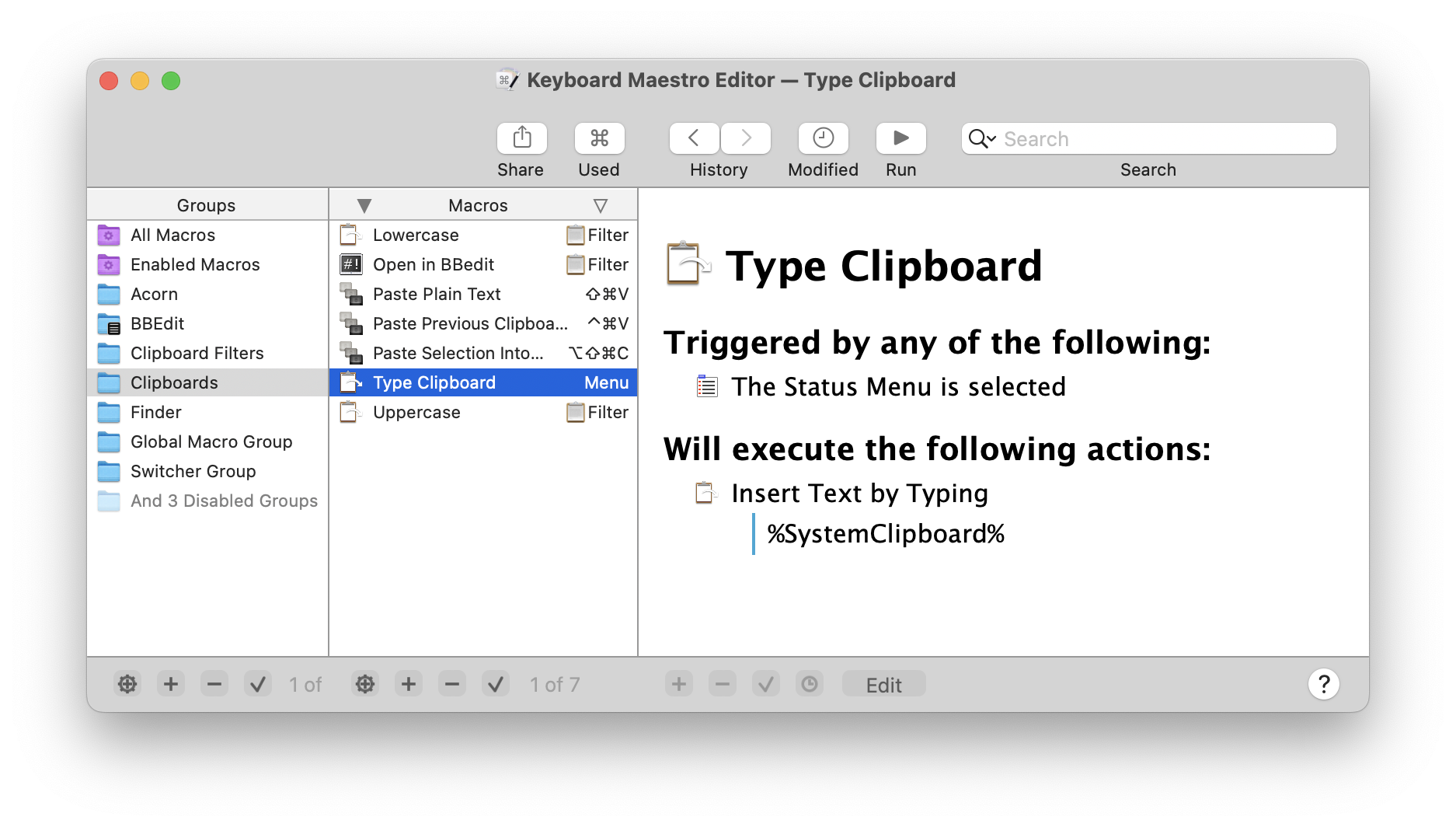
Macro Editor
Dark Mode
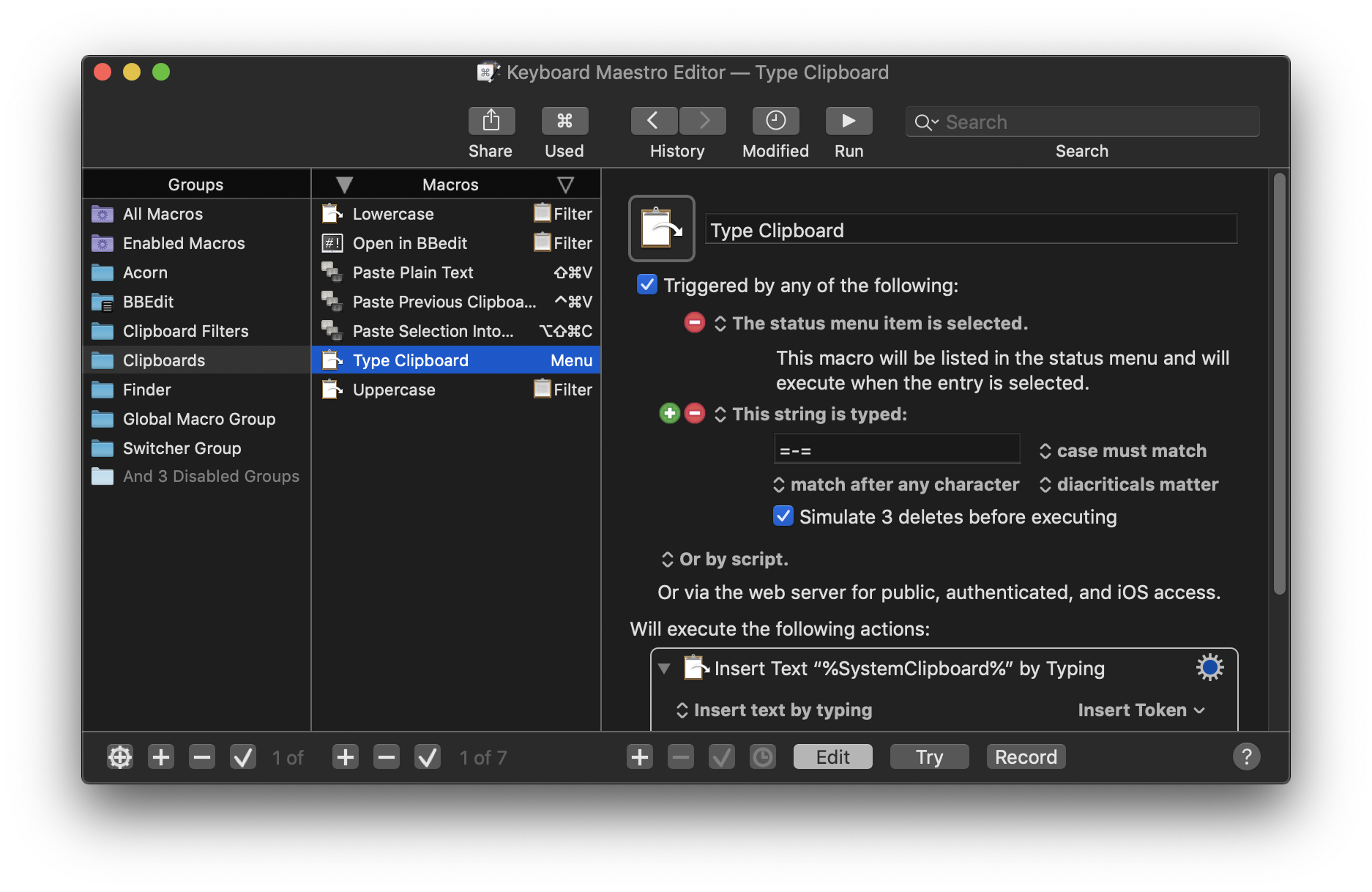
Interactive Help
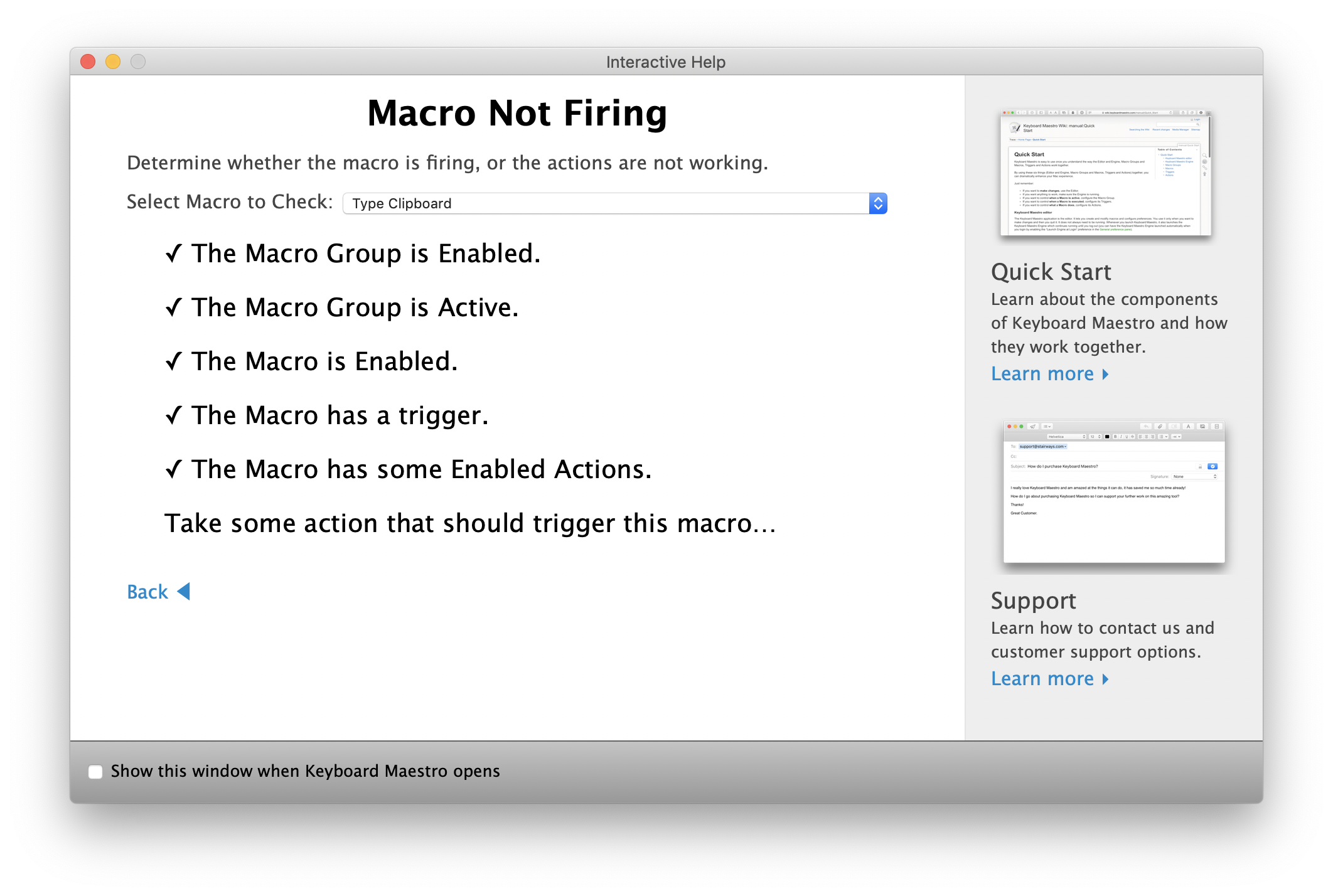
Macro Library
Icon Chooser
Palette Theme Editor
Macro Debugger
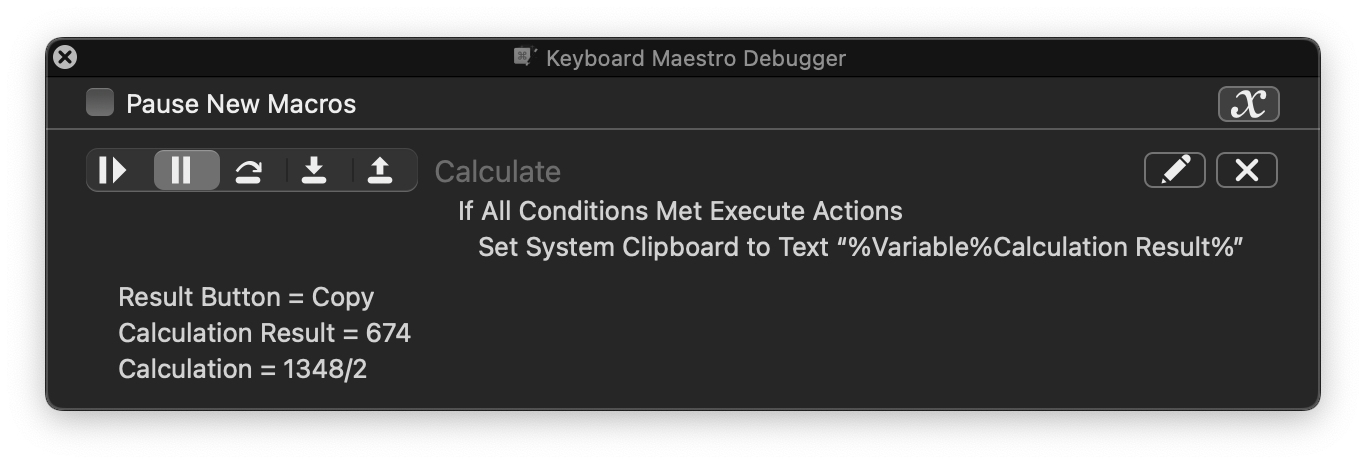
Application Switcher Window
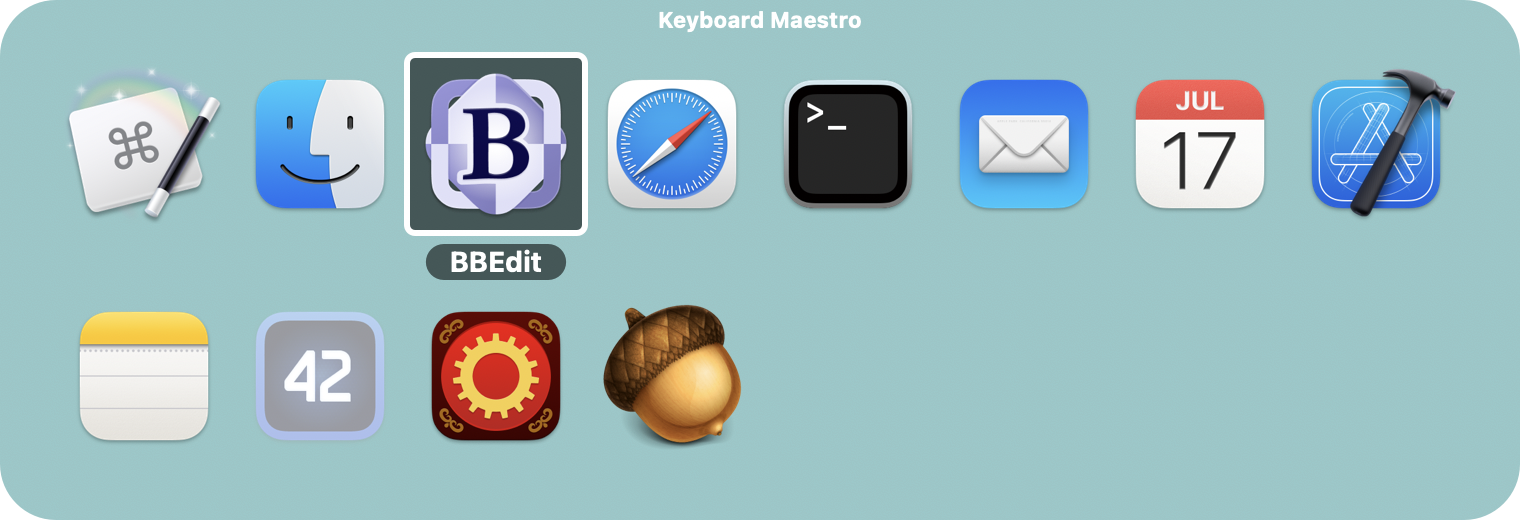
Trigger Macro by Name
Clipboard History Switcher Window
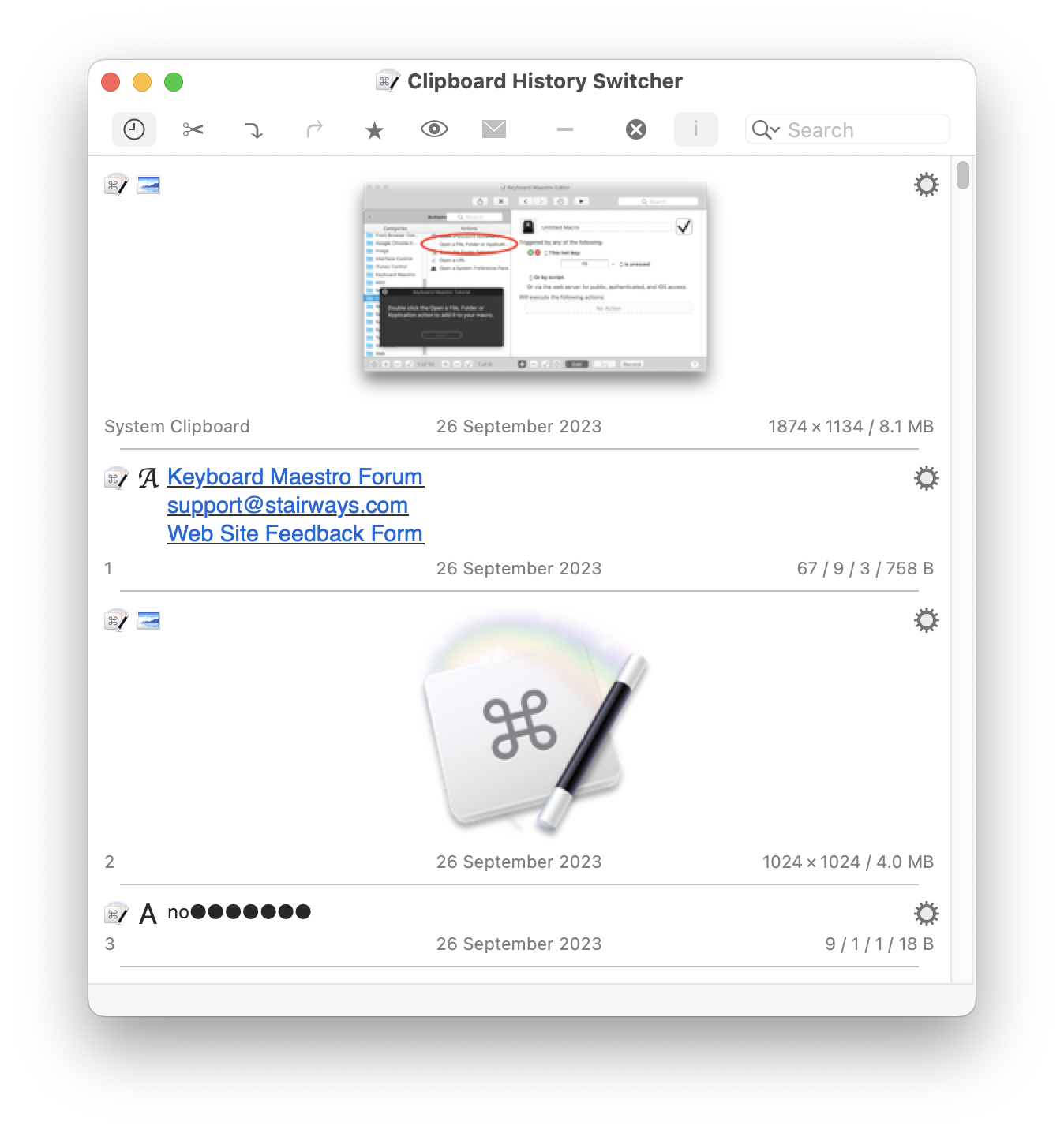
Conflict Palette
Tour
This demonstration will begin to show you the power and versatility of Keyboard Maestro.
Getting Started
To start, launch Keyboard Maestro. It will initially display the Welcome window.
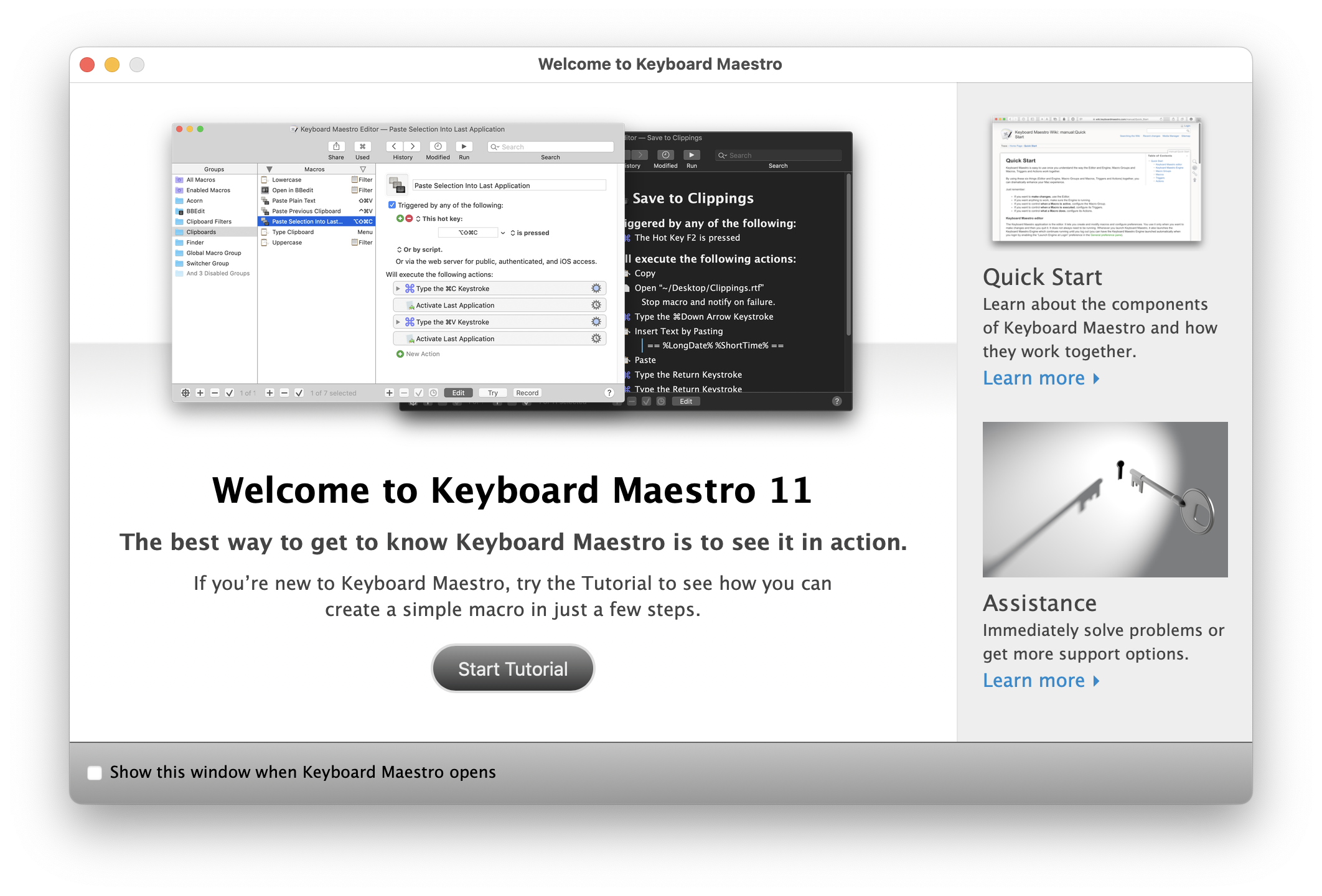
If you are new to Keyboard Maestro, start the tutorial and Keyboard Maestro will show you how easy it is to create a macro.
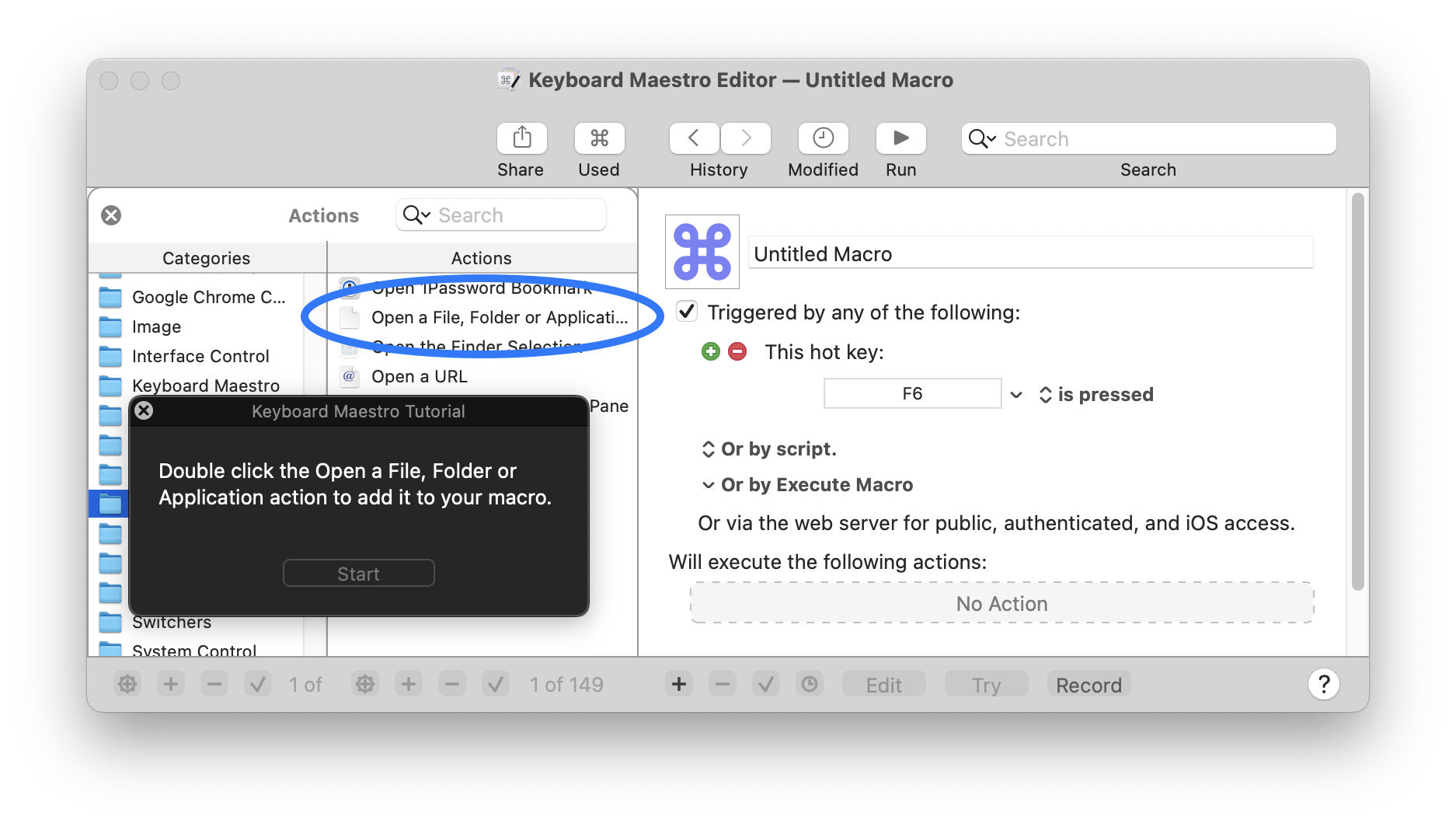
Close the Welcome window to display the Macros window.

You can see some example Macros we have included for you.
Make New Macro
Click the + button under the Macro column to add a macro and display the Macro Editor window. We will now design a complex Macro enabling you to save clippings to a text file. First, launch TextEdit and create a new empty document. Save this blank document as Clippings.rtf in your Desktop folder.
Normally, to add a selection to the Clippings.rtf file, you would have to do all this:
- Press Command-C to copy the selection in an application.
- Go to the Finder, open your Desktop folder, then open the Clippings.rtf file.
- Go to the end of the file in TextEdit.
- Press the Return key and type a line of dashes and return to separate the clippings.
- Press Command-V to paste the selection you made before.
- Save the file and close the document.
- Switch back to the application where you originally selected some text or a picture.
That is all very tedious, and probably explains why most people never even bother with such an operation.
So let’s define the whole sequence as a Macro.
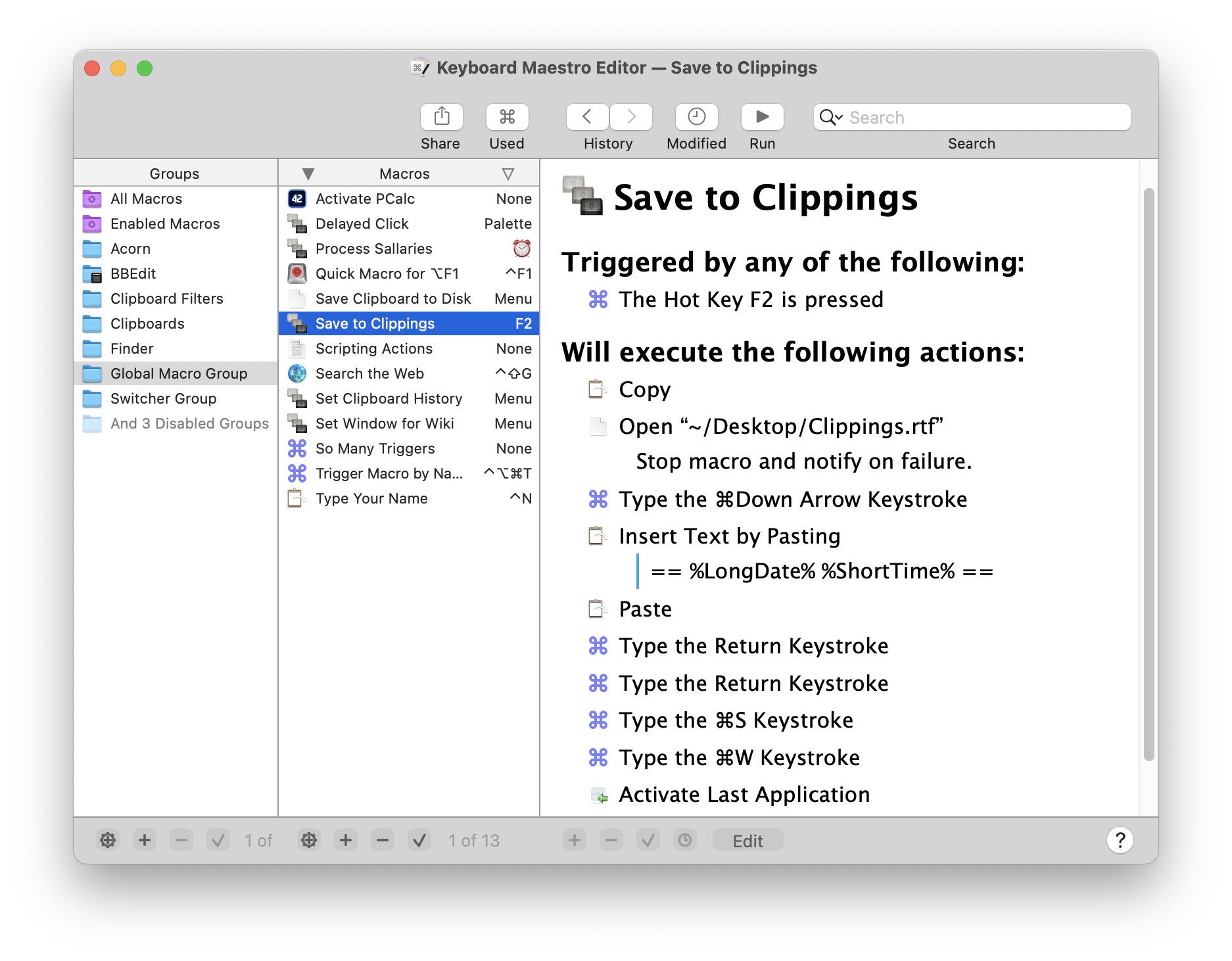
Now any time you have some text you want to save, just select it and press F2 (or Fn-F2 depending on the state of the Use all F1, F2, etc. keys as standard function keys preference in the System Preferences). What used to be too much hassle to bother with is now done in seconds!
Clipboard History
Keyboard Maestro automatically remembers your clipboard history, saving a copy of each new clipboard item as you copy it. You can then paste any previous clipboard using the defined Hot Key (by default, Command-Control-Shift-V).
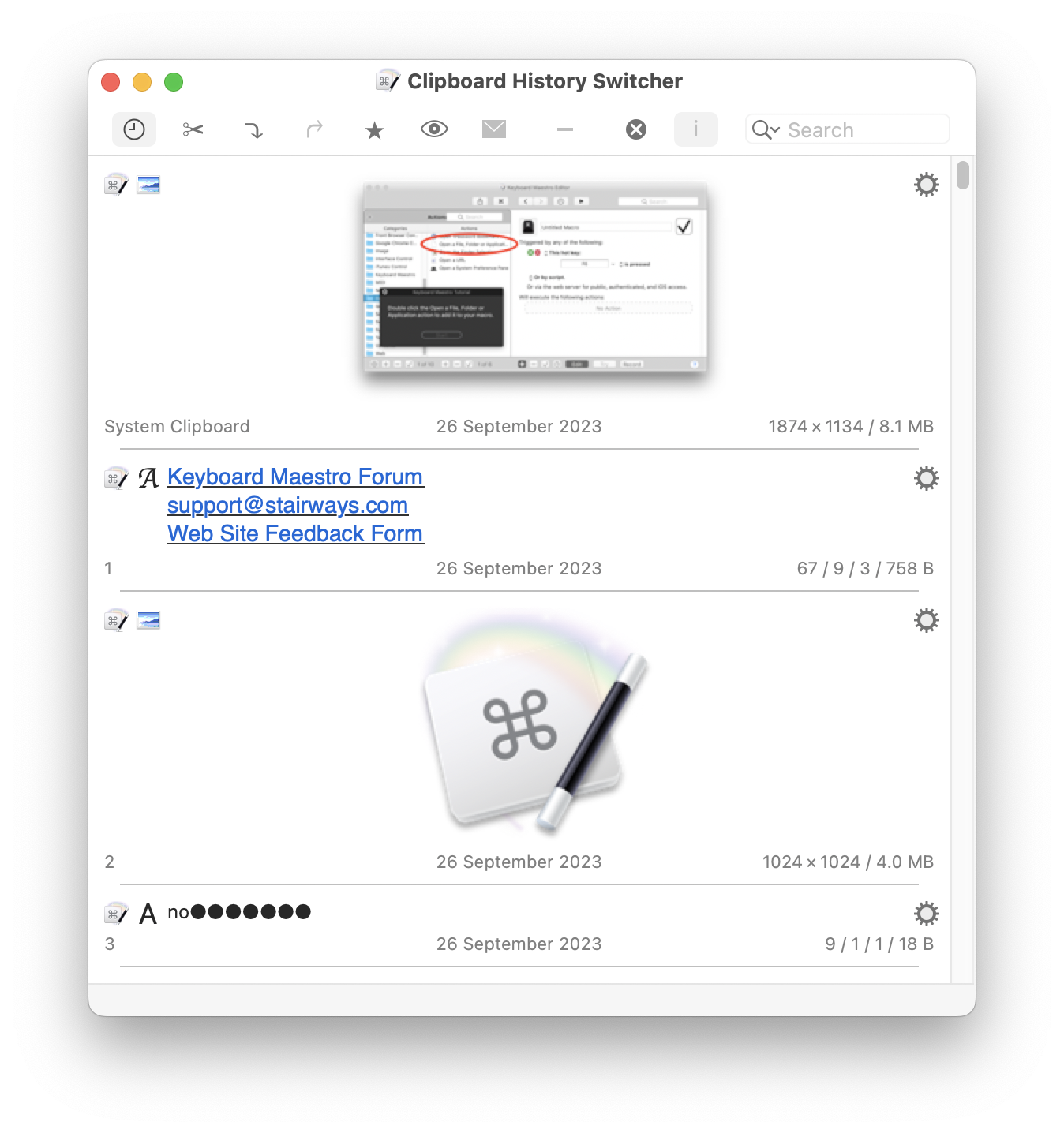
Another advantage of the Clipboard History is you can leave the window open (by toggling the Close After Action (x) button) and paste previous clipboards by simply double clicking the desired item. This is particularly helpful when you need to copy many items in many places to be pasted into one application. Hold down the shift key to paste without styles.
Keyboard Maestro can even save your clipboard history across restarts and log outs. Just enable the “Save Clipboard History to Disk” preference in the General preference pane.
Named Clipboards
For more permanent information, Keyboard Maestro lets you create as many named clipboards as you want using the Clipboards preference pane.
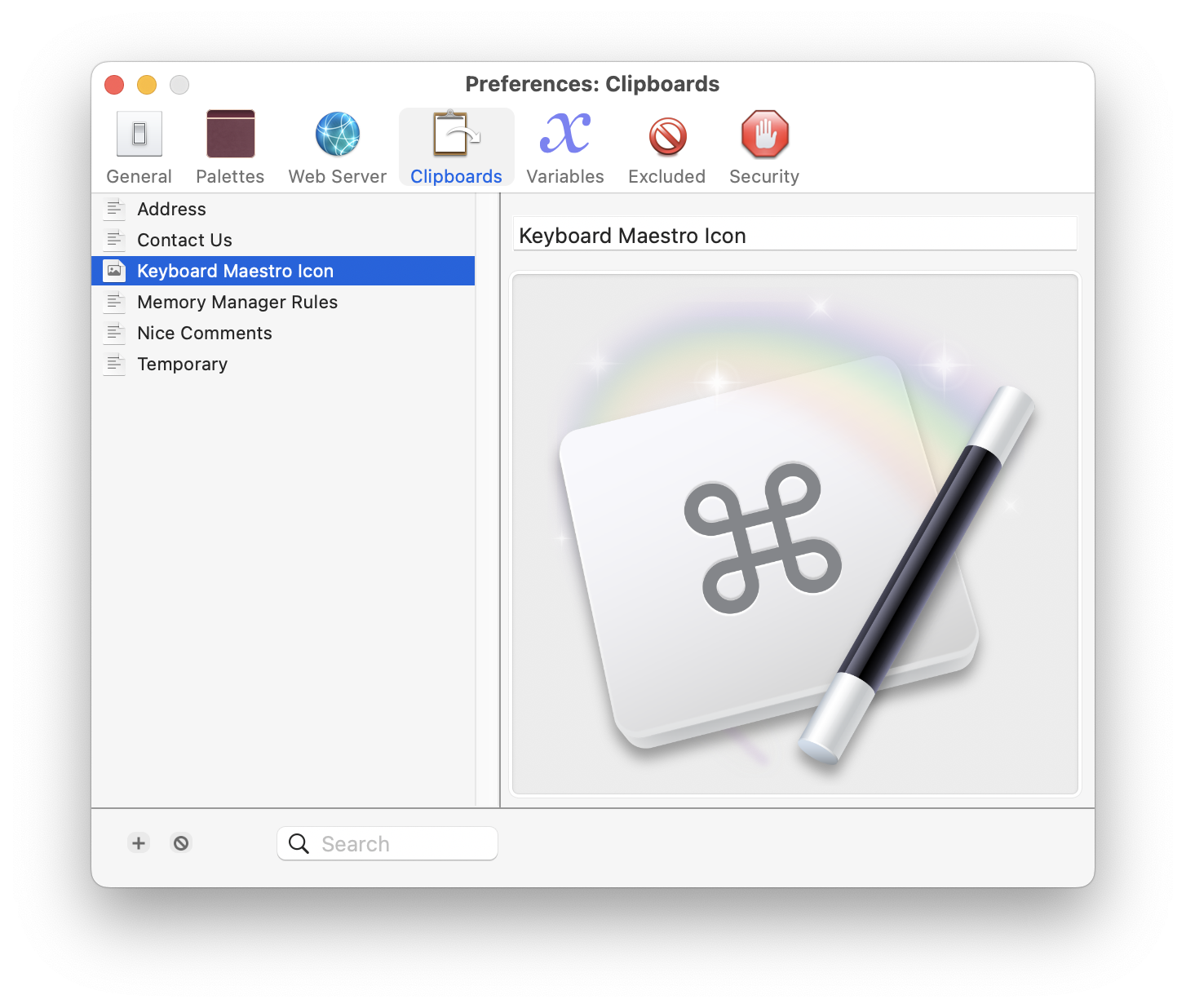
Named clipboards let you save frequently used information, like your company logo, timely information like a customer’s address, or your address so you never have to type it again. This allows you to paste the saved information whenever you want, wherever you want.
Then you can cut, copy or paste to/from the named clipboards using the defined Hot Keys (by default, Command-Shift-X, C and V respectively, but you can change them, too).
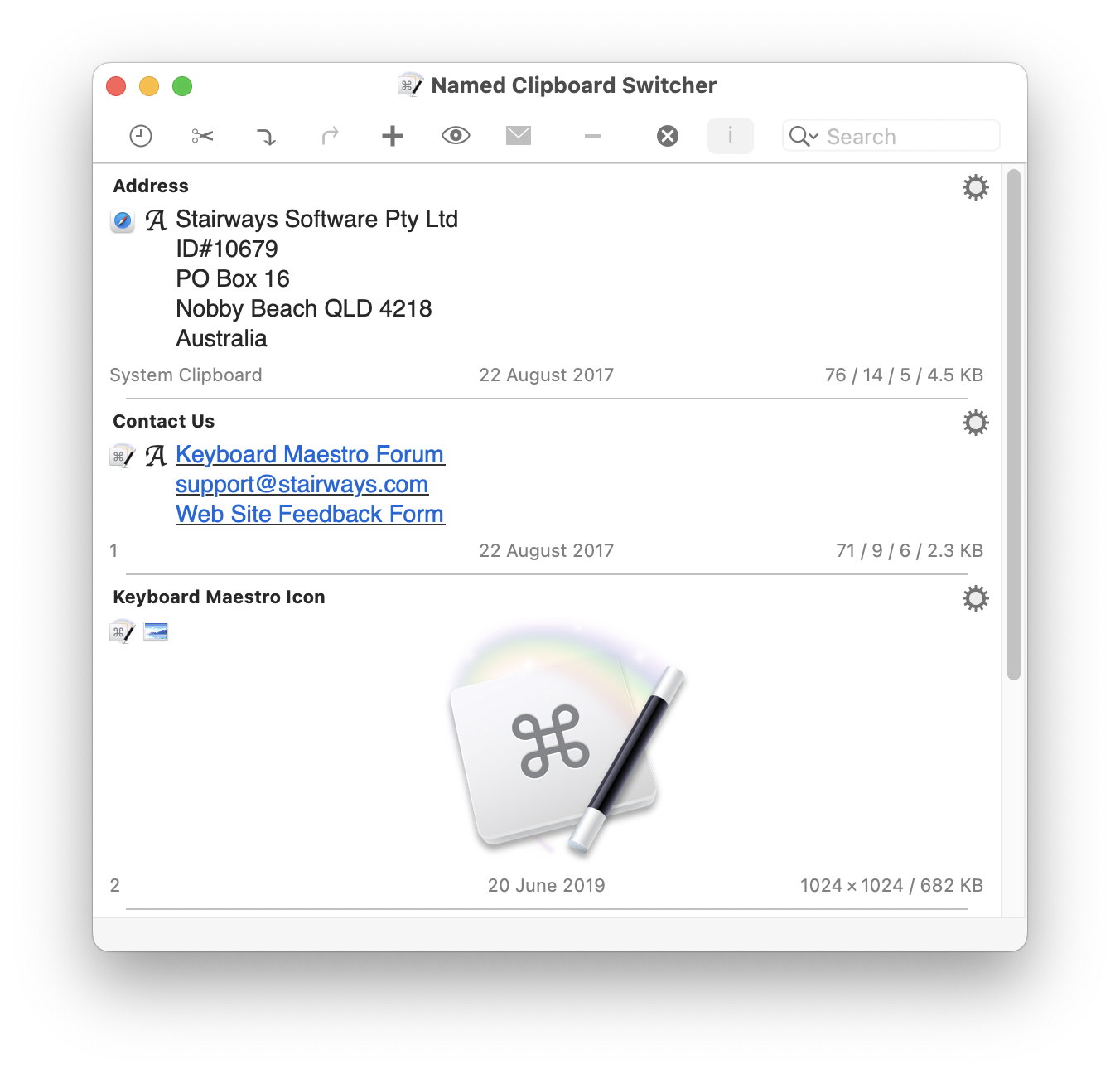
If you have a large screen, or a specific job that needs it, you can have the window stay open (by toggling the Close After Action (x) button) and copy or paste named clipboards easily.
Application Switcher
At the end of the Macro we defined, we used the Switch To Last Application action to switch back to the application you were using before. But most of us use a lot more than one application and we need to be able to switch between them, whether or not the application is already open. You can do more than just switch between applications with Keyboard Maestro: it lets you define applications that always appear when you are switching so you can launch them quickly, and also Excluded Applications that you never want to see. As well, you can quit, hide or show applications. The Application Switcher is activated like any other macro, so you can find it in the Switcher Group in the Macros window. By triggering the Application Switcher macro (for example by entering the default Command-Tab key trigger, though this can be changed) you can display the Application Switcher window.
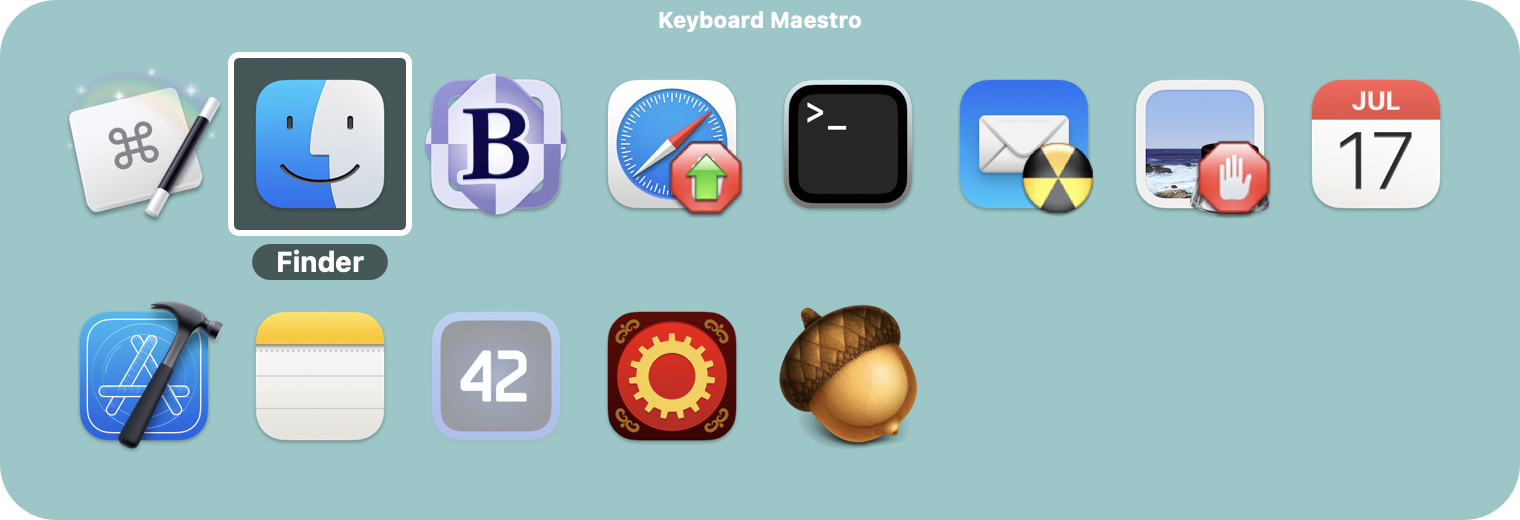
Note the applications set to be launched or quit.
If you want a specific keystroke to always launch a certain application, you can define a Macro to do that. For example, you could create a Macro with a Hot Key Trigger of F3 so it always activates Safari.
Window Switcher
Keyboard Maestro also includes a Window Switcher. By triggering the Window Switcher macro (for example, by pressing Control-Tab), the Window Switcher window appears showing all the windows of current application (in the current space).
Note the windows set to be closed. This is a very useful way of cleaning up an application with a lot of open windows.
Conduct Your Mac Like a Pro!
This is just a taste of all that Keyboard Maestro can do for you. It’s time you started getting the most from your Mac! Download Keyboard Maestro today and you can be working faster and smarter in no time.
Links
Download Keyboard Maestro from https://download.stairways.com/.
Purchase Keyboard Maestro at https://purchase.stairways.com/.
Look up your current or previous license status and serial numbers, and get information about discounted upgrades from https://enquiry.stairways.com/.
Join the Keyboard Maestro Forum online community consisting of the developers and Keyboard Maestro users at https://forum.keyboardmaestro.com/.
Documentation describing Keyboard Maestro is available at https://documentation.keyboardmaestro.com/.
A wiki containing additional information, macros and other resources for Keyboard Maestro is available at https://wiki.keyboardmaestro.com/.
For sales enquires, customer service, technical support, or to contact project management, our current contact information is listed at https://contact.stairways.com/.
For more information about anything to do with Keyboard Maestro visit https://www.keyboardmaestro.com/.
Quick Start
Keyboard Maestro is easy to use once you understand the way the Editor and Engine, Macro Groups and Macros, Triggers and Actions work together.
By using these six components together, you can dramatically enhance your Mac experience.
Just remember:
- If you want to make changes, use the Editor.
- If you want anything to work, make sure the Engine is running.
- If you want to control when a Macro is active, configure the Macro Group.
- If you want to control when a Macro is executed, configure its Triggers.
- If you want to control what a Macro does, configure its Actions.
Keyboard Maestro editor
The Keyboard Maestro application is the editor. It lets you create and modify macros and configure preferences which are stored on your local Mac. You use it only when you want to make changes and then you quit it. It does not always need to be running. Whenever you launch Keyboard Maestro, it also launches the Keyboard Maestro Engine which continues running until you log out (you can, and should, have the Keyboard Maestro Engine launched automatically when you login by enabling the “Launch Engine at Login” preference in the General preference pane).
Keyboard Maestro Engine
The Keyboard Maestro Engine is a background only application that performs all of Keyboard Maestro’s features. It responds to your Hot Key presses, watches the time, tracks applications and maintains your clipboard history, handles receiving clipboards, displays palettes, and, of course, executes your Macros. It should be running at all times, so we recommend you enable the “Launch Engine at Login” preference in the General preference pane.
Macro Groups
Keyboard Maestro allow you to organize your Macros into Macro Groups which are like folders of macros. Each Macro Group controls when the macros it contains are active. A Macro Group can target or exclude specific applications, which means the macros it contains will only be active in those desired applications. For example, you can have macros which are active only in Mail.app, or only in Mail.app when a compose window is open.
A Macro Group can also act as a container for specific-use macros which are available to be triggered only when you specifically activate them. For example, you could create a Macro Group containing macros that resized or repositioned windows using the arrow keys, but those macros would only be active after a specific Hot Key was pressed so that the arrow keys could be used normally at other times.
Macro Groups can be displayed as palettes, allowing you to create your own custom toolbars which can be configured with a variety of themes.
Macro Groups can be displayed in the menu bar, allowing you to show updating information in the menu bar, and quickly access the macros it contains.
You create a Macro Group by clicking the + button at the bottom of the Macro Groups list. You can disable or enable Macro Groups by clicking the ✓ button. You can configure a Macro Group by selecting it and clicking the Edit button, or by double-clicking on it.
You can also create Smart Groups, which are essentially saved searches and will show you any macros that match any of the set of search criteria.
Macros
Keyboard Maestro’s main purpose is to execute Macros. A Macro lives in a Macro Group and consists of a set of Triggers that determine when the macro is executed, together with a list of Actions that define what the macro does when it is executed. You create a Macro by clicking the + button at the bottom of the Macros list or by clicking the ⊕ which will let you quickly create a simple back by giving it a name, selecting a macro group, and choosing a common trigger and action. Either way you can add or edit triggers and actions later. You can disable or enable Macros by clicking the ✓ button. Keep in mind that a Macro can only be active when the Macro Group that contains it is active. You can edit a Macro by selecting it and clicking the Edit button, or by double-clicking on it. There is no Save in Keyboard Maestro, your macros are always saved a few seconds after you make any changes.
A macro is available to be triggered only if it is enabled, and it’s parent macro group is enabled and active.
Triggers
A Trigger defines when a macro will be executed. There are a variety of Triggers available, the most common is the Hot Key trigger which executes the macro when a specified Hot Key is pressed. Similarly, you can use a Typed String trigger to execute a macro when you type some text (for example =addr=). Other common triggers are the Macro Palette which lets you trigger a macro by clicking on a context (front application or window) sensitive floating palette of macros and the Status Menu trigger which displays the macro in the Status Menu. You can trigger macros from the clipboard history (to apply to the clipboard entry), or by drawing a shape with the mouse or trackpad.
You can also trigger a macro when you login or when your Mac sleeps or wakes or goes idle, at a specific time or on a specific day, when an application launches, activates or quits, by executing a script, or remotely using a web browser or iPhone or our trigger server. And you can trigger a macro when something changes, like a volume being mounted or unmounted, plugging in headphones, connecting a monitor, a USB device, or to a wireless network.
A Trigger will only execute the macro if the Macro is enabled and the Macro Group is enabled and currently active. You create Triggers by creating or editing a Macro and clicking the green + button near the top of the macro detail view.
Actions
When a Macro is Triggered it executes a list of Actions. Keyboard Maestro performs each of the Actions in order. There are a wide variety of Actions allowing you to control applications, simulate user interface events like key presses, mouse clicks and menu selections, work with files or images, control your Mac or the clipboard, or display a variety of powerful switchers (Application, Window, Clipboard and Clipboard History Switchers). You can also execute a script (AppleScript, Java, Swift, shell Script or Automator Workflow) or even download or create your own custom plug in actions. There are many, many more actions, so if you can do it yourself, Keyboard Maestro can probably do it for you. You create Actions by creating or editing a Macro and clicking the + button to display available actions, or by clicking on the Record button and performing the action while Keyboard Maestro records your actions to your Macro.
Assistance
If you have any problems writing macros, you can get help from a number of places.
- This User Manual describes the basics of using the Keyboard Maestro editor.
- The Tutorial will show you how to create a simple macros. You can start the Tutorial by choosing the Help ➤ Tutorial menu.
- The Quick Start describes the components of Keyboard Maestro and how they work together, and it is important to understand these basics to get the most out of Keyboard Maestro.
- The Wiki includes lots of information on all aspects of Keyboard Maestro.
- The Forum is a great place to ask for help with macros.
- Each action in Keyboard Maestro includes a Help option in the ⚙ menu at the top right of the action.
- Holding down the option key while choosing from the new trigger menu will get you help on the triggers.
- Holding down the option key while choosing from the new condition menu will get you help on the conditions.
- Holding down the option key while choosing from the new collection menu will get you help on the collections.
And last but not least, you can ask Keyboard Maestro itself for assistance by choosing Help ➤ Interactive Help menu.
In particular, the Interactive Help window can help you:
- if something is happening that you do not expect — Keyboard Maestro can show you what it is doing.
- if a macro is not doing anything — Keyboard Maestro can help you to learn why.
How do I ...?
How do I install Keyboard Maestro?
To install Keyboard Maestro, download it and then use the Finder to move it to your Mac’s Applications folder (or anywhere you like).
Note: You must use the Finder to do this since the Finder will turn off Apple's App Translocation security feature when you move the application.
When you launch Keyboard Maestro it launches an invisible “Keyboard Maestro Engine” that continues to run even after you quit Keyboard Maestro. The engine is the process that enables your Macros, Application Switcher, and Clipboard History Switcher to work. This means that they will continue to work after you quit Keyboard Maestro, as long as the engine is still running.
You can quit or launch the engine manually using the File menu.
You should consider turning on the “Launch Engine at Login” preference in the General preference pane to ensure all of Keyboard Maestro’s facilities are available to you as soon as you login or startup your Mac.
How do I upgrade Keyboard Maestro?
Keyboard Maestro includes an automatic upgrade mechanism, so to upgrade Keyboard Maestro simply click the Install Update button when prompted.
To upgrade Keyboard Maestro manually, quit the engine by choosing the File ➤ Quit Engine menu, and quit the editor, and replace the Keyboard Maestro application in your Applications folder with the new one. Finally, launch Keyboard Maestro to restart the engine.
Keyboard Maestro will automatically import your previous version macros, clipboards and preferences. Your old macros will be saved in the ~/Library/Preferences/Keyboard Maestro/Keyboard Maestro Macros Saved Version 10.plist in case you wish to revert to version 10 for any reason.
If you are upgrading directly from a much older version, you will get better results by upgrading to the last of each major version in turn, ie, run 2.1.3, then 3.5, then 4.3.2, then 5.3.2, then 6.4.8, then 7.3.1, then 8.4.2, 9.2, 10.2, and then the current version. You can download old versions from our file archive.
How do I purchase Keyboard Maestro?
New customers can purchase Keyboard Maestro for US$36 by choosing the Keyboard Maestro ➤ Purchase Keyboard Maestro menu. If you own a previous version of Keyboard Maestro and it is already registered, you can purchase the upgrade at a discount by choosing Keyboard Maestro ➤ Purchase Keyboard Maestro Upgrade menu. Customers with ten or more users should contact us for a volume discount quote.
You can look up your current or previous license status and serial numbers, and get information about discounted upgrades from https://enquiry.stairways.com/.
Thanks for supporting us and enabling us to continue work on Keyboard Maestro.
See also the Purchase section.
Can I purchase Keyboard Maestro from the Mac App Store?
Keyboard Maestro will not be available on the Mac App Store. Apple requires applications on the Mac App Store to be Sandboxed, and workflow applications like Keyboard Maestro cannot be sandboxed so it is excluded from the Mac App Store.
See also the Purchase section.
How do I register Keyboard Maestro?
When you purchase Keyboard Maestro you will be given a serial number, and will also promptly be emailed your username (email address) and serial number in the “Thanks For Your Purchase” email. Although you can retrieve this information from us at any time in the future, it is a good idea to keep this safe.
If you do not receive your serial number promptly after purchasing, it may be that the email has not reached you, possibly due to spam filtering on your email service. In this case, try looking up your purchase at https://enquiry.stairways.com/ (although that will email you your serial number which might again be lost to over-zealous spam filters).
Once you have your username (email address) and serial number, launch Keyboard Maestro and either immediately click the Use Existing License button or choose Keyboard Maestro ➤ Register Keyboard Maestro menu and then enter the username (email address) exactly as shown and the serial number exactly as shown and click the OK button. If you have any problems, recheck that the email address and serial number you are entering are exactly as shown (the serial number’s email address does not change even if you have changed your email address with us) and also that your license matches the major version number (eg, a version 10 license will work with version 10.x of Keyboard Maestro).
If you are already registered, the Register Keyboard Maestro menu will show you the registration details in the About Keyboard Maestro window — if it says it is registered to you, you are all set.
How do I get started?
The first thing to do is to read the Quick Start and do the tutorial by choosing the Help ➤ Tutorial menu. You may also want to subscribe to our Getting Started emails (Keyboard Maestro will ask you to subscribe or you can do that at your customer database page on our web site).
The best way to start using Keyboard Maestro is to start simple and then grow your macros organically. Simple things might include:
- launching or switching to a particular application.
- opening a particular document.
- typing a specific string of text (eg your name, address, etc).
You may also like to joint the forum (https://forum.keyboardmaestro.com/) and ask for help with any macros you get stuck on. The forum is a fantastic resource, and if you are having troubles building a specific macro, the forum is the first place you should go to ask for help since we frequently cannot help with macros for specific applications that we probably don't have access to.
If you would really like to extend your use of Keyboard Maestro, consider enrolling in David Spark’s Keyboard Maestro Field Guide.
Then use your Mac normally and keep an eye out for things you do repetitively.
When you notice something, think about making a Macro to do it and assigning it to a Hot Key or Global Macro Palette or Status Menu trigger.
Try to be consistent with your Hot Keys, for example you might have a set of applications you open, using a function key for each, and a set of documents you open, using a Control-Function Key combination for each of them, and a bunch of snippets of text your type, using Control-Letter for each of them (the letter could be a mnemonic to help you remember which one is which). Consider putting a sticker on your keyboard across the top of your function keys to help you remember which ones do which function. Remember that you can use the number pad keys as well.
Also, keep in mind common command keys and system defined hot keys and try to avoid conflicting with them.
And remember that you can give a bunch of macros the same hot key trigger and Keyboard Maestro will ask you which one you want to use when you press the key.
See also the Tips section.
How do I create a new Macro?
If you have not done so, use the tutorial by choosing the Help ➤ Tutorial menu to lead you through the process of creating a simple macro.
To create a Macro, launch Keyboard Maestro and select the Global Macro Group, then click the + button under the Macros list. Give the Macro a name, add one or more triggers, and one or more actions. The Macro is immediately active — you do not need to stop editing, quit the editor or anything else.
An easy way to generate macro actions is to turn on recording and proceed to show Keyboard Maestro what you want to do. Then turn recording back off and look through the actions — chances are you will want to delete or adjust some of the recorded actions to make a robust macro, but this will give you a quick start on creating the macro.
How do I find a Macro I've used or modified recently?
You can sort the macros by name, by trigger, by date created, modified or used. So if you launch Keyboard Maestro, select the All Macros smart group, and then choose the View ➤ Sort Macros by Date Modified menu (or choose the View ➤ Sort Macros by Date Used menu) to sort the recently modified (or used) macros to the top.
You can also click the ◷ button above the macro editor pane to select from recently modified macros, or use the ⌘ button to select from recently used macros.
How do I cancel a running Macro?
You can cancel all running macros by holding all the modifiers (Control, Option, Shift and optionally Command) and clicking on the Keyboard Maestro Status Menu Icon.
You can cancel a specific macro by choosing from the Status Menu ➤ Cancel menu and selecting the macro. This is also a useful way of seeing what macros are currently running, if any.
You can also see and cancel macros by choosing the Status Menu ➤ Start Debugging menu.
And finally, you can use the Cancel All Macros, Cancel Other Macros, Cancel This Macro, or Cancel Just This Macro actions.
In desperation, you can quit the Keyboard Maestro Engine from the status menu or Safe Boot the Mac to restart it without launching any applications, and then you can launch the editor while holding all the modifiers down to quit all running engines.
How can I get the mouse coordinates on the screen or in a window?
If possible, you should avoid using mouse click actions. They tend to be very fragile, easily broken by subtle changes to the system or applications. And they also require the screen to be in the expected state, so you usually need to add a Pause action before them to ensure the item they are clicking on is where it is expected to be.
That said, you can use the Mouse Display window by choosing the Window ➤ Mouse Display menu which will let you see the mouse coordinates relative to the window or main screen. Click the lock button to lock the display after a few seconds, and then put your mouse over the desired location. You can then change the relative corner, and click the Clipboard buttons to copy the coordinates.
Alternatively, you can simply record the click. Turn on recording in Keyboard Maestro, go to where you want to be, wait a couple seconds for the screen to be stabilised so the click will be relative to the front window, and click. Turn off recording, delete any extraneously recorded actions and you have your coordinates. Immediately after recording you can adjust the relative corner of the window or screen, and the recorded coordinates will adjust to match.
Remember that offsets are always to positive to the right and positive down, so if you are making a mouse click up from bottom edge of a window or screen, or left from the right edge of a window or screen, you will need to use negative coordinates.
How do I insert styled/colored text or images?
You can use the Insert Text action to insert styled text by pasting.
You can insert an image by copying it to the clipboard and then pasting it in using the Paste action (which just types the Command-V keystroke).
You can get your image from a Named Clipboard, or by reading an image file.
Here is how to create a Macro to insert an image when you press a Hot Key.
- Create a macro (see the How do I create a new Macro? section) with the Set Clipboard to Image action.
- Paste your image in to the action, or have the action read the image from a file or Named Clipboard.
- Then use the Paste action to paste your image.
Name the macro, and assign it whatever trigger you desire.
Now whenever you trigger the macro you just created, your image will be pasted in.
How do I Insert the current date?
You can insert text using the Insert Text action, and it processes Tokens. There are some basic date format tokens (such as the %LongDate% token), or you can use the %ICUDateTime% token with any ICU date format.
How do I get more than one Macro Palette (Toolbar)?
There are three kinds of palettes in Keyboard Maestro:
- There is one “Global Macro Palette” which includes any active macro that has the Macro Palette trigger. It appears whenever there is any active macro with the Macro Palette trigger. It shrinks to the size of an icon until you hover over it and then it expands to display the currently active macros with Macro Palette triggers. You can show and hide it using specific Macro Palette actions.
- Each Macro Group can be displayed as a palette. The macro group can be global to all applications, or specific to any subset of applications. It can be toggled on and off with a hot key (or a status menu selection or from the Global Macro Palette) or it can be displayed for a single action. Actions can hide or show the macro group palettes.
- When a hot key (or typed string or device key) conflicts (ie, triggers more than one macro), the Conflict Palette appears which lets you select from the conflicting macros. This can be an easy way to allow a single hot key to offer a multitude of similar actions. You can then use number keys or the mouse to select the desired hot key, or can use other keys to filter the palette until only one macro remains.
So to have more than one macro palette, create a macro group for each desired palette and configure it to show a palette as desired. Put your macros in there. Create as many of these as you like. The macros in such a macro group are only active while the palette is displayed, so if you only display it occasionally, especially only for one action, then they can have very simple hot keys (like plain letters for example).
You can control the order of macros in a macro palette (or the status menu) by prefixing their name with two characters and a closing parenthesis (eg “01)” - two characters and a closing bracket). The macros will be sorted based on the code, but the code will be stripped off before display in the palette (or status menu).
How do I use a multiple keystroke trigger?
You can assign the same hot key to multiple macros, and Keyboard Maestro will display a palette of the conflicting macros when you press that hot key allowing you to select the desired macro. You can select a macro from the palette using either number keys, or by typing the first distinct character to filter the macros down until only one is left. This is especially useful when you have a variety of similar or related tasks. You can also assign a hot key to a macro group which can activate it for one action (with or without a palette), and the contained macros can have whatever ”second” hot key you desire.
But Keyboard Maestro does not directly support assigning a two-keystroke hot key to a trigger. The problem with multiple keystroke triggers like Option-F R is what to do if you type Option-F A? Logic dictates that the Option-F A should go through to the system unimpeded, but Option-F R should be swallowed entirely. But this is impossible. The only way to do it would be to swallow the Option-F key, and then swallow the second key and then resubmit the Option F and the second key unless it matches Option-F R.
However, that is fraught with peril and cannot work robustly in the presence of other applications placing things on the keyboard event queue (or even a sufficiently fast typist).
For example, suppose you quickly typed Option-F A B. Keyboard Maestro would have swallowed the Option F and then the A, and then resubmitted it to the event queue, resulting in the stream of characters B, Option-F, A. There is no way to avoid this race condition, and as such Keyboard Maestro does not support any such mechanism.
As described above, Keyboard Maestro has a variety of ways you can use Option-F as a hot key that allows a second key to be used to select a macro. However in all cases it is clear that the Option-F has been used and there is no concept that the Option-F might come back later to do something else.
How do I configure the Application Switcher?
The Application Switcher (and all the switchers) are activated by macro actions. Keyboard Maestro creates a default “Switcher Group” Macro Group containing several macros, each macro has a hot key trigger and a matching action which activates the appropriate switcher.
So to configure the Application Switcher, launch Keyboard Maestro, select the Switcher Group, and double click the Activate Application Switcher macro. You can then configure the various Application Switcher parameters, such as style and icon size by configuring the Application Switcher action. You can also configure the hot key used to activate the switcher, or disable the switcher.
How do I backup / migrate / transfer my installation to another Mac?
Your macros are stored on your local Mac in the Application Support folder. So ensure you have good backups of your entire Mac to ensure your macros are safe (good backups are always a good idea!).
If you are going to continue using both Macs, you should use Macro Syncing rather than transferring your information. And indeed you can use Macro Syncing to transfer to a new Mac (even if both Macs wont be on at the same time as long as you preserve the sync file).
To transfer all your information to a new Mac you can copy the ~/Library/Application Support/Keyboard Maestro folder and optionally the ~/Library/Preferences/com.stairways.keyboardmaestro.* files to your new Mac. You can get to ~/Library in the Finder by holding down the shift (or option) key and selecting Library from the Go menu.
Make sure that Keyboard Maestro and Keyboard Maestro Engine are not running on the source or target Mac when you transfer the folder. And make sure the resulting files and folders have the correct ownership and permissions.
If you copy the com.stairways.keyboardmaestro.* files, the new Mac will have the same MacUUID token and be considered the same Mac for syncing purposes, so you should not do this if you intend to continue using the old Mac.
Alternatively, to just transfer the macros, you can turn on Macro Syncing and save the macro sync file anywhere. Transfer it to the new Mac, install Keyboard Maestro as normal, and then turn on macro syncing and select the transferred file to replace your macros. Then turn off macro syncing. This will transfer just the macros, not any settings, variables, or clipboards or the like.
How do I uninstall Keyboard Maestro?
Launch Keyboard Maestro and ensure the “Launch Engine at Login” preference in the General preference pane is turned off. Then choose the File ➤ Quit Engine menu to quit the engine, and then choose the Keyboard Maestro ➤ Quit Keyboard Maestro menu to quit the application.
You can then trash the Keyboard Maestro application from your Applications folder, as well as the preferences in the ~/Library/Application Support/Keyboard Maestro folder and ~/Library/Preferences/com.stairways.keyboardmaestro.* files and logs in the ~/Library/Logs/Keyboard Maestro folder.
How do I revert to a previous version of Keyboard Maestro?
Launch Keyboard Maestro and ensure the “Launch Engine at Login” preference in the General preference pane is turned off. Then choose the File ➤ Quit Engine menu to quit the engine, and then choose the Keyboard Maestro ➤ Quit Keyboard Maestro menu to quit the application. You can then trash the Keyboard Maestro application from your Applications folder.
For version 2, open the ~/Library/Preferences folder and the folder ~/Library/Preferences/Keyboard Maestro/Saved Version 2 folder. Move the files from the latter folder into the former folder. Trash the ~/Library/Preferences/Keyboard Maestro folder. Download Keyboard Maestro 2.1.3, if necessary, from https://files.stairways.com/keyboardmaestro/keyboardmaestro-213.dmg. Move Keyboard Maestro 2 to the Applications folder and launch it. Turn on the “Launch Engine at Login” preference if desired.
For version 3, open the ~/Library/Preferences/Keyboard Maestro folder. Trash the Keyboard Maestro Macros.plist and replace it with the Keyboard Maestro Macros Saved Version 6.plist. Download Keyboard Maestro 3.5, if necessary, from https://files.stairways.com/keyboardmaestro/keyboardmaestro-35.zip. Move Keyboard Maestro 3 to the Applications folder and launch it. Turn on the “Launch Engine at Login” preference if desired.
For version 4, open the ~/Library/Preferences/Keyboard Maestro folder. Trash the Keyboard Maestro Macros.plist and replace it with the Keyboard Maestro Macros Saved Version 6.plist. Download Keyboard Maestro 4.3.2, if necessary, from https://files.stairways.com/keyboardmaestro/keyboardmaestro-432.zip. Move Keyboard Maestro 4 to the Applications folder and launch it. Turn on the “Launch Engine at Login” preference if desired.
For version 5, open the ~/Library/Application Support/Keyboard Maestro folder. Trash the Keyboard Maestro Macros.plist and replace it with the Keyboard Maestro Macros Saved Version 6.plist. Download Keyboard Maestro 5.3.2, if necessary, from https://files.stairways.com/keyboardmaestro/keyboardmaestro-532.zip. Move Keyboard Maestro 5 to the Applications folder and launch it. Turn on the “Launch Engine at Login” preference if desired.
For version 6, open the ~/Library/Application Support/Keyboard Maestro folder. Trash the Keyboard Maestro Macros.plist and replace it with the Keyboard Maestro Macros Saved Version 6.plist. Download Keyboard Maestro 6.4.8, if necessary, from https://files.stairways.com/keyboardmaestro/keyboardmaestro-648.zip. Move Keyboard Maestro 6 to the Applications folder and launch it. Turn on the “Launch Engine at Login” preference if desired.
For version 7, open the ~/Library/Application Support/Keyboard Maestro folder. Trash the Keyboard Maestro Macros.plist and replace it with the Keyboard Maestro Macros Saved Version 7.plist. Download Keyboard Maestro 7.3.1, if necessary, from https://files.stairways.com/keyboardmaestro/keyboardmaestro-731.zip. Move Keyboard Maestro 7 to the Applications folder and launch it. Turn on the “Launch Engine at Login” preference if desired.
For version 8, open the ~/Library/Application Support/Keyboard Maestro folder. Trash the Keyboard Maestro Macros.plist and replace it with the Keyboard Maestro Macros Saved Version 8.plist. Download Keyboard Maestro 8.2.4, if necessary, from https://files.stairways.com/keyboardmaestro/keyboardmaestro-824.zip. Move Keyboard Maestro 8 to the Applications folder and launch it. Turn on the “Launch Engine at Login” preference if desired.
For version 9, open the ~/Library/Application Support/Keyboard Maestro folder. Trash the Keyboard Maestro Macros.plist and replace it with the Keyboard Maestro Macros Saved Version 9.plist. Download Keyboard Maestro 9.2, if necessary, from https://files.stairways.com/keyboardmaestro/keyboardmaestro-92.zip. Move Keyboard Maestro 9 to the Applications folder and launch it. Turn on the “Launch Engine at Login” preference if desired.
For version 10, open the ~/Library/Application Support/Keyboard Maestro folder. Trash the Keyboard Maestro Macros.plist and replace it with the Keyboard Maestro Macros Saved Version 10.plist. Download Keyboard Maestro 10.2, if necessary, from https://files.stairways.com/keyboardmaestro/keyboardmaestro-1020.zip. Move Keyboard Maestro 10 to the Applications folder and launch it. Turn on the “Launch Engine at Login” preference if desired.
Editor Window
To edit your macros, launch the Keyboard Maestro application. It will display one or more Editor Windows. If you close the last editor window, the Keyboard Maestro application will quit, but the Keyboard Maestro Engine will continue running to perform your macros. Normally you only launch the Keyboard Maestro editor application when you want to change your macros, and leave only the Keyboard Maestro Engine running normally.
You can create a new editor window by choosing the File ➤ New Editor Window menu.
Window Elements
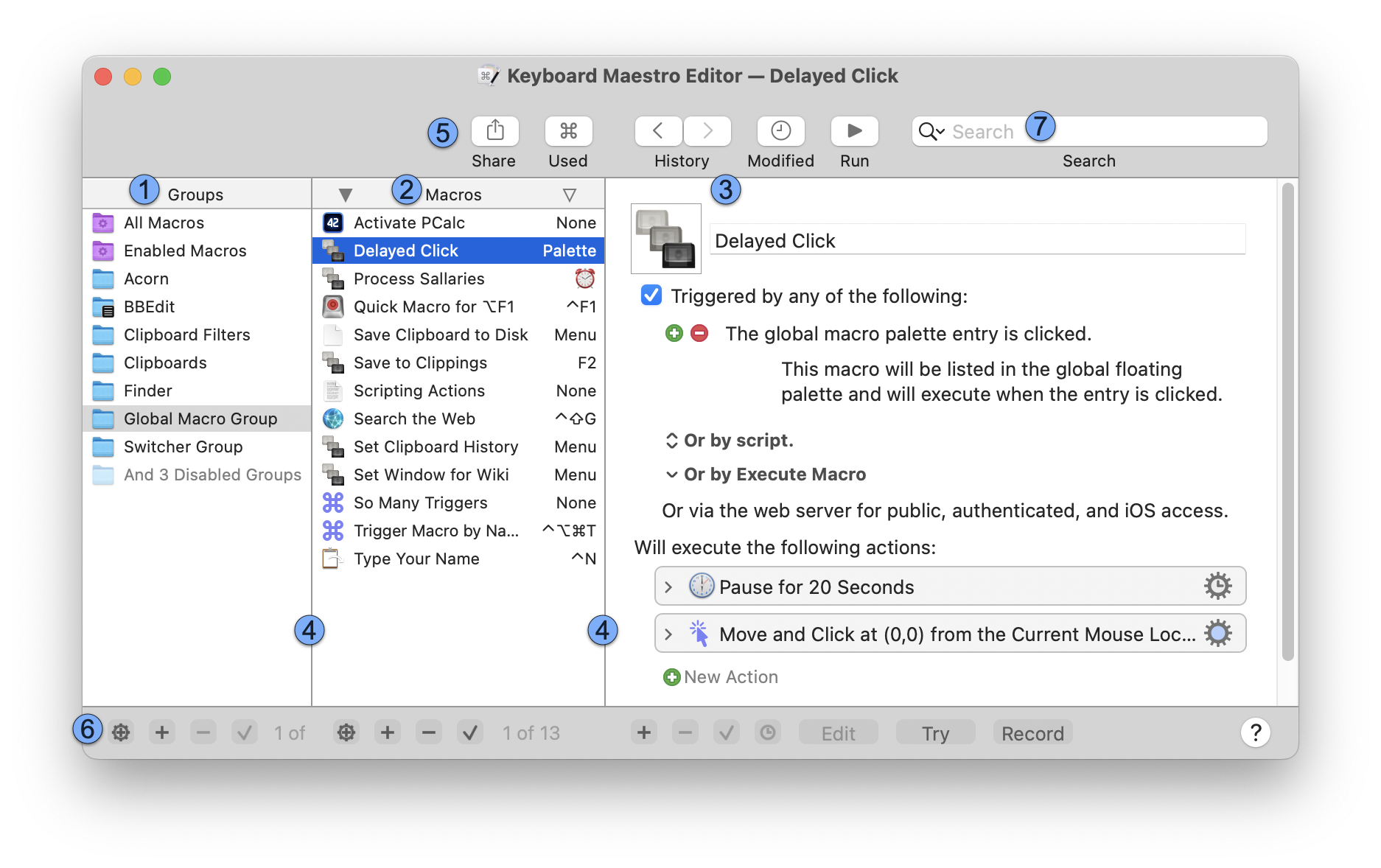
Main Elements
- Groups Column 1️⃣ (on the left)
- List of all of the Smart Groups (top) and Macro Groups in your account.
- Smart Groups are saved searches of macros.
- Macros Column 2️⃣ (in the middle)
- List All of the Macros in the selected groups.
- Macros are the primary way you describe what you want Keyboard Maestro to do.
- You can filter the list to find specific macros by using the Search Field 7️⃣ (upper right corner).
- Details Column 3️⃣ (on the right)
- Display or Edit the details of the selected Macro, Macro Group, or Smart Group.
- This is where you enter the actual details of the selected Macro.
- The layout changes depending on which type is selected. For macros, it includes the name, the enabled state, the triggers and the actions. For macro groups, it includes the name and enable state, as well as details about when and how it is activated or displayed. For smart groups, it includes the name and what macros to show.
- You can resize the columns with the dividers 4️⃣, and double click on them to auto-resize the columns.
- The Toolbar at Top 5️⃣ shows the tools that apply to all macros. See below for details.
- The Toolbar at Bottom 6️⃣ includes tools below each of the columns that apply to each column (so Groups, Macros or the specific Macro). See below for details.
Toolbar at Top

Along the top of the window is the toolbar. From left to right the buttons let you:
- Share 1️⃣ Share your Macros or Actions, including directly to the Keyboard Maestro Forum.
- Used 2️⃣ Select the most recently used (triggered) macros.
- History 3️⃣ Select from the recently edited macro history.
- Modified 4️⃣ Select the most recently edited macro.
- Run 5️⃣ Run the selected macro.
- Search 6️⃣ Search for Macros and Actions.
- Press ⌘F to search Macros only in the selected Macro Group.
- Press ⌘⌥F (or ⌘F a second time) to search all Macros.
- If you enter simple text, it will search for any text in any Action, or Macro Name, that contains that text.
- To better restrict the Search, use Search Strings.
- Tap a modifiers key to enter the corresponding modifier symbol.
- The Macros Column will be filtered to only matching macros.
- Any parts of the macro that match will be highlighted in striped blue in the Details Column.
- If any macros are filtered out, an entry will show at the bottom of the macro column list representing all the hidden macros.
Toolbar at Bottom
![]()
Each column has three common buttons (underlined in the image). These are:
- Create (+)
- Delete (-)
- Enable/disable (✓)
Use them to create or delete or enable/disable Macro Groups, Macros, or Actions respectively.
The remainder of the toolbar includes:
- Groups Column Buttons 1️⃣ including the Create Smart Group button and the common buttons for creating or deleting or enable/disabling macro groups.
- Macro Column Buttons 2️⃣ including the New Macro Wizard button and the common buttons for creating or deleting or enable/disabling macros.
- Details Column Buttons including the common buttons for creating or deleting or enable/disabling actions and:
- Set Action Timeout 3️⃣ for selected action.
- Toggle Edit Mode 4️⃣
- Try the selected actions 5️⃣.
This is for testing Actions, not running the entire Macro.
To test the entire Macro, click the Run ▶︎ Button in the Top Toolbar. - Record button to start Macro Recording 6️⃣
Editing
Edit mode may be toggled on/off by clicking the Edit button on the Bottom Toolbar, or by selecting the menu View > Stop/Start Editing Macros. Note that macros are saved immediately after every change (there is a small “dirty” marker in the bottom right corner of the editor window that shows when the save occurs). There is no need to ever turn off Edit mode, or do anything else to have your macro changes be recognised by the Keyboard Maestro Engine.
Actions
You can add a new action by any of the following:
- Click the New Action button.
- Click the + button at the bottom of the Details Column to display the list of actions.
- Choose the Edit ➤ Insert Action By Name menu.
- Press ⌘⌃A to show a Insert Action By Name Popup.
- Choose from the Edit ➤ Insert Action menu.
Macros
When you are in Edit Mode and you select a Macro, you can edit its behaviour.
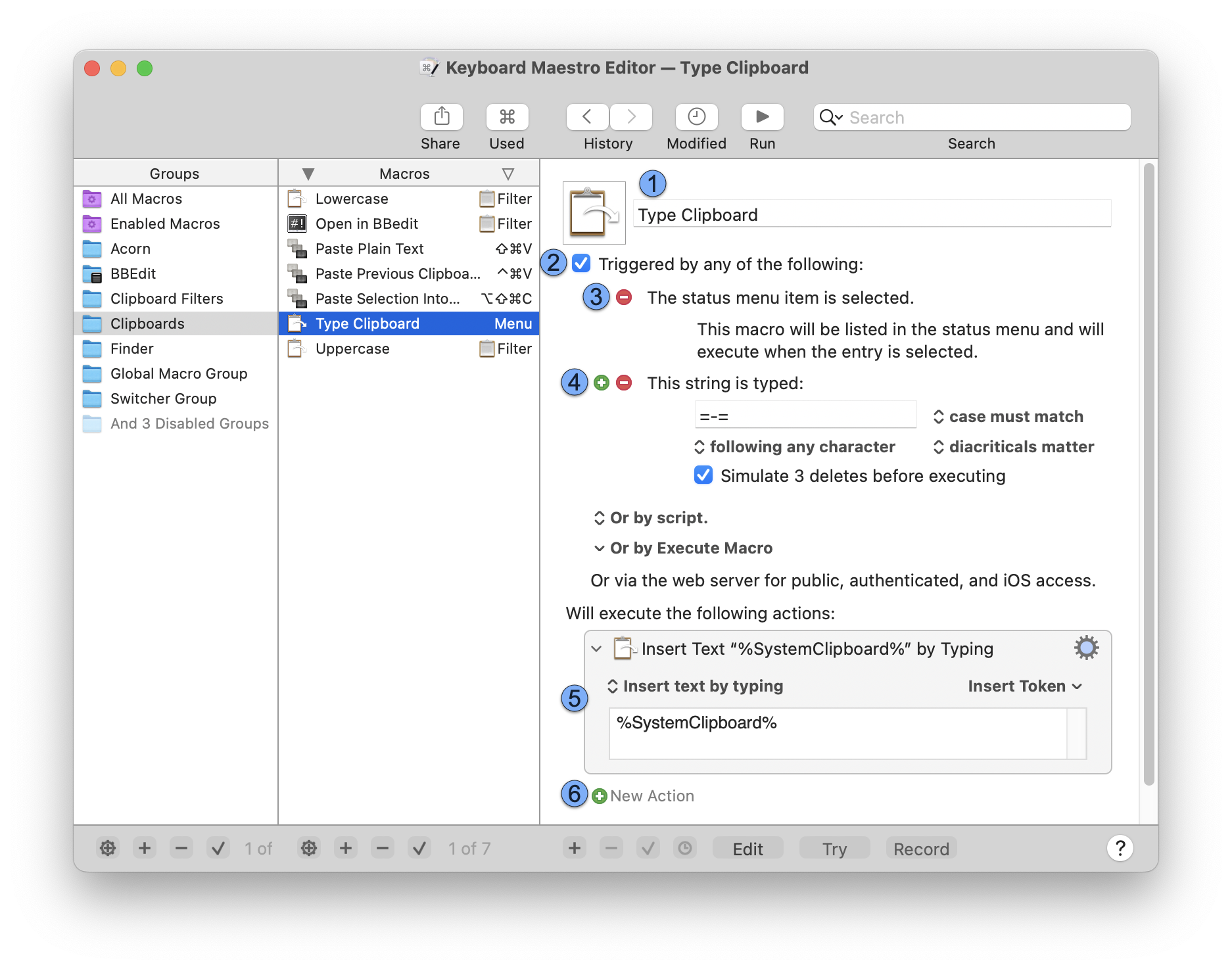
- Icon and Name 1️⃣ You can adjust the icon by double clicking the icon and selecting an image in the Icon Chooser and you can change the name of the Macro.
- Enabled 2️⃣ You can enable or disable the macro with this checkbox.
A macro must be enabled for it to be available to be triggered (executed) - its parent macro group must also be enabled and active. - Triggers 3️⃣ You can add Macro Triggers to the macro which control when the macro will run.
- More Triggers 4️⃣ You can add more than one trigger to define different ways that you can start the macro.
- Actions 5️⃣ You then add one or more Macro Actions which definite when the macro does when it runs.
- New Action 6️⃣ Click the New Action button to add additional actions.
Triggers
A macro consists of a set of triggers 3️⃣. When it is active (ie, when it is enabled, and its parent Macro Group is enabled and active), if any of these triggers happen, then the macro executes the actions.
You can add a trigger by clicking and holding on the green + button and selecting the kind of trigger you would like to use.
Some triggers, like the Status Menu trigger 3️⃣, do not have any additional configuration. Simply adding them to the macro will have macro triggered when the event happens (in this case, the macro will be listed in the Keyboard Maestro status menu, and will be triggered if you choose it from that menu).
Other triggers, like the Typed String trigger 4️⃣, require you to configure more details about when the trigger should happen, such as the specific string you have to type to trigger the macro. For the macro shown, the macro will be triggered when you type the string “=-=”.
When a macro is triggered, it will execute the actions 5️⃣.
Macro Groups
You can select a Macro Group to edit it (turn on Edit Mode if necessary by clicking the EDIT button).
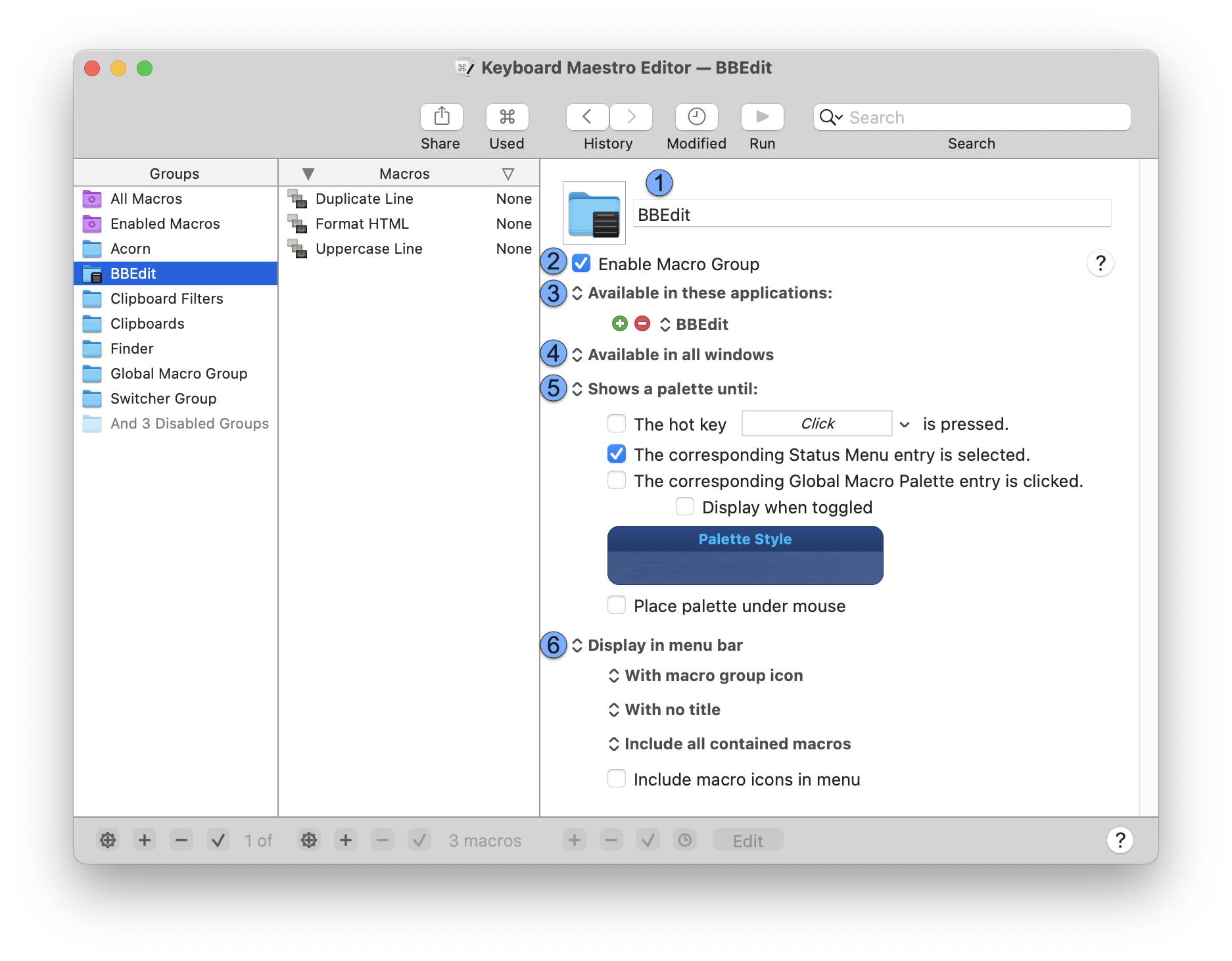
You can adjust the icon by double clicking the icon 1️⃣ and selecting an image in the Icon Chooser and you can change the name of the Macro Group.
For a Macro to be available to trigger, it must be enabled and its parent Macro Group must be enabled 2️⃣, and active. The configuration for the Macro Group controls when it will be active, and thus when the macros it contains will be active (available to be triggered and executed).
You can adjust whether the macro group is enabled 2️⃣, whether it is only active in some specific applications 3️⃣ (ie, when they are at the front, and their menu bar is showing), whether it is only active in specific windows 4️⃣, whether it is only active when you explicitly toggle it on or off, and whether and how it shows a palette containing its macros 5️⃣ and whether and how the macro group displays in the menu bar 6️⃣.
Smart Groups
You can select a Smart Group to edit its search settings (turn on Edit Mode if necessary by clicking the Edit button).
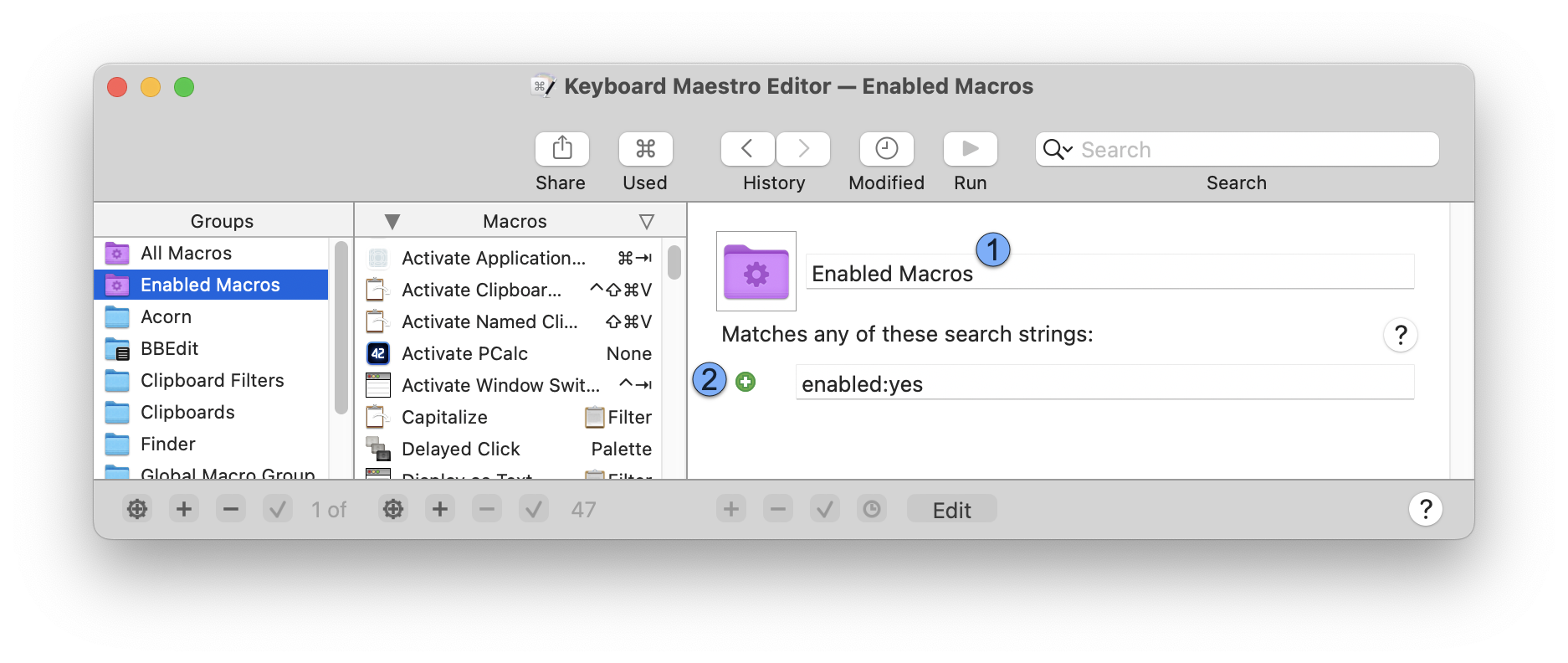
You can adjust the name of the Smart Group 1️⃣, and adjust its Search Strings 2️⃣.
You can add another Search String by clicking the green + button. Any macro that matches any of the search strings will be listed in the Macros column.
Macro Groups
Keyboard Maestro organizes your macros into Macro Groups which are like folders of macros. Each Macro Group contains a number of macros and controls when those macros are active.
A Macro Group can target or exclude specific applications, which means the macros it contains will only be active in those desired applications or when those applications are running. For example, you can have macros which are active only in Mail.app. It can also be active only in specific windows. So for example, you can have macros which are active only in Mail.app, or only in Mail.app when a compose window is open.
A Macro Group can also act as a container for specific-use macros which are enabled only when you specifically activate them. For example, you could create a Macro Group containing macros that resized or repositioned windows using the arrow keys, but those macros would only be active after the Hot Key was pressed so that the arrow keys could be used normally at other times.
Macro Groups can be displayed as palettes, allowing you to create your own custom toolbars which can be configured with a variety of themes and to appear under the mouse.
Macro Groups can also be displayed in the menu bar, including information that is displayed and dynamically updated, as well as offering another way to trigger macros.
If you are syncing your macros with another Mac, Macro Groups can be disabled specifically on this Mac.
To create a new Macro Group, first launch Keyboard Maestro.
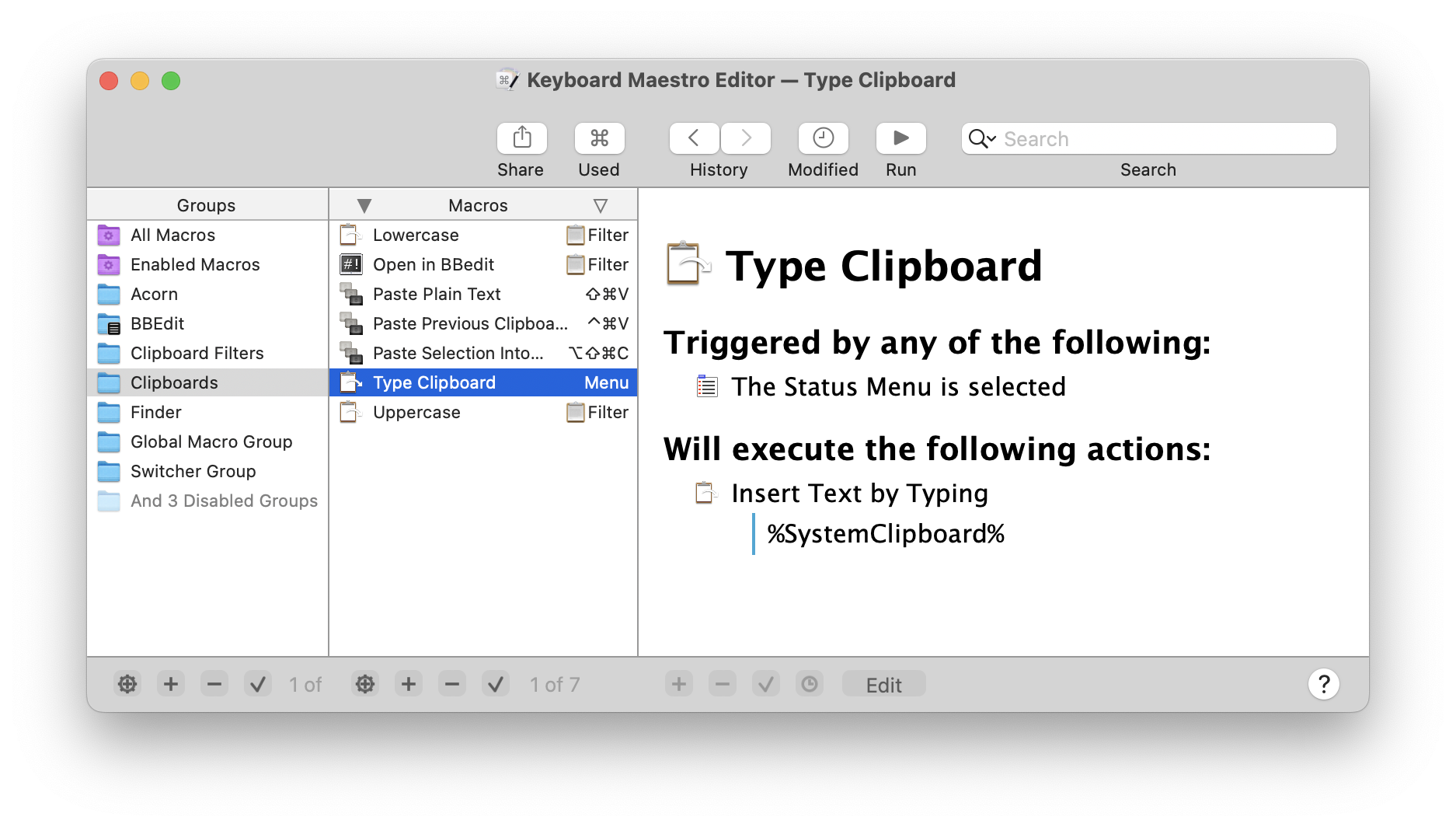
Now click the + button at the bottom of the Macro Groups list.
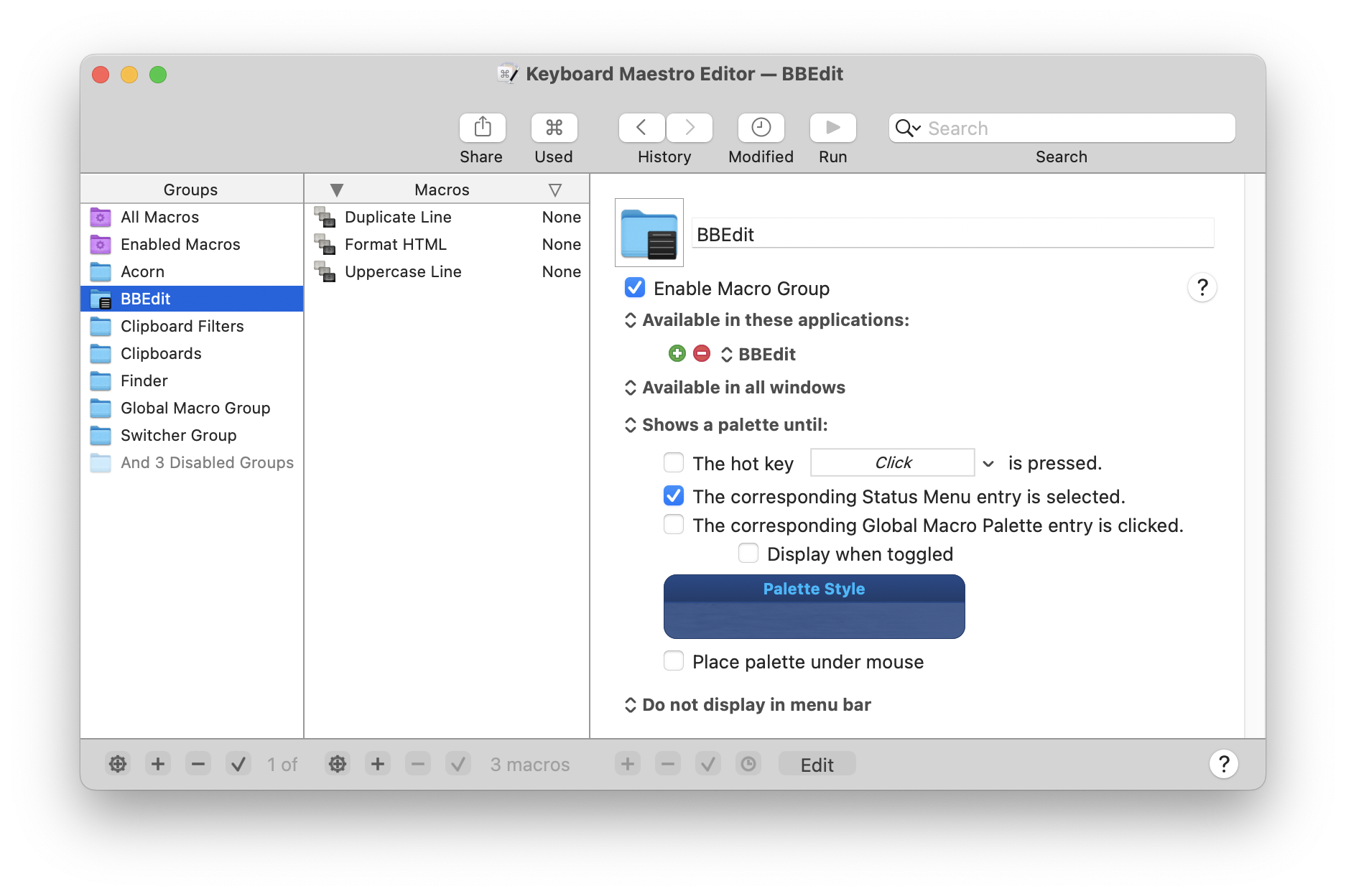
Enter the name of your new Macro Group.
You can choose to target the macros in your Macro Group at specific applications.
By default, Macro Groups and their Macros are available in all applications, that is they are always ready to be triggered. These are especially useful for Macros that give you instant access to applications or documents, or type in globally applicable text. For example you might have a Macro to launch your email client or word processor, a Macro to open your financial accounts, and a macro to type your name or email address.
To have macros only active in specific applications, set the Macro Group to be “Available in the following applications” and add the desired applications to the list.
For example, you could have macros targeted at:
- Mail.app that insert common text messages.
- BBEdit and Xcode that insert code chunks or duplicate lines or add #include headers.
- Safari that configure windows or enter information.
- Photoshop or Acorn that arrange items or script guides.
To have macros active everywhere except specific applications, set the Macro Group to be “Available except in the following applications” and add the desired applications to the list. For example, you could exclude macros from triggering in games. Also, if you have an application that uses lots of function keys for crucial tasks, you could exclude that application to allow you to use the function keys for macros elsewhere without conflicting with that application.
You can restrict a macro to be active only in certain windows based on the window title.
You can also choose to activate the macros manually or display the macros in a floating macro palette. The options are:
- Always activated.
- Activated for one action when:
- Activated/deactivated when:
- Shows a palette for one action when:
- Shows/hides a palette when:
- Shows a palette until:
- Always activated and shows a palette for one action when:
- Always activated and shows/hides a palette when:
- Always activated and shows a palette until:
To have the macros in a Macro Group always ready to be triggered, set the Macro Group to be “Always activated”.
To have macros that are active only immediately after you trigger the Macro Group with no visible palette, set the Macro Group to be activated “Activated for one action when”. The macros in the Macro Group will be enabled when you trigger the Macro Group and will remain enabled until either any macro is triggered or you press any other key. You could use this to create a set of related actions with easily remembered hot keys that will not conflict with normal use because they are not activated until you trigger the group. For example, you could have a group of macros to launch various applications so that Command-Control-L activates the group and then a single letter press launched the application (eg M for Mail, S for Safari, F for Finder).
As with each of the following options, you can trigger the macro group by pressing a Hot Key, by selecting from the Status Menu, or by clicking on the global floating palette.
To have Macros that are remain active after you trigger the Macro Group, set the Macro Group to be “Activated/deactivated when”. The Macros in the Macro Group will be enabled when you trigger the Macro Group and will remain enabled until you dismiss the Macro Group by repeating the trigger. You could use this to create a set of related actions with easily remembered hot keys that will not conflict with normal use because they are not activated until you press the group Hot Key. For example, you could have a group of macros to move and resize windows and have Command-Control-W activate the group. Then a single arrow key press moves the front window. When the window is positioned, press Command-Control-W a second time to disable the macros.
To have Macros that are active and displayed in a macro palette only immediately after you trigger the Macro Group, set the Macro Group to “Shows a palette for one action when”. The Macros in the Macro Group will be displayed in a floating Macro Palette and enabled when you trigger the Macro Group and will remain displayed until either any macro is triggered or you press any other key. You could use this to create a set of related actions that do not even need a Hot Key. For example, you could have a group of macros to launch various applications like Mail, Safari and the Finder so when you press Command-Control-L, a palette of these macros is displayed and a single click on the desired application will launch the application.
To have Macros that are active and displayed in a macro palette after you trigger the Macro Group, set the Macro Group to “Shows/hides a palette when”. The Macros in the Macro Group will be displayed in a floating Macro Palette and enabled when you trigger the Macro Group and will remain displayed until you trigger the Macro Group again. You could use this to create a set of related actions that do not even need a Hot Key. For example, you could have a group of macros to align objects in a CAD application, so when you press Command-Control-A, a palette of these macros is displayed and you can click various alignment options (distribute left-right, align top edges) and then close the palette by pressing Command-Control-A a second time.
To have Macros that are initially active and displayed in a palette, set the Macro Group to “Shows a palette until”. The Macros in the Macro Group will be displayed in a floating Macro Palette and enabled. The palette will close when (if) you trigger the Macro Group and will remain closed (and the macros disabled) until you trigger the Macro Group again. You could use this to create a set of related actions that do not even need a Hot Key and that are available in a Macro Palette. You could make the Macro Group available only in a specific application so that it appears only in that application. For example, you could have a group of macros to align objects in a CAD application, and have the Macro Group available (and hence the palette displayed) only in the CAD application.
Whether the macros are displayed in a Palette or not, the macros can still have Hot Key (or any other kind of) triggers which will be available whenever the macro group is active.
With the previous three settings, the macros are active if and only if the palette is displayed. The final three options are the same except that the macros are always active, so they are always available to be triggered by another means, and sometimes by the palette.
You can also display the Macro Group in the menu bar. You can select which icon to display and what title text to show in the macro bar, both of which can be dynamically updated allowing you to show information like stock prices, word counts, reminders, time, etc. For example, you could have an icon and time that showed how long you had been working without a break. The menu can include all the macros in the group, or just those macros with the Group Status Menu trigger.
You can change the targeting of an existing group by selecting it in the Groups list and ensuring you are in Edit mode by clicking the Edit button, or by double clicking the macro group.
You can disable or enable a macro group by selecting it and clicking the ✓ button at the bottom of the Groups list. If a Macro Group is disabled or inactive for any reason, all its contained Macros will be inactive. You can disable or enable a Macro Group using the Set Macro Enable action, you can show in a palette or activate a Macro Group using the Show Macro Group or Activate Macro Group actions.
Disabled Macro Groups can optionally be hidden using the choosing the View ➤ Hide Disabled Macro Groups menu.
You can control or right click on a macro group to:
- Cut, Copy, Duplicate or Delete the Macro Group.
- Copy the Macro Group as XML, or its UUID.
- Copy the Macro Group as a Set Macro or Group Enable or Toggle Macro Group action.
- Disable or Rename the Macro Group.
- Export the entire Macro Group.
The Keyboard Maestro editor has full AppleScript support so you can manipulate macro groups in many ways via AppleScript. See Scripting the Keyboard Maestro editor.
To delete a Macro Group, select the macro group and then press Command-Delete or click the - button at the bottom of the Groups list. Like all actions, you can Undo this if you make a mistake.
You cannot delete or rename or disable the Global Macro Group. If you want to control when some of the macros within the Global Macro Group are active, make a new macro group and drag those macros to it.
Smart Groups
You can create Smart Groups which let you see macros matching certain criteria by clicking the ⊕ button at the bottom of the Groups column, and you can edit a smart group selecting it in the Groups list and clicking the Edit button, or by double clicking the Smart Group.
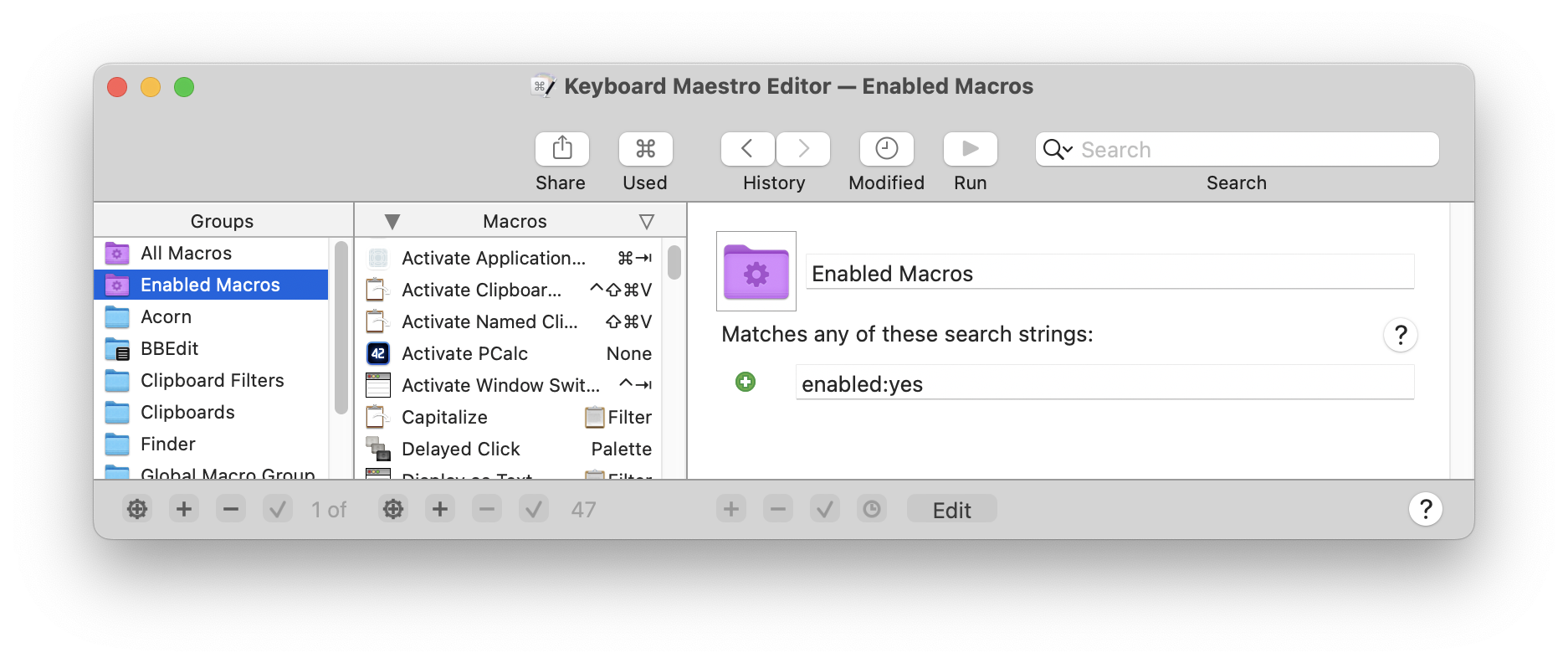
A Smart Group consists of a set of Search Strings, and any macro that matches any of the search strings will be listed in the Smart Group.
You can control or right click on a smart group to Rename or Duplicate it.
Macros
Macros are used to automate your workflow, procedure, or process on your Mac. Macros are a way of improving your productivity by allowing you to perform repetitive or frequently required actions more quickly and accurately, tailoring your Mac to your usage patterns.
Macros are sometimes known as Workflows or Shortcuts, but for Keyboard Maestro we will stick to the terminology of using “Macro” to refer to a Keyboard Maestro macro, and use Shortcuts and Workflows only to refer to Apple’s Shortcuts and Automator Workflows.
A Macro consists of:
- One or more Macro Triggers which define when the macro will be executed, if it is Active.
- A series of steps to execute called Macro Actions.
Macros are contained in Macro Groups, much like files are contained in folders. The Macro Group determines when the Macro is Active (available to be triggered). Macro Groups control such things as which applications the Macro will be active in.
A simple example of a Macro is one which has:
- A Single Hot Key trigger, such as ⌃E
- A single action like Insert Text by Pasting the text “YourName@YourDomain.com”
- Is in the “Global Macro Group”, making it available to all applications.
Macros can do almost anything you can do manually on your Mac, and much that you can't, like running scripts.
How To Create a Macro
To create a Macro, first launch Keyboard Maestro, select the desired Macro Group to contain it, and then click the + button below the Macros list. Enter the name of your new Macro (you can skip this and it will be named for you based on the action you select).
Alternatively, you can use the New Macro Wizard by clicking the ⊕ button.
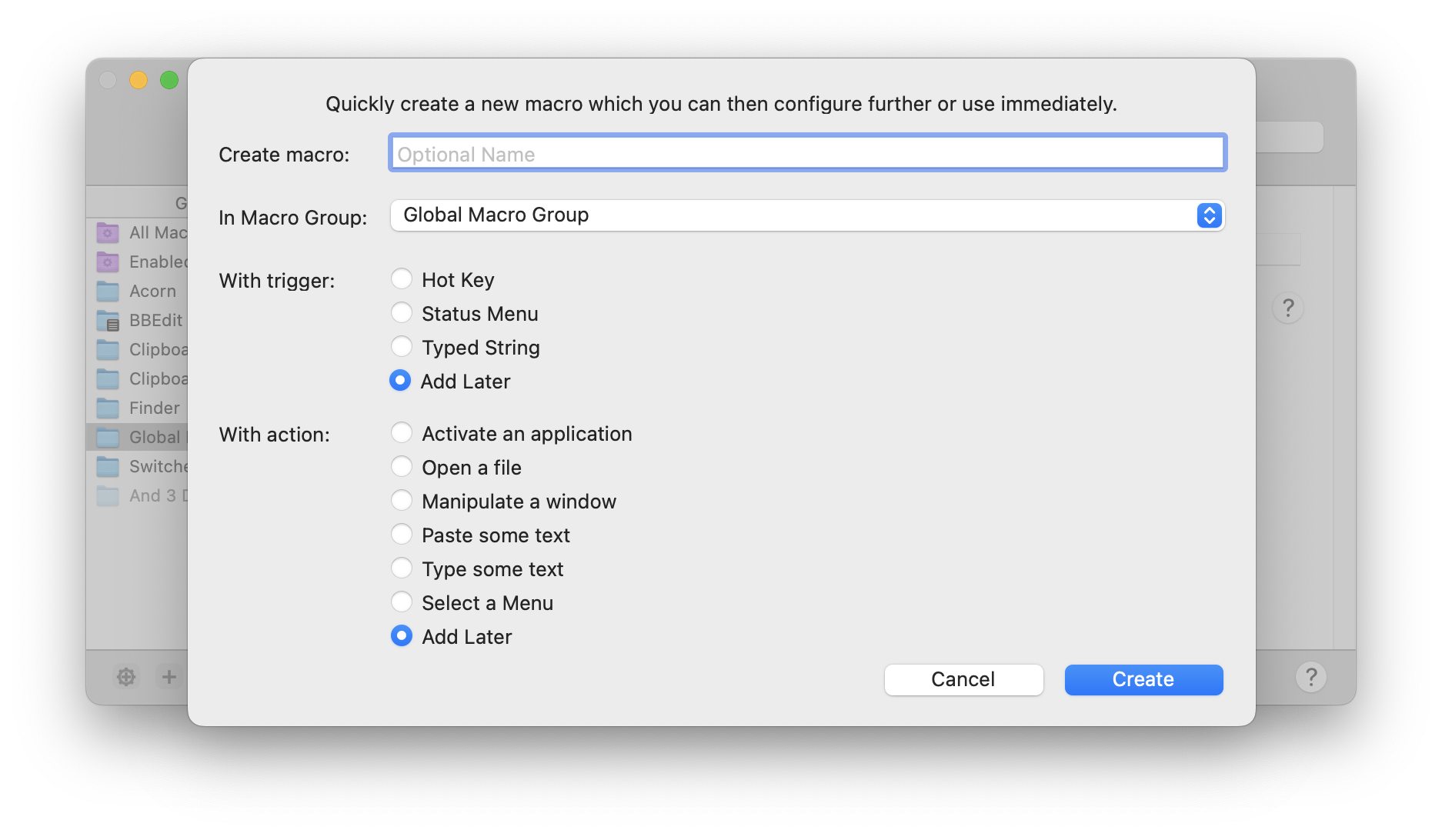
Enter the name of your new Macro (you can skip this and it will be named for you based on the action you select), the macro group to place the macro in, and optionally select one of the basic triggers or actions. You can fill in the details of the triggers and actions, or add more triggers and actions later.
When you create the macro, the Macro Editor window will be displayed. If you later want to edit the Mac, double click it, or select it and ensure the Edit button is pressed.
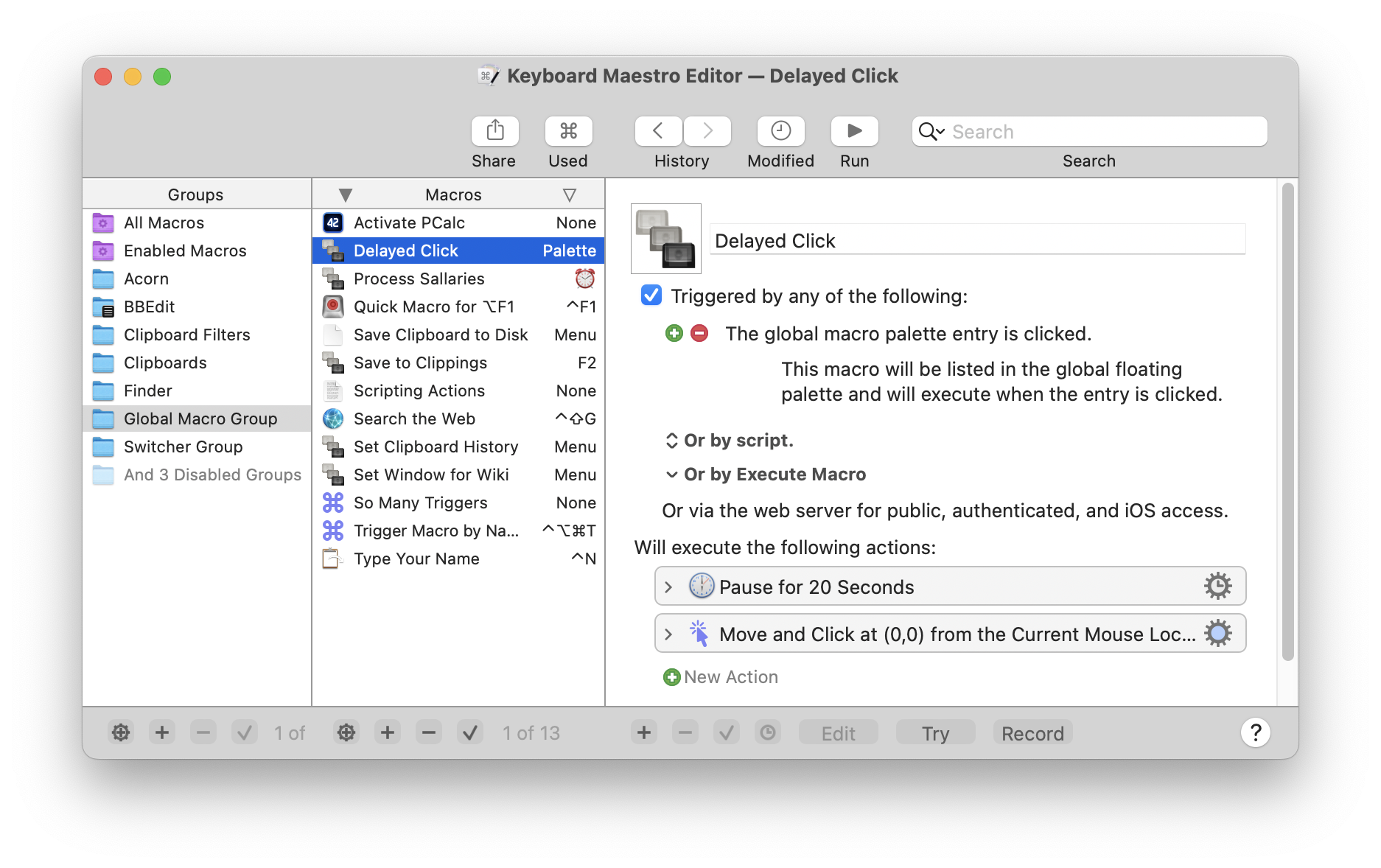
You can create a new trigger by clicking on the green + button. There are several Macro Triggers to choose from, the most common being the Hot Key trigger which allows you to execute the Macro at the press of a key. You can define several different triggers, and any of the triggers will execute the Macro Actions. You can delete a trigger by clicking the red ⊖ button.
You can add a new action by clicking the New Action button or the + button at the bottom of the macro detail view to display the list of actions or by choosing the Edit ➤ Insert Action By Name menu or choosing from the Edit ➤ Insert Action menu. There are many Macro Actions to choose from. The actions you include will be executed in order. You can reorder the actions by dragging them around. You can copy actions by Option-Dragging or by using Copy and Paste. You can delete an action by selecting it and pressing the Delete key. You can enable or disable actions by selecting them and clicking the ✓ button at the bottom of the macro detail view.
You can control or right click on a macro group to Disable, Enable, Rename, Duplicate, or Export it.
An easy way to generate macro actions is to turn on recording by clicking the Record button at the bottom of the macro detail view and proceeding to show Keyboard Maestro what you want to do. Then turn recording back off and look through the actions. Chances are you will need to delete or adjust some of the recorded actions to make a robust macro, but this will be quicker than creating each action manually.
Macros are continuously saved, so the macro is live as soon as it is created. It will be available immediately (subject to the restrictions of the Macro Group it is contained in). There is no need to turn off editing, switch to a different macro, or quit the editor (although quitting the editor after you have finished editing all your macros is a good idea).
You can select a recently triggered macro by clicking on the ⌘ toolbar button to select it or select from recently modified macros by clicking the ◷ toolbar button.
You can share a macro to the Keyboard Maestro Forum, or to a friend via Mail or Messages using the sharing button at the top of the Macros window.
You can disable or enable a macro by selecting it and clicking the ✓ button at the bottom of the Macros list. You can also disable or enable a Macro using the Set Macro Enable action, or from AppleScript with:
tell application "Keyboard Maestro" set enabled of macro group "Macro Name" to true end tell
You can start editing a Macro from AppleScript with:
tell application "Keyboard Maestro" editMacro "Macro Name or UID" end tell
The Keyboard Maestro editor has full AppleScript support so you can manipulate macros in many ways via AppleScript.
How to Edit a Macro
You edit a macro by selecting it and ensure you are in Edit mode. Double clicking on the macro will turn on Edit mode.
You can select a macro by name by choosing the View ➤ Select Macro By Name menu.
How to Run a Macro
In order to run (execute or trigger) a macro it must be active, that is:
- It is enabled
- It’s containing Macro Group is enabled
- It’s containing Macro Group meets all its activation criteria.
Activation/Deactivation or a Macro Group is a dynamic process, automatically set by the Keyboard Maestro Engine as your Mac's environment changes in real time. For details, see Macro Activation
You can try out a macro from the Keyboard Maestro by clicking the ▶︎ Run button at the top of the editor window. Of course, macros are often sensitive to the context, so it may not be appropriate to run them directly from the editor.
Generally, you run a macro by invoking any one of its triggers.
You execute a macro’s action sequence by invoking one of its Macro Triggers that you have defined (such as pressing a hot key if you have configured a hot key trigger). For some triggers, no action is required on your part. For example, the macro could be triggered at a specific time, or when a specific USB device is attached.
You can also trigger macros by name using the Trigger Macro by Name action, which in turn can be in a macro and triggered any way you desire.
You can trigger a macro using the kmtrigger: scheme with a URL like kmtrigger://macro=MacroName&value=Value (the value is accessible via the %TriggerValue% Text Token).
You can also trigger a macro from a shell script using the keyboardmaestro CLI tool.
If the web server is enabled for remote access, you can trigger a macro remotely after logging in using a web browser. Alternatively, you can use the Remote trigger and trigger your macro using a URL from remotely via our trigger server.
You can also trigger a macro using AppleScript or another scripting language (select the “Or by script” entry to display script code in various languages such as AppleScript or Perl).
Note that the web server needs to be separately enabled in the Web Server preference pane, and all macros are subject to the restrictions of the Macro Group they are contained in. If the Macro Group is not enabled and active, the macro will not be available.
Where are the Macros Stored
The macros are stored in on your local Mac in the Applications Support folder. So it is important to ensure you have good backups to ensure your macros are safe in the event of a harddisk problem or other loss of data on your Mac.
How to Import Macros
You may want to import Macro(s) you have downloaded from other sources, like the Keyboard Maestro Forum.
You may use any of the following to import the macro file (.kmmacros):
- Double-click on the macro file in the Mac Finder.
- In the Keyboard Maestro app, goto File > Import Macros Safely… and select the macro file.
- In some browsers, click on the downloaded file icon at the bottom of the browser window.
Note that the macro file (.kmmacros) may contain one or more macros, and will also create the Macro Group if it does not exist in your configuration. Otherwise, it will put the Macro in your existing Macro Group.
Import Macros Safely
⚠️ You should be aware that the macros will be imported in the same state, triggers, and macro group that they were saved in. By default, macros are imported disabled unless you hold the Option key down. Importing them disabled is important, because otherwise this could result in the imported Macro being triggered (executed) as soon as it is imported. If you are at all uncertain about the source of the macros, ensure you import the macros disabled or choose the File ➤ Import Macros Safely menu, and then closely examine the macro and what it does before enabling it.
See also the Macro Groups, Macro Actions, Macro Triggers, Macro_Activation, Macro Examples, Macro Library and Recording sections.
Macro Triggers
A Macro is executed when any of its Macro Triggers is activated. There are many triggers to choose from, the most common being a Hot Key, that is the Macro is executed in response to a keystroke, usually in conjunction with one or more modifier keys. You can also trigger a macro by typing a string. Or you can display a Macro Group as a floating palette and execute the macro by clicking on an entry, or execute macros remotely.
Hold the option key down while adding a new trigger to get help on that trigger.
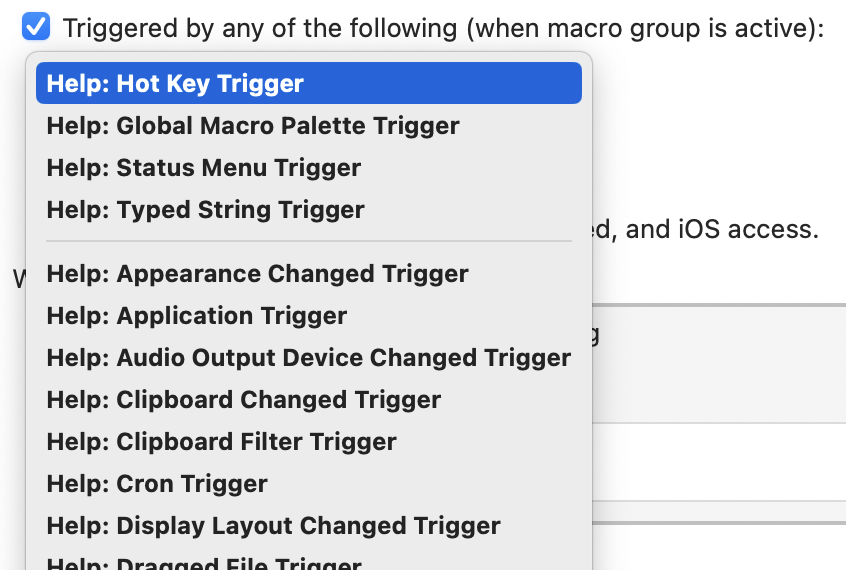
You can also trigger macros by name using the Trigger Macro by Name action, which in turn can be in a macro and triggered any way you desire.
The Hot Key trigger is perhaps the most common and most basic of all triggers. When you press the configured keyboard key, the system swallows the keystroke, and Keyboard Maestro executes the macro.
The Typed String trigger is also very common, it lets you execute a macro in response to a sequence of keys like an abbreviation.
The Global Macro Palette trigger lets you add your macro to a floating palette, so you can trigger it by clicking on the macro name in the palette.
The Status Menu trigger lets you add your macro to the Keyboard Maestro status menu so you can trigger it by selecting the macro name from the status menu.
There are many more triggers, and you can learn more about them on the wiki Triggers page.
Macro Actions
A Macro executes a sequence of Macro Actions in order. There are many actions to choose from. Some simple actions, such as Restart Computer, require no other information and simply do their job, while other more complex actions, such as Select a Menu Item, require you to specify more information, such as a target application or menu name. You do this by editing the values for the action.
Keyboard Maestro actions have two very distinct types of fields: text token fields and numeric calculation fields. You can learn more on the wiki Text Fields page.
There are many powerful Macro Actions available for your use, and you can sequence them together to perform complex tasks.
To add an action, edit your macro, click the New Action button, or equivalently the + button below the detail view. This will show the lists of possible actions.
To see all actions, select the All Actions category. To see plug in actions that you have added to Keyboard Maestro, select the Third Party Plug Ins category.
To select just your favorite actions, select the Favorites category. You can drag actions from your macro into your Favorites category, or control or right click on an action to add it to your favorites. Favorite actions will retain all the settings of the actions. You can delete favorite action in the action selector, or from the Add Action by Name window.
Double click or drag one or more of the actions to add them to the action list for the currently edited macro.
Alternatively, choose the Edit ➤ Insert Action by Name menu and quickly search for and add an action by name, or choose from the Edit ➤ Insert Action by Name menu. These will also include any favorite actions you have configured. If you hold the shift key down the action will be inserted above the currently selected action.
You can drag Macro Groups or Macros into the action list. With no modifiers, this will create an Execute Macro Action or Show Macro Group action. With the Option key, this will copy in the macro's actions. With Command-Shift, this will create an Enable Macro Group or Macro action. With Option-Shift, this will create a Mark the Macro action.
You can drag a file into the action list. This will create an Activate Application, Execute Script, or Open File action.
You can use control-up/down arrow to move the selected action up or down in the list, as well as command-control arrows to move the selected action to start or end of the list.
You can use the Engroup or Degroup from the Actions menu to enclose actions in other containers (or remove them from containers).
You can enable or disable actions by selecting them and clicking the ✓ button at the bottom of the macro detail view. You can set the timeout or other options on an action clicking the action (gear) ⚙ menu at the top right of the action and selecting an option.
You can display more or less detail about some actions by clicking the disclosure triangle. You can disclose all the actions (in a sublist) simultaneously by option clicking on the disclosure triangle.
You can try the action immediately by clicking the action (gear) ⚙ menu at the top right of the action and selecting Try. Alternatively, you can try the selected actions immediately by clicking the Try button at the bottom of the macro detail view. When trying an action, remember that the action will run without any preamble, so if the action expects to operate on a specific application or window, simply “trying” it in the Keyboard Maestro editor will probably not work. You might need to temporarily add an Activate a Specific Application action above the actions you want to try and selecting it and the actions first.
You can control or right-click on an action to act on it, including pasting other actions above or below it.
You can configure the action using the various menus and text fields, as well as by clicking the ⚙ button and using the action menu. This allows you to rename actions, color them, add notes, configure their time out and failure behaviour and more.
The action (gear) ⚙ menu also allows you to get help on the specific action.
You can share an action sequence to the Keyboard Maestro Forum, or to a friend via Mail or Messages using the sharing button at the top of the Macros window.
You can learn more about the available actions on the wiki Actions page.
Macro Syncing
Keyboard Maestro is licensed on a per user basis on up to five Macs, so if you use it on two or more Macs you may want to transfer some of your macros from one to the other. You can do this by selecting the desired macros and choosing the File ➤ Export Macros menu to export your macros, and then importing them on the target Mac.
Alternatively, you may want (almost) all your macros on both Macs, in which case you can set up your macros to sync between them. This means any change you make on one Mac will be mirrored on the other and vice versa, although you generally should not edit your macros simultaneously on both Macs.
ℹ️ NOTE: You can only sync between identical versions of Keyboard Maestro. If the sync file is newer than the current version, you will be warned to upgrade, turn off syncing, or live dangerously (which temporarily disables syncing and allows you to make changes that will likely cause trouble later).
To do this, you need a file location that is mirrored on both Macs. Dropbox or a similar service is good for this, or you can use a shared file server, although you must ensure it is available at all times to both Macs. Note that iCloud Drive can frequently take a long time to sync between Macs which can lead to lost changes.
You are then ready to start syncing your macros.
⚠️ WARNING: Syncing macros is an all or nothing affair, so any macros on the target Mac before you start syncing will be lost.
⚠️ WARNING: If you make changes on one Mac, and then make changes on the other Mac before syncing has taken place, you may lose one or other changes. Be especially careful if you are working with your Mac when offline.
ℹ️ NOTE: Keyboard Maestro references to files or applications that exist on one Mac and not the other will likely cause problems, so you should ensure any application you reference on one Mac is available at the same path on both Macs.
On the Mac that currently has your macros, choose the File ➤ Start Syncing Macros menu. Read the text carefully, and then click the Create New button. Save your existing macros in the macro sync file in your shared location. From now on, Keyboard Maestro will sync any changes to/from that file.
Wait for the file to be mirrored to the second/target Mac. On that second Mac, choose the File ➤ Start Syncing Macros menu. Again, read the text carefully, and then click the Open Existing button.
⚠️ WARNING: All of the existing macros on this second Mac will be destroyed when you click the Open Existing button. If you have any macros on the second Mac that you wish to preserve, export them first, and then after syncing is enabled, import them (and they will then be synced to your other Macs).
Select the mirrored sync file. Your existing macros will be replaced with the macros from your first Mac.
Repeat the process for any other Macs.
If there are some macros you do not want active on a Mac, you can configure any given Macro Group to be disabled on that particular Mac by turning on the Disabled on this Mac setting in that Macro Group. Alternatively, you can click the Disable On All Macs button and then turn off the Disabled on this Mac setting on the desired Macs. Once you click the Disable On All Macs button, the macro group will default to being disabled on any new Macs you sync with.
Dropbox may keep backup versions, and Keyboard Maestro keeps backup revisions (in the File ➤ Revert Macros menu), so you should be able to recover from any conflicts that happen. Dropbox may notice a conflict if you edit your macros on both Macs simultaneously. As a general rule this should not be an issue, though you may lose a change if you make changes on both Macs quickly (and note that quitting the Keyboard Maestro editor is considered a change).
Since your two Macs will likely not be identical, you may have to adjust your macros to work properly on both Macs. Using the various Tokens and Functions can help. For example the %MacUUID% token is a unique ID for each Mac, and can be used to test which Mac the macro is running on. Other functions, like the SCREEN function can be used to ensure your macro behaves appropriately regardless of the details of the Mac.
If you use Migration Assistant or otherwise clone your Mac harddisk to a new Mac, and intend to continue using Keyboard Maestro on both Macs, then you will need to reset the MacUUID on one of the Macs so that Keyboard Maestro can tell the difference between them. To do this, run the Terminal commands:
defaults delete com.stairways.keyboardmaestro.engine MacUUID defaults delete com.stairways.keyboardmaestro.engine MacRemoteUUID
ℹ️ NOTE: Only your macros are synced. None of your preferences, clipboards or variables are synced.
Macro Debugger
Keyboard Maestro includes a built-in macro debugger which you can turn on by choosing the Status Menu ➤ Start Debugging menu or by using one of the Debugger actions. This will display the Macro Debugger window.

Once debugging, you can control whether new macros start paused or start running.
The macro debugger shows all running macros, and what action they are currently executing (including showing nested actions).
Using the buttons on the left, you can:
- Continue the macro – allowing it to run until completion, or until it hits a Debugger Breakpoint action.
- Pause the macro.
- Step Over the current action, including any subactions.
- Step In To the current action, stepping in to any included subaction.
- Step Out Of the current action and any other actions at the same level.
The buttons on the right let you:
- Edit the current action in the editor.
- Cancel the macro.
The button at the top right toggles displaying variables. The debugger will show the ten most recently modified (by this macro instance) variables and a summary of their values. If you want to show more information, you can use the Log action to log details to the Engine.log file, or use the Display Text action to display information in a window.
To debug a macro:
- Make sure the “Pause New Macros” is checked.
- Trigger your macro.
- Your macro will appear in the Debug window.
- Click on the icon/button with the down arrow to step into the macro to the first step.
- Click again to advance to further steps/Action.
All the debugger actions can also be done via the Debugger actions.
Keep in mind that once a macro has started executing, the engine has taken a copy of the macro to execute, so any changes you make in the editor will not affect the execution of the macro (although any changes you make to a sub macro that has not yet started executing would apply).
Also keep in mind that macros can often be time sensitive, so if you find your macro runs fine when stepped through in the debugger, but not when run normally, the issue is quite possibly that the macro is executing actions like click actions before the system has caught up and the screen is stable. Add an appropriate Pause action if that is the case.
If you close the debugger window, the paused macros will resume their normal operation.
Variables
Like most programming languages, Keyboard Maestro allows you to create Variables to store data for use later on in the same Macro, or in other Macros.
Variables can be set from many actions. You can set variables to specific tokenised text, to the result of a calculations, from user input, from the Keychain, by searching other variables, from the clipboard or Named Clipboards, as the result of scripts, and from many other sources.
Variable Naming Rules
Anywhere an Action requires a Variable, you can enter any name you like (even though often a default name is provided), as long as it conforms to these rules:
- Variable names must start with a letter, and then can contain letters, numbers, spaces, or underscores.
- Some Variable kinds require a specific prefix (see Scope below).
- Variable names are case insensitive, but their case is remembered.
- Variable names should not include a function or operator name with spaces around it.
- (eg “ MOD ” , so “A MOD B” would not be a valid variable, although “MODULE” would be fine).
Scope
Keyboard Maestro includes variables with different breadth or scopes, in order of scope, with broadest scope first:
| Scope | Availability |
|---|---|
| Global, permanent variables | • Accessible basically everywhere, including Scripts. • Permanently stored on your Mac drive. • Available for read/write in any Macro or Action, not just the Macro where the Variable was created. * Persist between logins and restarts of your Mac. • You can also see and edit variables in the Preferences. • You can see global variables in the Value Inspector. |
| Password, semi-permanent variables | • Name must begin or end with “PW” or “password” (case insensitive). • Stored only in memory. • Available to macros but not displayed. • Not directly accessible via AppleScript. • Concealed in password fields in Prompt For User Input actions. • Not saved to disk. |
| Instance Variables, local to a specific macro execution instance | • Name must begin with “instance” (case insensitive). • Restricted to a specific execution sequence. • Available to the Macro where it was created and Sub-Macros of that Macro, for a given execution instance of the main macro. • These variables are private to each execution of the same Macro, even when running simultaneously. • Accessible by Prompt For User Input • Accessible by scripts (when used in an Execute Script Action). • Accessible by Custom HTML Prompt. • Accessible by AppleScript with the instance specifier. |
| Local Variables, local to a specific macro | • Name must begin with “local” (case insensitive) • Restricted to the specific Macro it is in. • Not available to any of its Sub-Macros • Same accessibility as Instance Variables. |
Macros can create or read existing variables, which persist and are permanently stored (except Local and Instance variables which are transient, and Password variables which are never saved to disk).
Variables contain only plain, un-styled, text and may be used in any token text field in an action, as well as in Calculations in a numerical field if they contain a valid number or expression.
Since multiple instances of a macro could be running at the same time, using Local or Instance variables should generally be preferred so that each execution instance has its own independent variables.
ℹ️ Note that Local and Instance Variables are available in scripts only when the script is called in an Execute Script action, unless you specify the execution instance explicitly.
⚠️ Note that while Password variables are not directly available to scripts, their contents can easily be extracted, eg with the Set Clipboard to Text action, so you should clear them as soon as they have served their purpose.
Setting Variables
Variables are usually created and set by Macro Actions, but can also be set by scripts. The Action that sets a variable will create it if need be. Variables do not need to be declared in any way.
The most direct action to set a variable is the Set Variable to Text action.
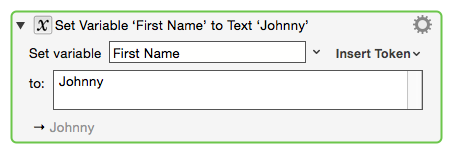
This action processes the tokens and backslashed characters in the text and sets the variable. As will all text fields, if you wish to use another variable in the text you must use the %Variable% token, eg The value is %Variable%VarName%.
You can also use the Set Variable to Calculation action. This action evaluates the numeric expression and then sets the variable to the result. As with all numeric fields, if you wish to use another variable in the calculation, you use the variable unadorned, eg VarName * 3.
There are many other actions that set variables.
Using Variables
There are many Macro Actions that can use variables. Some of these explicitly provide for entry of the variable name, but most provide for a more general text entry that accepts either token text or a numeric expression.
When editing a field:
- Fields that expect text tokens show a small T.
- Fields that expect calculations show a small C.
- Fields that expect just a variable name show a small V.
Variables in Text Fields
Variables can be used in text fields using the %Variable% token, for example the %Variable%VariableName% token includes the value of the VariableName variable in the text.
For Example, using the Insert Text Action:

You can also use a short form of just %Variable Name% to include variables as long as the variable exists and has a value and there is no corresponding text token, although generally it is better and clearer to use the longer form %Variable%Variable Name%.
Variable Arrays
While technically all Variables are just strings, you can access a variable as if it were an array by setting the Variable to a delimited list of text, and then using the following notation:
%Variable%<VariableName>[<IndexNumber>]%
where
- “
<VariableName>” is any valid Keyboard Maestro Variable with a delimited set of values.- By default the comma
,is the delimiter (see below for setting a custom delimiter).
- “
<IndexNumber>” is an integer indicating the index (starting with 1) of the array value within the Variable Array.- Negative indices start from the end of the array.
- Zero index returns the count.
- This index can be determined using any Calculation, including simply a Variable Name, like
i. - Examples:
%Variable%myList[i]%%Variable%myList[3 * i + 2]%
How to Use Custom Array Delimiter
Place the custom delimiter after the closing bracket ].
- For Example:
%Variable%myList1[i]:%, where the colon:is the delimiter used in the Variable Array. - Of course, the Variable Array, myList1 in this case, must use the same custom delimiter.
- The delimiter can be any sequence of characters excluding the percent (%) character, eg
%Variable%myList1[i]---%or%Variable%myList1[i]-KMSPLIT-%or%Variable%myList1[i]\n%as long as the array variable uses the same delimiter.
Simple Example of Variable Array
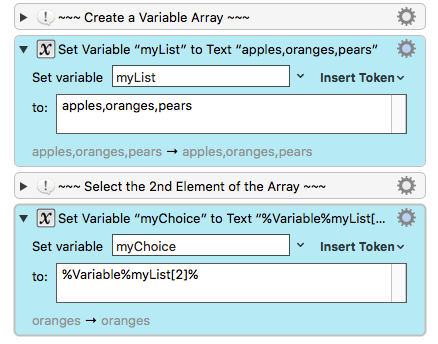
Example of Variable Array Using a Variable for the Index
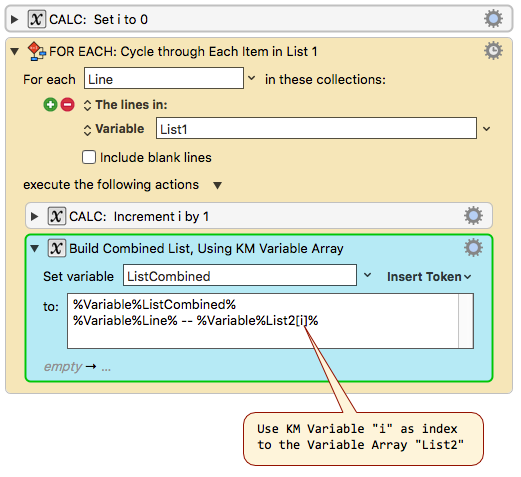
Variables in Calculation Fields
Variables can be used in calculations if their value holds a number or a numeric expression that can be evaluated. Variables are used unadorned in calculations, for example My Variable * 7.
You can also access variables in a token field numerically using the %Calculate% token. It is important to note that calculations can contain only numeric values. When you use the %Calculate% token to reference a variable or variable array element, it will convert the element to a number.
Variable Dot Notation
In a Calculation field you can reference the numbers in a variable which contains a coordinate or rectangle (which is always a string, eg “100,100,200,200”) using dot notation:
| Variable.x | x coordinate |
| Variable.y | y coordinate |
| Variable.left | the left coordinate of a rectangle |
| Variable.top | the top coordinate of a rectangle |
| Variable.right | the right coordinate of a rectangle |
| Variable.bottom | the right coordinate of a rectangle |
| Variable.width | the width of a rectangle or size |
| Variable.height | the height of a rectangle or size |
| Variable.fuzz | the fuzz of an image match (rectangle,fuzz) |
| Variable.MidX | the horizontal middle of a rectangle |
| Variable.MidY | the vertical middle of a rectangle |
The Variable Name and Dot reference are case insensitive.
Using Variables in Scripts
Variable values can be accessed from scripts you execute with Keyboard Maestro via environment variables, and from AppleScript using AppleScript commands to the Keyboard Maestro Engine, and from web browser JavaScript you execute with Keyboard Maestro via the kmvar dictionary, see the Scripting section for more details.
You can get and set Keyboard Maestro Variables (Global, Local, and Instance) in these types of scripts:
- JavaScript in Safari or Google Chrome (Get only)
- Shell Scripts (Get only)
And you can generally access Keyboard Maestro variables anywhere else via AppleScript from whatever language you want to use.
Deleting Variables
- Global Variables continue to exist (remained stored) until their value is set to the empty string, even when the Keyboard Maestro Engine is quit and relaunched.
- Password Variables, continue to exist (remained stored) until their value is set to the empty string, or until you quit the Keyboard Maestro Engine.
- Setting a Variable to
%Delete%does not technically delete it. It continues to exist. It is just hidden from view in all of the Variable lists and in the Preferences. - However, a Variable set to
%Delete%will behave as if it does not exist in most Actions, like a If Then Else Action using a Variable Condition comparing to exists.
It may be a good idea to set a Variable to the empty string if you no longer need it, or if it contains sensitive information (like a password) or a large value (like a file or web page contents).
Perhaps the best way to avoid variable clutter and eliminate sensitive and/or large values is to use either Local or Instance Variables when you do not need the Variable after completion of the Macro in which the Variable is used.
Inserting In Actions
You can add a variable to an action using the Edit ➤ Insert Variable menu or Edit ➤ Insert Function ➤ Variable menu or Edit ➤ Insert Token ➤ Variable menu, or by selecting from the popup menu next to some variable fields.
Fields that expect just a variable show a small V in the field while editing it, and you can use Type Completion to complete variable names in such fields.
View Your Entire List of Variables
You can add, delete, see or change global variables in the Variables preference pane that have been created by your macros and scripts.
Local and Instance Variables are not accessible from the Preferences Window.
Watching a Variable’s Value
You can use the Value Inspector to watch the value of a global variable.
Tokens
Keyboard Maestro provides two means to get information about objects (like web pages and windows) in the user's environment:
- Tokens (returns text, used in text token fields)
- Functions (returns numbers, used in numeric fields)
You can enter a Token in any text field in an Action, and when the Macro is triggered and the Action is executed, the token will be replaced by the value that is returned at that time. This allows you to easily combine static text with dynamic data that is supplied when the macro is executed, in most any Action that has a text field, like Display Text and Set Variable to Text actions.
Token Format
Tokens are identified by a pair of percent % symbols at the start and end of the Token name.
| Usage | Format | Example | Token Results |
|---|---|---|---|
| No Parameter | %TokenName% | Safari open to this web page: https://wiki.keyboardmaestro.com/Home_Page | %FrontBrowserTitle% returns: “Home Page [Keyboard Maestro Wiki]” |
| With Parameter | %TokenName%Parameter% | Frontmost Window Size | %WindowSize%1% returns: “1991,1417” |
Entering Tokens into Actions
The available tokens, and their definitions, are listed on the Token List page.
When you are editing a Macro, put the text cursor in a text field, and do one of the following to select and insert a Token into the text field.
- Press ⌘⌃T (or use the Menu) to display a prompt to select the Token by Name
- Use the Edit ➤ Insert Token menu
- Click on the “Insert Token” popup at the top right of the text fields to see the same menu as in #2.
- Of course, you can always just type the Token.
You can tell that a text field accepts tokens because a small T shows in the field while editing it.
Examples
Let's look at a real-world example. Let's say you would like to set the Clipboard to a Markdown Link of the current web page you are reading. All you need to do is insert these two tokens (using the Markdown format) in a Set Clipboard Action:
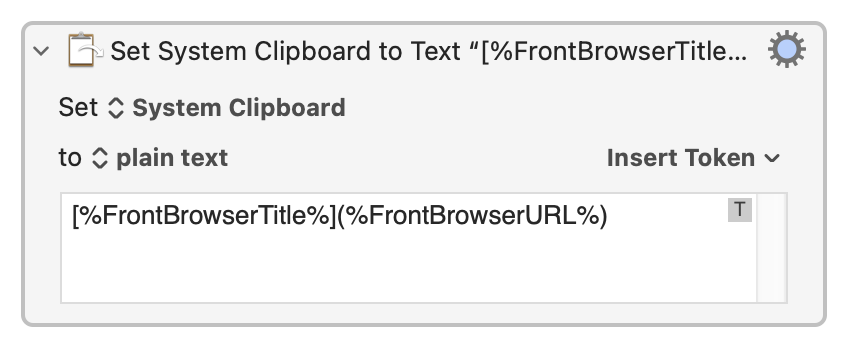
The “[]()” are just characters you type, part of the markdown text and not part of the tokens.
After the macro and Action are executed, you will see something like this on the Clipboard:
[Keyboard Maestro: Work Faster with Macros for macOS](https://www.keyboardmaestro.com/main/)
That's all you need for a great macro, which you can create yourself or download from here.
Processing
The Tokens are processed, that is replaced by their value when the action is run, and the Action containing the Token is executed.
In most text fields, you can control how Tokens are processed using the Gear ⚙ popup menu:
- Process tokens normally, or
- Just tokens (not backslashed characters) or
- Do not process any text.
Other Uses for Tokens
Non-Printing Control Characters
An exception to the rule of enclosing Tokens in percent % characters, is the use of these Non-Printing Control Characters \a,\b,\e,\f,\t,\r,\n which correspond to (bell,backspace,escape,form feed,tab,return,line feed). These will be replaced with their value in text fields, except for Regular Expression (RegEx) fields.
Convert Hex to Unicode Characters
Text token fields also process %NN% or %NNNN% or %NNNNNN% as arbitrary hex unicode characters (eg %41% is an A, %01F300% is 🌀).
Using Special Characters as Plain Text
To include a percent in your text, simply double the percent (%%). To include a backslash \ in your text, double the backslash (\\).
Text Case Conversions
Text fields also support text case conversion using the below meta characters. You may use these in both standard Text Fields and in the Replace field of a Search and Replace by regular expression action (even though these meta characters are not supported by ICS Regular Expressions).
The Available Case Conversion Meta Characters are:
\Uconverts everything up to the next\Lor\Eto uppercase.\Lconverts everything up to the next\Uor\Eto lowercase.\uconverts the next character to uppercase.\lconverts the next character to lowercase.\U\llowercase first, then uppercase.\L\uuppercase first, then lowercase.\Estop changing case.
You should not use \u after \U or \l after \L unless you terminate the sequence with \E first.
Access to an Item in Token Results
With tokens that return a list of information (comma separated by default), you can access the individual items using the Variable array notation, append the item number in square brackets [ ] to the Token name, just before the closing %.
For example:
Token for Window Frame, %WindowFrame[3]%1%, will be the third comma-separated value, which is the Window width in this case.
- %WindowFrame%1% returns “3606,23,1514,1417”
- %WindowFrame[3]%1% returns “1514”
Some tokens that allow indexing include:
Calculations
Overview
Keyboard Maestro supports calculations in almost any numeric text fields. For example you can Pause for “60*Time in Minutes”. Calculations can also use comma separated lists of numbers as arrays, and can return such arrays, so you can operate on rectangle frames and points. Numeric fields often start small with up/down step arrows, but if you type anything other than a number they will expand to allow a more complex expression to be entered. You can tell that a field accepts calculations because a small C shows in the field while editing it.
Examples
For example:
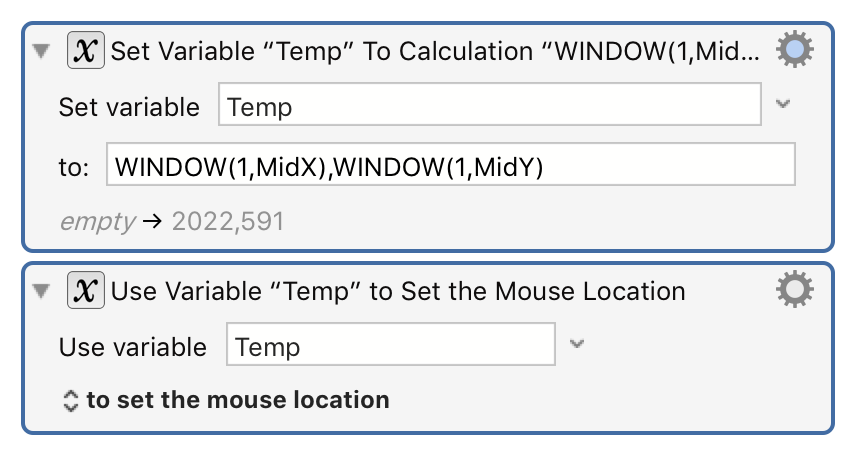
will result in the mouse being placed at the center of the front window.
Note: You must use commas for this purpose, and full stops (.) for decimal numbers, and never use any thousands separators, regardless of your desired language.
Expressions
Keyboard Maestro’s expressions include precedence, nested bracketed expressions, many built-in functions, various numeric bases, so you should be able to write almost any expressions you might like to use, as well as use it as a general purpose calculator if desired.
Operators
Operators based on precedence from lowest to highest are:
Array Separator (,) | Allows a text Variable, which has comma separated values, to work somewhat like an Array. Assume MyKMVariable contains “12,34,56”, then MyKMVariable[2] returns “34”. |
Ternary Operator (?) | a=b ? 3 : 4 |
Bitwise OR (|), Bitwise AND (&) and Bitwise XOR | bitwise operators, which also act as logical boolean operators for 0 (false) and 1 (true). |
Comparison Operators (<, ≤, =, >, ≥, ≠) | compare for (in)equality and return 0 or 1. |
Shift Operators (≪, ≫) | shift a number left or right. |
| Arithmetic Addition Operators • Add ( +)• Subtract ( -) | Basic mathematical operations. |
| Arithmetic Multiplication Operators • Multiply ( *)• Divide ( /) | Basic mathematical operations. |
Modulo (i MOD n) | The remainder of the division of i by n.Both values ( i, n) will be treated as integer.n must not be 0.The sign of the result is the same as the sign of i. |
Integer division (i DIV n) | The integer quotient of the division of i by n.Both values ( i, n) will be treated as integer.n must not be 0.The sign of the result matches the sign of regular division. |
Power Operator (^) | exponentiation. |
Unary Prefix Operators (√, -, ( ) ) | square root, negation, sub-expressions. |
| Functions | a large variety of functions. |
| Numbers and Variables or Array Accesses (5,$5A,0x50,8#007,Variable,Variable[5]) | identifiers and values. |
Unary Postfix Operators (!,%,°)) | factorial, percent, degrees. |
Numbers are in decimal by default, but may use base 16 if they start with $ or 0x (eg $5A or 0x5A), or may start with a specific base followed by a # (eg 8#007). Numbers may include underscores, for example 1_000_000 or 0xABCD_EF89.
Variables can be used if they contain numeric expressions, including an array of numbers separated by commas, in which case you can use an array index to select the desired number.
You can use either = or == for testing for equality.
Operators and functions must be in uppercase to minimize conflict with variables.
Functions
The available functions are listed on the wiki Functions page.
You can insert a function by name by choosing from the Edit ➤ Insert Function menu or choosing the Edit ➤ Insert Function by Name menu.
Variables
In numeric calculation fields, Variable Names are used without the % that are used in text token fields. Do not try to use tokens (like %Variable%MyVar%) in numeric calculation fields, just use MyVar by itself. The variable must contain a valid numeric value, or an expression that evaluates to a valid numeric value. So for example, if MyVar contains a text value of 2*3, then the calculation 4*MyVar will return 24.
Variable Array Access
If a variable contains a sequence of numbers separated by comma (,) then you can access that variable using array notation (eg MyVar[5]). So if variable MyVar has a text value of 10,20,30,40,50,60, MyVar[5] will return 50.
The index is itself an expression, so it can be arbitrarily complex.
Indices are 1-based, so MyVar[1] is the first element. If the index is 0, the size of the array is returned (so MyVar[0] would be 6). If the index is less than zero, the array is indexed from the end (so MyVar[-5] would be 20).
Screen Coordinates and Dot Notation
Keyboard Maestro refers to screen coordinates as two or four comma separated numbers in the text of a Keyboard Maestro Variable (which is always a string).
Screen object points, like the left,top position of a window, have two values, like 12,34.
Screen object rectangles, like the frame of a window, have four values 12,34,56,78 (with a fifth value for fuzz in some instances).
In a Calculation field you can reference the numbers in a Keyboard Maestro Variable (which is always a string) using dot notation:
| Variable.x | x coordinate |
| Variable.y | y coordinate |
| Variable.left | the left coordinate of a rectangle |
| Variable.top | the top coordinate of a rectangle |
| Variable.right | the right coordinate of a rectangle |
| Variable.bottom | the right coordinate of a rectangle |
| Variable.width | the width of a rectangle or size |
| Variable.height | the height of a rectangle or size |
| Variable.fuzz | the fuzz of an image match (rectangle,fuzz) |
| Variable.MidX | the horizontal middle of a rectangle |
| Variable.MidY | the vertical middle of a rectangle |
For example if the Variable myWindow is “12,34,56,78” then all of these forms of reference will provide a value of 34 in a Calculation field:
- myWindow[2]
- myWindow.y
- myWindow.Top
The Variable Name and Dot reference are case insensitive.
Text Fields
In calculation fields, you can express a calculation as you would normally write an expression, for example:
3 * Count + 7
However in a text field, since any text is allowed, you must use percent encoded tokens to indicate where more processing is required. You can include a variable in the text by using the %Variable% token, or you can use a calculation by using the %Calculate% token, or any number of other Tokens.
The result is %Calculate% 3 * Count + 7 %.
Examples of Variable Array Reference
Macro Actions
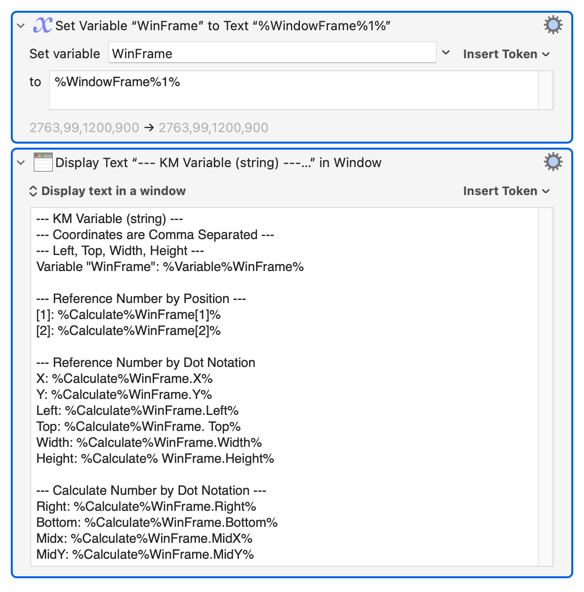
Example Results
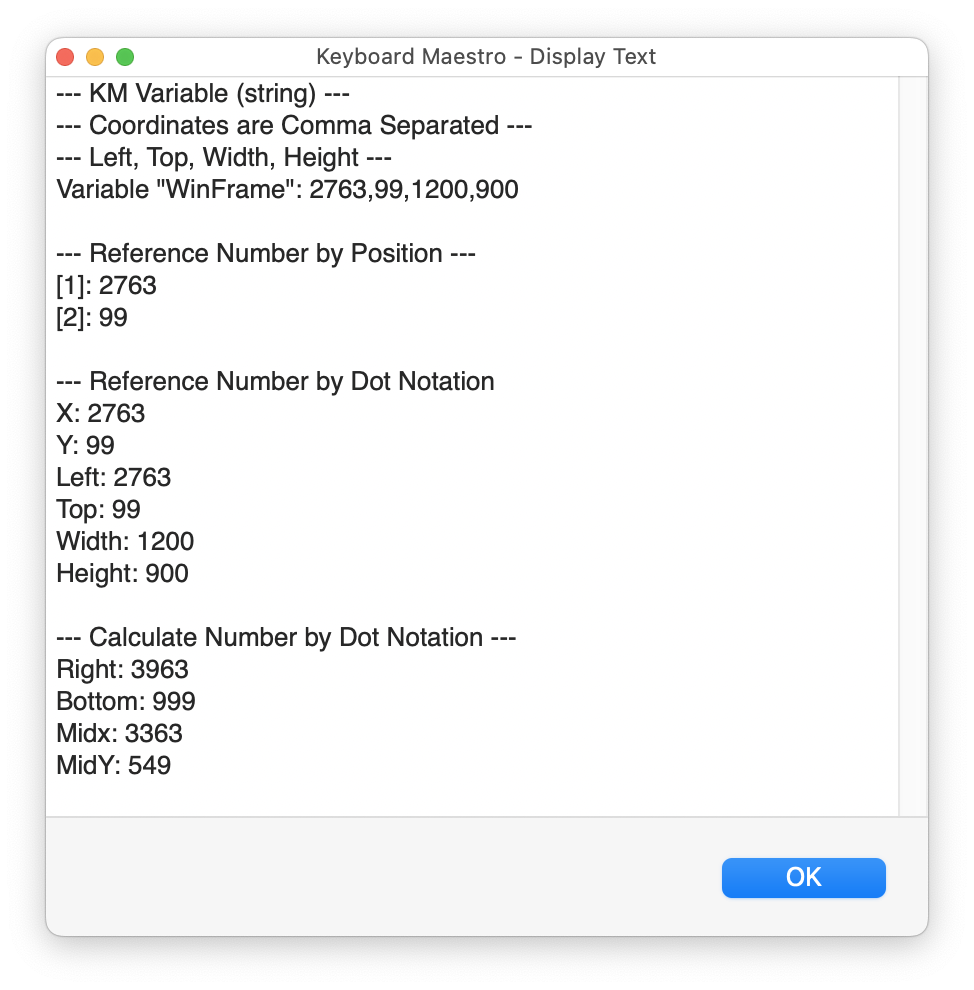
Example Expressions
Amount in Dollars * 100 MJD() > 55928 NOW() > TIME(2023,3,23,12,2,1) DOW(TIME(2023,4,4)) = 4 Radius*SIN(20°),Radius*COS(20°) Window Frame[1]+Window Frame[3]/2,Window Frame.MidY MOUSEBUTTON() + 2 * MOUSEBUTTON(4) SCREEN(Internal,Left,10%)
Conditions
Keyboard Maestro includes a variety of control flow actions which perform actions depending on a set of conditions.
The condition clause of the flow control actions can be any of:
- Any of the following are true – at least one condition must be true.
- All of the following are true – every condition must be true.
- None of the following are true – no condition is true.
- Not all of the following are true – at least one condition must be false.
This is followed by a set of specific conditions. If there are no conditions in the set at all, the action will not execute anything except theUntil action which will execute the actions once. Neither side of theIf Then Else action will execute.
The available conditions are listed on the wiki Conditions page.
Collections
Keyboard Maestro includes a For Each action which perform a sequence of actions repeatedly, once for each element of a collection.
Any time you have to deal with a set of things (lines, files, numbers, etc), you are probably thinking of a collection for which the For Each action is the answer.
The available collections are listed on the wiki Collections page.
Filters
Keyboard Maestro includes a variety of filters that can be applied to either the system clipboard, Named Clipboards, or variables. For clipboards, the filters preserve style information to whatever degree is possible. Use the Filter action to apply filters.
The filters are:
- Remove Styles (clipboards only, make the clipboard plain text).
- Set line endings to Mac (CR), Unix (LF) or Windows/DOS (CRLF).
- Trim Whitespace. (Remove leading and trailing whitespace from a string.)
- Hard wrap or unwrap paragraphs.
- Lowercase (all characters), Lowercase First (just the first character).
- Uppercase (all characters), Uppercase First (just the first character).
- Capitalize (all words) or Title Case (intelligently uppercase certain first letters).
- Sentence Case (first character of each sentence) (v11.0+).
- Change quotes to Smart, Dumb or French quotation marks.
- Encode HTML or non-ASCII HTML entities.
- Encode HTML with numeric entities.
- Decode HTML entities.
- Generate an HTML list.
- Percent Encode or Decode a URL. Percent Encode will encode all non-alphanumeric characters.
- Encode for Regular Expression.
- Encode or decode Base64.
- Calculate MD5.
- Styled Text to/from RTF plain text (v11.0+).
- Quote for AppleScript, JavaScript, Shell (bash) Script, Swift, JSON or Process Tokens.
- Convert a JSON object string to Compact or Pretty format.
- Get parent of a path.
- Get the filename component of a path.
- Get the base name of the path (ie the filename without directory or extension).
- Get or delete the path extension.
- Get the display name of a path.
- Expand tilde (~) paths, or abbreviate with a tilde.
- Resolve symlinks, or standardize the path.
- Get the URL scheme, host, port, user, password, path, fragment or query.
- Sort, reverse (first⇔last), or shuffle (permute) lines.
- Delete or bullet (•) control characters.
- Calculate an expression and return the result, see the Calculations section.
- Process Text Tokens and return the result, see the Tokens section.
- Get the value of a named Variable or Named Clipboard.
- Count the characters, words or lines and return the result.
We will likely expand the list of possible filters, so if you have specific filtering needs that you think might be of general interest, please let us know.
You can also process text using an AppleScript or shell script, for example the shell script:

is roughly equivalent to the Lowercase filter, except that it only works with ASCII characters.
Dictionaries
Keyboard Maestro includes permanently stored dictionaries that you can use or set.
A dictionary is a named set of mappings from a key name to a value. You can have multiple dictionaries, each with their own name (so really, it is a set of mappings from a dictionary name and a key name to a value).
Dictionary names start with a alphabetic character, followed by any number of alphanumeric, space or underscores. Dictionary names are case insensitive.
Key names can be anything, although leading and trailing white space is stripped off. Key names are case insensitive.
Dictionary values are plain text and can include leading or trailing white space.
For example, you might have a dictionary named “Shop Prices”, with keys being the item names and values being the cost of the item.
| Dictionary | Key | Value |
|---|---|---|
| Shop Prices Shop Prices Shop Prices | Coffee Cake Drink | 3.45 5.35 2.50 |
Setting Dictionary Values
Accessing Dictionary Values
You can use the %Dictionary% token to access Dictionary values.
%Dictionary[Shop Prices,Cake]%
%Dictionary[Shop Prices,%Variable%local_KeyName%]%
%Dictionary[%Variable%local_DictName%,%Variable%local_KeyName%]%
You can list the dictionaries with the Dictionaries collection, and you can list all the keys within a dictionary with the Dictionary Keys collection.
AppleScript
You can read and write dictionary values from AppleScript.
- snippet.applescript
tell application "Keyboard Maestro Engine" set dictionaryNameList to name of dictionaries end tell
- snippet.applescript
tell application "Keyboard Maestro Engine" set newDict to make new dictionary with properties {name:"Shop Prices"} # If you don't set a key/value pair the newly created dictionary above goes up in smoke. tell newDict make new dictionary key with properties {name:"Coffee", value:"3.50"} end tell end tell
- snippet.applescript
tell application "Keyboard Maestro Engine" set dictKeyList to dictionary keys of dictionary "Shop Prices" end tell
- snippet.applescript
tell application "Keyboard Maestro Engine" set value of dictionary key "Coffee" of dictionary "Shop Prices" to "4.50" end tell
See Also
See also the Set Dictionary Value action, the %Dictionary% token and the Dictionaries and Dictionary Keys collections.
JSON
Keyboard Maestro includes comprehensive support for JSON (JavaScript Object Notation), which is a formalized lightweight data-interchange format.
JSON objects consist of one of:
- An array, surrounded by square brackets and with comma-separated values, eg
[ 1, "2", 3, "4" ]. - A dictionary (aka, object), surrounded by curly brackets with comma-separated key-value pairs, eg
{ "one" : 1, "two" : "2" }. The Key must be a properly formatted, double quoted, string. - A double quoted string, eg
"hello". Strings can contain various backslash-escaped characters, including",/,\,b(backspace),f(form feed),n(linefeed),r(carriage return),t(tab), andufollowed by four hex digits to make a unicode character. - A number.
true- boolean truefalse- boolean falsenull- null (missing or absent value)
JSON terminology refers to dictionaries as “objects”, but also the whole thing as a JSON object, so generally within Keyboard Maestro it will be referred to as a JSON dictionary when talking about a specific dictionary formatted part of a JSON object, and object when it could be any of the various forms. A JSON container would be an array or a dictionary.
JSON Paths
Keyboard Maestro introduces the concept of a JSON Path. This is similar to the concept of an XPath, and there are other similar but unrelated JSON path concepts around, and they have similar intentions, but none of these are the same, or have the same syntax.
In Keyboard Maestro, for a variable named J, and JSON Path might look like:
J[2+3].fieldname{%Variable%FieldName%}
This would assume that variable J holds a JSON array, and would extract the fifth element. Then it would assume that contains a dictionary and look for the field named “fieldname”. Within that, it would assume that contains a dictionary and look for a field named by the variable FieldName.
After the variable name, the format of the path is any of:
- “[” followed by a numeric calculation, followed by “]”. The result of the calculation will be used to look for an indexed element in the array, or for a matching named element in a dictionary.
- “{” followed by token text, followed by “}”. The result of the text will be used to look for a matching named element in a dictionary, or for an indexed element in an array.
- “.” followed by the field name. Field names are trimmed of leading or trailing whitespace - if your object field names can start or end with white space, you need to use the
{ field name }notation.
Array indices are 1-based. Negative indices count from the end of the array. The 0 index of an array access will return the count of the number of entries in the array. When evaluating the index, the context sensitive COUNT() function will return the number of elements in the array.
Keyboard Maestro will use arrays and dictionaries more or less interchangeably, so:
- J[3]
- J.3
- J{3}
will all return the third element of an array, or the dictionary value for key “3”. An important distinction is that the first one is a numeric calculation, the second one is plain text, and the third one is token text.
Pretty, Compact and Strict Flags
Many of Keyboard Maestro’s operations that produce a result from JSON have two flags associated with them: Compact or Pretty; Strict or Not-Strict.
- Compact means all extraneous white space is omitted from JSON results.
- Pretty means JSON results will include white space to format the JSON in a relatively readable manner.
For example, if the variable J contains the text { "a" : 3, "b" : null }, then the result of %JSONValueCompact%J% will be:
{"a":3,"b":null}
whereas the result of %JSONValuePretty%J% will be:
{
"a" : 3,
"b" : null
}
The exact indentation should not be assumed, it might be any number of spaces or tabs.
The Strict flag relates only to JSON results that are trivial JSON strings, eg JSON "result".
- Strict means even for trivial JSON strings, the result will be a properly double quoted string (eg
"result"). - Non-Strict means that for trivial JSON string results, the result will return just the resulting string without any double quotes and with any escaping removed/evaluated. This will be more useful in some situations, but will lose the ability to distinguish between strings, numbers and
null.
For example, if the variable J contains the text { "a" : 3, "b" : "hello\n\"there\"\n" }, then the result of %JSONValueStrict%J.b% will be:
"hello\n\"there\"\n"
whereas the result of %JSONValue%J.b% will be:
hello "there"
The Strict/Non-Strict flag will have no effect unless the result is a trivial JSON string - if the result is a JSON object or array, or a number or true, false, or null, the result will be the same either way - objects and arrays will be inherently strict, and numbers and true/false/null will be unadorned.
The default result format is Compact, Non-Strict.
Use
There are actions to set dictionaries or variables from JSON containers, as well as an action to set a field within a JSON object to a specified value.
Notes
JSON objects must be properly legal to be processed. In particular keys to objects must be strings, which means strings must be quoted with double quotes. { a : 3 } is not valid, it must be { "a" : 3 }.
Decimal numbers may be processed by the system JSON APIs, which will store them as floating point, and floating point cannot store all decimal numbers with full fidelity. For example, if variable J contains [{ "a" : 3.45 }], then %JSONValue%J[1]% may result in {"a":3.4500000000000002}. If you need precision when dealing with JSON values, avoid decimal numbers.
Although 3 and "a" are technically legal JSON, in Non-Strict mode with cases of ambiguity, Keyboard Maestro will not consider a value or variable to contain JSON unless it is a container, ie an array or dictionary, which starts (without any leading white space) with a { or [, and ends with a matching bracket followed by optional white space.
Search Strings
Search Strings are filters which, in addition to the text you type, can include qualifiers that may be applied to searches for Macros and Actions in:
- The Keyboard Maestro Editor search field.
- A Smart Group.
- A Trigger Macro by Name action.
Keyboard Maestro will search for the text you type, and all of the below qualifiers that you specify, for matches in your list of macros. Each word is searched for separately (and in any order) unless you quote a phrase.
In the editor, matching actions and triggers will be highlighted with blue stripes:

Note that the Trigger Macro by Name action only searches among active macros.
Search Qualifiers:
The qualifier can generally be shorted to its shortest unique name, as shown in the Short Form column.
| Qualifier | Short form | Definition | Example |
|---|---|---|---|
| all: | al: | Match everything | all:(Otherwise the empty search string matches nothing) |
| word: | w: | Match that must be at a word boundary (Use quotes if Word contains spaces) | word:amp (Matches “Turn on amp” and not “example”) |
| group: | gr: | Match any macro within the named macro group (Use quotes if Name contains spaces) | group:"Forum Examples" |
| name: | n: | Match any macro that has a name matching the specified string | n:PDF |
| global: | gl: | Match any macro within any macro group that is globally active | global:(aka universal:) |
| application | app: | Match any macro that is specific to (or excluded from) the specified application | app:Finder |
| enabled: | e: | Match any macro that is enabled | e:(not necessarily active) |
| deprecated: | dep: | Match anything that uses deprecated features | dep: |
| trigger: | t: | Match any macro that has a trigger matching the specified string | t:=sig=(Typed String of “=sig=”) |
| action: | act: | Match an action with the specified action ID | action:1234(Action ID of “1234”) |
| hotkey: | h: | Match any macro with specified HotKey Match any macro with any HotKey if no HotKey is specified. Modifier Keys must be one of these: ⌃⌥⇧⌘ | h:⌘⌃C(CMD CTRL C) h:(Matches any HotKey) |
| created: | cre: | Match any macro that was created less that the specified time ago | cre:1w |
| modified: | mod: | Match any macro that was modified less that the specified time ago | mod:1d |
| used: | use: | Match any macro that was used less that the specified time ago | use:1m |
| size: | siz: | Match any macro that has a storage size more than the specified size | size:10000 |
| note: | not: | Match any action that contains the text in a Note | note:custom |
For the created:, modified:, used:, the parameter is a number followed by a letter (s for seconds, m for minutes, h for hours, d for days, or w for weeks).
You can use a negative sign (-) to negate any match (for example, “-name:PDF”).
Palettes
Keyboard Maestro can display a number of Palettes (or Toolbars).
There are four types of palettes:
- Global Macro Palette.
- Applications Palette.
- Conflict Palette.
- Macro Group palettes.
1. Global Macro Palette
Any macro with the Global Macro Palette trigger will be displayed in the Global Floating Palette. This palette appears whenever there is one or more active macros with this trigger, so it may appear and disappear depending on which macros are active (remember that Macro Groups control when a macro is active).

You can control the appearance of the Global Macro Palette in the Preferences.
2. Applications Palette
The Applications Palette shows the currently running foreground applications.
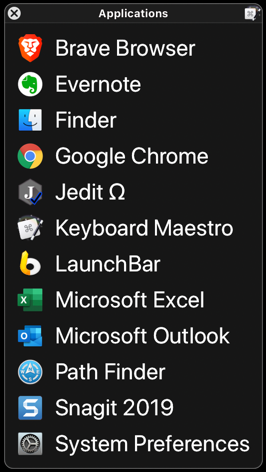
You can show/hide the Applications Palette in the General preference pane, or by choosing the Status Menu ➤ Show Applications Palette menu.
You can drag files on to the palette icons, and you can control click on them to perform various actions like hiding or revealing in the Finder. You can also hold various modifier keys down while clicking to perform the actions.
Applications can be excluded from the palette by selecting Exclude from Applications Palette in the contextual menu, or by adjusting the excluded applications in the Exclude preference pane.
You can order the applications alphabetically or by launch date by selecting Sort by Launch Date in the contextual menu.
You can control the appearance of the Global Macro Palette in the Preferences.
3. Conflict Palette
When you use the same trigger (such as a hot key, device key, or typed string trigger) that is assigned to more than one active macro, then Keyboard Maestro will display the Conflict Palette listing the triggered macros and let you select the desired macro, either by clicking on it or by typing a letter that narrows that palette down until only one macro remains at which point that macro is triggered.

You can use the Conflict Palette to limit the number of hot keys you need to remember by give a bunch of similar or related macros the same hot key and then selecting the desired macro with a further keystroke based on the now visible palette.
You can control the appearance of the Global Macro Palette in the Preferences.
4. Macro Group Palette
Any Macro Group can be configured to display as a palette. Since Macro Groups can be configured to be active only in specific applications, you can design Macro Group to display its palette only when a specific application is frontmost.

See Macro Group Setup Criteria (Advanced) for the various options for displaying palettes.
Control Order of Macros on Palette
You can control the order of macros in a macro palette (or the status menu) by prefixing their name with two characters and a closing parenthesis (eg “01)”). The macros will be sorted based on the code, but the code will be stripped off before display in the palette (or status menu).
For a great tool to aid in configuring the Palette for a Macro Group, see the Palette Organizer macro on the forum.
Controlling The Display of Palettes
Display More than One Palette
To have more than one macro palette, create a macro group for each desired palette and configure it to show a palette as desired. Put your macros in there. Create as many of these as you like. You can configure the Macro Group so that the macros are only active while the palette is displayed, so if you only display it occasionally, especially only for one action, then they can have very simple hot keys (like plain letters for example).
Nested Palettes
By using theShow Macro Group or Show Macro Group for One Action actions, you can display a macro group as a palette. This allows you to build nested palettes. For example, a palette could contain a number of macros that simply show different macro groups.
Enabling and Marking Macros
By using the Mark Macro or Unmark Macro actions, you can have macros shown in macro palettes (or status menus) appear ticked to indicate some state (for example an application dock that marks or unmarks the macro as the application launches or quits). Alternatively, you can enable and disable macros to have them appear or disappear from a macro palette. Either of these techniques will allow some level of dynamic behavior of palettes.
Appearance and Style
You can control the appearance of the palettes in the Preferences or in the macro group configuration. You can choose the style, the opacity of the palette, the size of the entries, the number of columns, whether the entries include the icon, the text and/or the trigger, the title bar, and whether the palette shrinks when the mouse is not over it. You can use the styling to build palettes that just display their icon for example, and combined with custom icons for your macros this can create a nice looking icon palette.
Recording
Keyboard Maestro has the ability to create macro action sequences by recording your actions.
For example, to create a macro that simulates keystrokes, rather than create each macro action individually you can enable recording and then simply type the keystrokes.
Keyboard Maestro can record the following actions:
- Moving a window
- Resizing a window
- Miniaturizing a window
- Clicking the mouse
- Typing a Keystroke
- Moving the scroll wheel
- Selecting a menu
- Activating an application
- Quitting an application
There are two ways you can use recording: when creating or editing a macro, or via a Record Quick Macro action.
Recording into a Macro
When you are creating or editing a macro, with the Macro Editor window displayed, simply click the Record button. After a short pause for you to get ready, recording will begin. To avoid the pause, hold the option key down while clicking the Record button).
Once recording starts, demonstrate the task you would like to perform using any of the above actions and Keyboard Maestro will record your actions directly into your macro.
While Keyboard Maestro is recording, it will display the Recording window.

While you are recording, you can pause the recording by clicking the Pause button in the Recording window.
Normally, Keyboard Maestro does not record pauses between actions, so the macro will play back at fast speed. However, you can add a 0.25 second pause to your macro by clicking the Clock button, or you can option-click the Clock button to turn on “real time”, and Keyboard Maestro will record a pause between each action which will simulate playback at approximately the same speed as you recorded.
When you are finished, click the Record button again to stop recording, or you can stop all recording by clicking on the Recording window.
Typically you will need to make a few adjustments to the Macro Actions to ensure the macro will operate robustly when used. Generally, use recording to create a base sequence of actions and then adjust as necessary.
Recording via a Quick Macro
The other way to use recording is via a Record Quick Macro action. When triggered, the Record Quick Macro immediately starts recording your actions into a private macro. When you have demonstrated the sequence of actions you want, trigger the Record Quick Macro action again. The sequence can now be executed via the specified Hot Key or the Status Menu or Macro Palette. For example, if the Record Quick Macro is triggered by pressing Control-F1, and the specified Hot Key is Option-F1, then if you typed:
Control-F1, h, e, l, l, o, Control-F1
Then each time you press Option-F1, Keyboard Maestro will type “hello” for you. One common use for this is if you want to adjust a sequence of lines in a systematic way. For example, if you had a list of colors, and wanted to change them in to a list of constants, say from this:
color Red color Green color Blue
to
const int kRed = "Red"; const int kGreen = "Green"; const int kBlue = "kBlue";
You could do this with grep and regular expression, replacing “color (.*)” with “const int k\1 = “\1”;”, which is fine if you can remember how to do grep with regular expressions, whether it is \1 or $1, and whether the application you are in supports regular expressions or not. But perhaps a simpler way is to just show Keyboard Maestro how to do the first line and then let it do the others with a single keystroke each.
So move the cursor to the start of the first line, press Control-F1, then the sequence:
Option-Shift-Right Arrow, Delete, Forward Delete, Command-Shift-Right Arrow, Command-X, c, o, n, s, t, <space>, i, n, t, <space>, k, Command-V, =, ", Command-V, ", ;.
Finish with Command-Left Arrow, Down Arrow to carefully put the cursor at the start of the next line. Now press Control-F1 again to finish the recording, and Option-F1 twice to translate the next two lines.
Record Quick Macros can record the same set of actions that normal recording can, however because you cannot see or edit the recorded actions it is wise to keep them simple, preferably just a sequence of keystrokes. Typically, recorded Quick Macros will be used immediately and not reused, but they are saved and remain available until you record over them.
Macro Library
The macro library is a place where we can provide you with a variety of ready-made macros for optional addition to your macro collection.
To use the library, choose the Window ➤ Macro Library menu to display the macro library. You can then look through the available macros and insert any you'd like to use into your macros. You can then use them as is, or configure the new macros, perhaps changing the hot keys or adjusting the macros to your liking.
Each macro comes with a short description to tell you what it does, so scroll through them to see all the possibilities, and click on them to get more details.
All the default macros that come with Keyboard Maestro are included in the Macro Library, so if you have deleted one and later think it might be useful it will always be available there to re-install it.
You can also download new potential macros from us or from friends or colleagues or the forum. You can also share your own macros with other Keyboard Maestro users by exporting your clever macros.
Keep in mind that macros can do practically anything on your Mac, including cause a huge amount of damage, so you should never execute a macro without verifying the source and better yet, checking exactly what it does.
You can export a set of macros to a macro library file, which you can share with others, and you can import .kmlibrary files into your macro library. Note that currently there is no way to delete imported macro library entries from your Macro Library except by quitting Keyboard Maestro and Keyboard Maestro Engine and removing the files from the ~/Library/Application Support/Keyboard Maestro/Keyboard Maestro Libraries folder.
Generally, for macros you want to share, it is better to export them as macros, or use the Share button at the top the editor window, or choose from the File ➤ Share menu.
For some other example macros, you can also look at the Macro Library on the wiki.
Macro Examples
A typical simple Macro consists of a single Hot Key trigger, such as Control-A, together with a single action, such as the Insert Text by Typing Action that will “type my address” .
For some real examples, see the forum topics:
You can also use the Macro Library by choosing the Window ➤ Macro Library menu to see some built in examples.
Here are a number of example and suggestions for Macros to give you some ideas of how you can get the most out of Keyboard Maestro and your Mac. For tips on how to remember which Hot Key executes which action, see the Remembering Macro Hot Keys section.
Launch Your Most Used Applications
Use function keys to launch or switch to your most used applications. For example, you probably often switch to the Finder, your Email client, your Web Browser, your Word Processor. Consider putting these and other frequently used applications on function keys.
Open Your Most Used Documents
Use Control-Function Keys to open your most used documents. For example, you might have a documentation file or financial details file that you access frequently, consider putting these on Control-Function Keys.
Insert Text Templates
Use Control-Letter and the Insert Text action to type in text for you, such as your name, address, phone number, and so on. Consider restricting these to just the appropriate applications like your Email client or Word Processor by creating a Macro Group for them. Also consider using Typed String triggers for these sorts of macros, for example “=em=” for email address and “=addr=” for address. The text you insert can be typed, pasted as plain text, or can be fully styled text.
Use Hot Keys to Open Financial Accounts
If you keep your finances on your computer, then you probably need to open a document every time you enter a bill or receive a statement. By creating a Hot Key to open the document for you, you can save a few seconds every time – at least it might make receiving a bill slightly less unpleasant! If you have multiple accounts (eg personal, business, association) then this can be even more useful.
Use Hot Keys to Connect to SSH or Web Sites
You could use Hot Keys to connect to your common servers. You might use the Open a URL action, or you could create a Bookmark file for the site and use the Open a File action.
Simulate Bookmarks
Use the Click Browser Link and Browser Form Actions to open web pages, fill in fields, submit forms, follow links. For example, you could use this to log in to the city library for all the members of your family, one in each tab, to easily check what books are due back.
If you are going to use this to enter passwords, use the Set Variable to Keychain Password action to retrieve the password so that it is not stored in plain text in the macros.
Remap Command Keys
If you find yourself pressing a command key in an application and expecting it to do something but it does not work (for example, Command-T for “Replace and Find Again”), use a Macro to make the command key “do the right thing” in that application. Similarly, if you use a function in an application frequently, but it has a convoluted command key or no command key at all, define your own command key by using a Hot Key to select the menu item.
Keep in mind that you can do some menu key remapping in the System Preferences Keyboard preference.
Simulate Missing Features
If you find yourself missing a feature in one application that you are used to in another application (perhaps you switched email clients and a feature is missing), see if you can simulate the feature with a sequence of commands and then use a Hot Key for that. For example, Close Window, Down Arrow, Return to move to next email message, or Command-Left Arrow, Shift-Down Arrow, Command-C, Down Arrow, Command-V to duplicate a line.
Swap Characters
If you often type characters out of order, use a Hot Key to swap them by first placing the cursor between them and then executing:
- Simulate Keystroke Shift-Right Arrow
- Cut to Named Clipboard “Temp”
- Simulate Keystroke Left Arrow
- Paste from Named Clipboard “Temp”
Save a Text Clipping
If you often want to save snippets of text, you could create a Hot Key to save a clipping:
- Copy
- Open File “Clippings.rtf”
- Simulate Keystroke Command-Down Arrow
- Insert Text “== %LongDate% %ShortTime% ==<return>” by Typing
- Paste
- Simulate Keystroke Return
- Simulate Keystroke Return
- Select Menu Item File » Save
- Manipulate Window Close Front Window
- Switch to Last Application (or Quit Specific Application or Command-Q)
Delayed Click
Setup a macro which simply pauses for twenty seconds and then clicks the mouse. Then when you need to print on to an envelope, go all the way through the process, position the mouse over the Print button, execute the Macro, walk over to the printer, insert an envelope and then take the printed envelope back with you.
Insert Boilerplate Text
If you regularly need to insert boilerplate text (eg copyright or file creation text), use an Insert Text macro to insert the text quickly and easily. It can even expand tokens to insert the date or other information.
Apply Text Conversions
If you are regularly translating text from one format to another in an automatic process, perhaps you can automate the whole thing with a macro. For example, converting function declaration in a header file into function definition.
Simulate Workspaces
Create a macro to setup an application to your liking. For example, create multiple tabs in Terminal, each in its own directory, or open multiple documents in TextEdit, each positioned and sized appropriately.
Setup an Application When Launched
If you always do a set of things every time you launch an application (eg arrange the windows in a particular way), use an application Macro Trigger to execute a Macro when you launch the application, then have the Macro do the work for you.
Clean Up After Using an Application
If you always do something after quitting an application (eg unmount a server or disconnect from the Internet), use an application Macro Trigger to execute a Macro when you quit the application. You might need to do a little AppleScripting to perform the action and then use the Execute an AppleScript action.
Launch Scanner Application When Scanner is Connected
Set up a macro that automatically launches your scanner application when your scanner is connected, and quits it again when the scanner is disconnected. This works brilliantly with the ScanSnap scanners – open the lid and the scanner software launches, close it and the scanner software disappears.
Switch Network Location When You Connect
Set up a macro that automatically changes your Network Location when you connect to your home or work wireless network.
Feedback During Macro Execution
A Macro can play a System Beep or use the Speak Text action to speak directly.
You can also use the Alert action to display a window with specified text. This also allows you to stop the macro if you decide not to proceed.
Icon Chooser
Keyboard Maestro includes an Icon Chooser and creator to allow you to select custom icons for your macro groups and macros.
You can display the Icon Chooser by choosing the Window ➤ Icon Chooser menu.
![]()
Click on an image well for a macro or macro group (in Edit mode), and then click on an icon in the Icon Chooser to select it.
The Icon Chooser includes three panes with different icons:
- Internal – all the icons Keyboard Maestro normally uses.
- Applications – all the icons Keyboard Maestro can find on your Mac.
- Character – icons you create based on a character.
The Character Icon Choose pane allows you to create your own custom icons by setting a few simple parameters. You can set the background and foreground color, shape, and an optional character:
![]()
When you have a Macro or Macro Group icon well selected, and you make any change in the Icon Chooser, or if you click the icon in the Icon Chooser, then the icon for the Macro/Macro Group will be set.
To load the Icon Chooser from an existing Macro or Macro Group, select the icon well of the Macro/Macro Group and then open the Icon Chooser (close it first if necessary).
If an icon well is not selected when you open the Icon Chooser, then it will retain the settings that were last used.
Note that icons configured from the Icon Chooser will be very small in storage size in your macros. Icons set any other way will take up more storage in your macros.
To transfer an icon from one macro to another, copy it from the icon well in the source macro and paste it in to the target macro image well.
Application Launcher
The Activate Application Launcher macro is a highly specialized macro action that enables you to launch applications. By triggering the macro, the Application Launcher enables you to launch any applications in your Applications or Utilities folder, as well as any recently running applications. Once the launching window appears, you may select the application to launch, and Application Launcher will launch it for you.
The applications are also listed in the Status Menu, so you can launch applications that way if you prefer.
By default, Keyboard Maestro creates a Activate Application Launcher macro in the “Switcher Group” Macro Group, triggered by Command-Control-Tab. You can disable this Macro by selecting the Switcher Group, then selecting the Activate Application Switcher macro and clicking the ✓ button below the Macros list. You can edit this macro to change the trigger to any other desired Hot Key.
Application Switcher
The Activate Application Switcher action macro is a highly specialized macro action that enables you to launch, switch, hide, and quit applications. By triggering the macro, the Application Switcher enables you to switch between all running applications. Once the switching window appears, you may select the application to activate, and Application Switcher will take you to it.
The Activate Application Switcher action lets you choose from three themes (vertical list, horizontal icons, or icon grid), as well as configure the icon size, color tint, and the sort order.
You can also choose to hide other applications when switching (Keyboard Maestro also has a preference in the General preference pane to always hide other applications when switching).
You can select various applications to always be displayed, even if they are not currently running, perfect for launching frequently used applications. In the Excluded preference pane, you can configure various applications to never be displayed.
While the Application Switcher window is displayed, you can perform various actions:
- Press “q” to mark (or unmark) an application to be quit.
- Press “k” twice to mark an application to be force quit.
- Press “s” or “h” to mark (or unmark) an application to be hidden.
- Press “l” or “z” to mark (or unmark) an application to be launched.
- Press “a” to hide (or show) “always included” applications.
- Press “e” to show (or hide) “always ignored” applications.
- Press “j” to show (or hide) “recently quit” applications.
- Press “c” to select the current application.
- Press “f” to select the Finder.
- Press “d” to switch directly to the current application and hide other applications.
- Press “i” to Get Info on the current application.
- Press “r” to reveal the current application in the Finder.
If you click and hold down on any icon, a menu with these options will appear. Using the menu, you can also configure the switcher to:
- Switch just the front window instead of all windows.
- Reopen windows when switching.
By default, Keyboard Maestro creates a Activate Application Switcher macro in the “Switcher Group” Macro Group, triggered by Command-Tab. You can disable this Macro by selecting the Switcher Group, then selecting the Activate Application Switcher macro and clicking the ✓ button below the Macros list. You can edit this macro to change the trigger to to any other desired Hot Key avoid replacing the system application switcher.
Window Switcher
The Activate Window Switcher macro is a highly specialized macro action that enables you to show, hide, and minimize windows. By triggering the macro, Window Switcher enables you to switch between all open windows in the current application. Once the switching window appears, you may select the window to activate, and Window Switcher will bring it to the front.
While the Window Switcher window is displayed, you can perform various actions:
- Press “q” to mark (or unmark) an application to be closed.
- Press “s” to mark (or unmark) an application to be minimize.
By default, Keyboard Maestro creates a Activate Window Switcher macro in the “Switcher Group” Macro Group, triggered by Control-Tab. You can disable this Macro by selecting the Switcher Group, then selecting the Window Switcher macro and and clicking the ✓ button below the Macros list.
Clipboard History Switcher
The Clipboard History Switcher is in essence a Clipboard Manager. Whenever you copy something from any app, the Keyboard Maestro Engine saves a copy of the System Clipboard at that time to the Clipboard History file.
The Clipboard History Switcher allows you to:
- Save a copy of the System Clipboard every time you make a copy from anywhere.
- Paste any previous saved clipboard in your History
- View all of the Clipboards in your History
- Perform special operations before you paste, like convert to plain text
- Merge multiple Clipboards into one new Clipboard
- Paste multiple Clipboards with a user-selected delimiter
- Trigger Your Custom Macros to operate on the selected Clipboard.
- Saves up to 200 items (the number is user adjustable in the Preferences).
A typical display of the Clipboard History Switcher looks like this:

The Clipboard History Switcher will also shown information such as the size and dimensions of images, and the character, word and line count of text.
How To Use
Display the Clipboard History Switcher
The Clipboard History Switcher is displayed using the Activate Clipboard History Switcher Action. You can find a Macro that uses this Action in the Switcher Group Macro Group (which comes installed with Keyboard Maestro).
Pasting from the Clipboard History Switcher
- To Paste the Selected Clipboard as is, do any of these:
- Double-Click on the Clipboard.
- Press the Return or Enter key.
- Click on the Paste button.
- Right-click on the Clipboard and select “Paste”.
- Drag a Clipboard entry onto App document.
Hold the Shift key while pressing return or double clicking to paste as plain text.
Hold the Option key while pressing return or double clicking to just set the system clipboard.
Command-Numbers will paste the corresponding entry. Command-Shift-Numbers will paste in plain text, and Command-Option-Numbers will just set the system clipboard.
Toolbar
Most of these Toolbar buttons operate on the selected Clipboard.
The buttons from left to right are:
- Toggle between the Clipboard History and the Named Clipboards.
- Cut the current application selection to the Clipboard History.
- Copy the current application selection to the Clipboard History.
- Paste the current Clipboard History selection.
- Mark the current Clipboard History selection as a favorite (so it will never be deleted).
- Quick Look at the current Clipboard History selection.
- Send the current Clipboard History selection to another Mac running Keyboard Maestro.
- Delete the current Clipboard History selection.
- Toggle whether the Clipboard History Switcher will close after pasting.
- Toggle showing additional information.
You can search the Clipboard History with the search field, and limit the display to Images-only (v11.0+) or Favorites-only.
Gear & Context Menu
This menu is available by either clicking on the Gear ⚙ Button on a Clipboard, or by right-clicking anywhere on a Clipboard.
Most of the these menu items are designed to operate on one or more Clipboards, and produce a new Clipboard, which can later be pasted if desired.
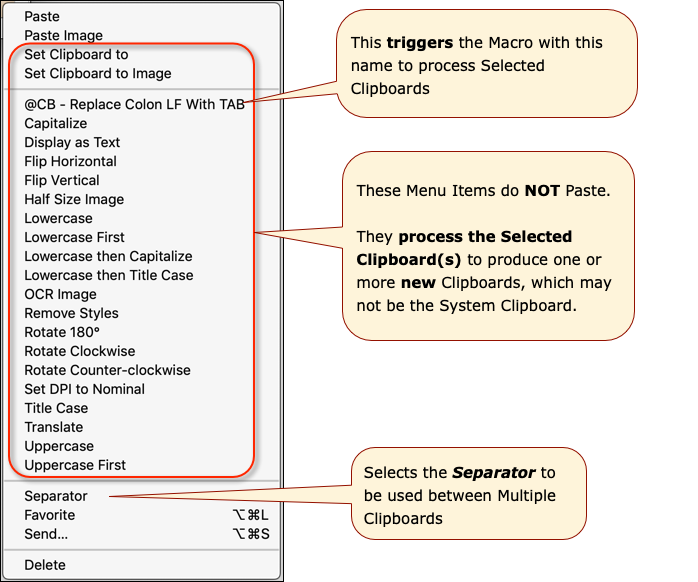
You can add entries to this menu using the Clipboard Filter trigger.
Operating on Multiple Clipboards
Select two or more Clipboards (using standard macOS multiselection), and then you can:
- Paste them as a single unit, or
- Press ⌘C to merge them to the System Clipboard.
The Gear ⚙ menu includes a selection for the separator to include between each item when pasting multiple entires. If multiple images are selected, merging them creates a single larger image (horizontally or vertically, depending on the separator).
Other Operations
- Passwords – Clipboard entries that resemble passwords are obscured, deleted after they reach position ten in the clipboard history, and not saved to disk. You can option click on an obscured password to reveal it.
- Send to another Mac
- You can send clipboards to another Mac running Keyboard Maestro.
- The receiving Mac will show the received clipboard entries in the clipboard history (assuming the Keyboard Maestro Web Server is enabled on the destination Mac).
Preferences
Excluding Clipboards from Selected Apps
Keyboard Maestro keeps a copy of everything you copy automatically each time you copy something. You can exclude certain applications (for example, badly behaved applications or applications that often have very large clipboards) using the Preferences > Excluded Preferences Panel in the Keyboard Maestro Editor app.
Hidden Preferences
The default Maximum Number of Items stored in the Clipboard History is 200.
This along with several other features may be changed with the Preferences.
By default, Keyboard Maestro creates a Clipboard History Switcher macro in the “Switcher Group” Macro Group, triggered by Command-Control-Shift-V. You can disable the Macros by selecting them in the Macros window pane and clicking the ✓ button.
Keyboard Maestro also has many macros in the Macro Library, such as macros for Paste Plain Text (Command-Shift-V) and Paste Previous Clipboard (Command-Control-V).
Named Clipboard Switcher
The Named Clipboard Switcher enables you to define any number of named clipboards which can be use to Cut or Copy into and Paste from in any application. To use the Named Clipboard Switcher you simply trigger the Named Clipboard Switcher macro. The Named Clipboard Switcher will present you with a window allowing you to select the named clipboard to use.
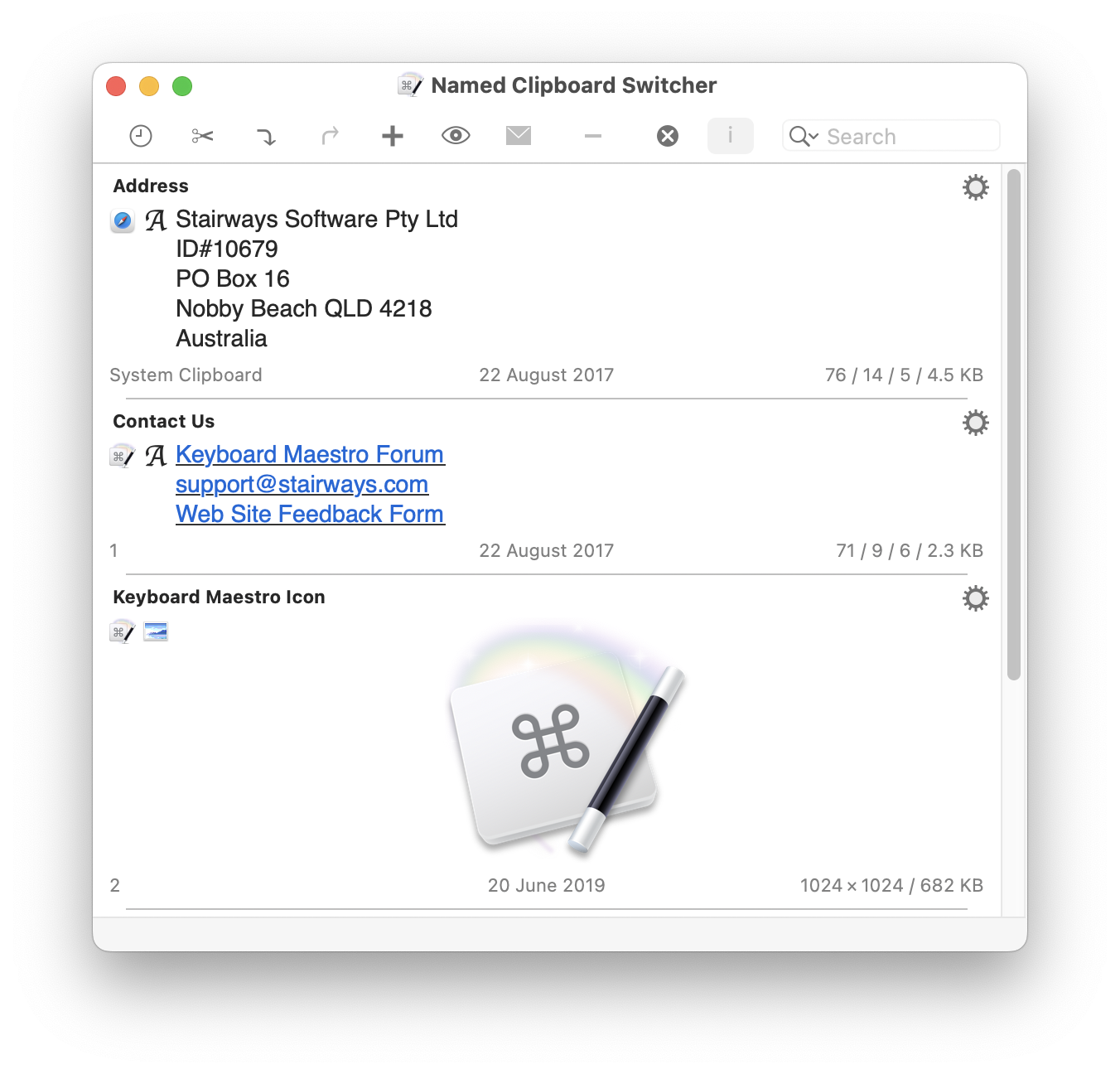
You can press arrow keys to scroll through the clipboard entries, or you can use type-ahead to select a named clipboard, and you can use the search field to filter the clipboards.
You can cut or copy the current selection into the selected clipboard, or paste the selected clipboard into the current selection (hold down the shift key to paste as plain text).
You can drag text and images out from the clipboard switcher to other applications.
You can include information about the clipboard entry (index, time copied, size) by toggling the i button. Whether the switcher closes when you paste something is controlled by the x button. The switcher honours the text size setting in the Preferences.
In the ⚙ menu in each clipboard entry, you can Cut, Copy or Paste to/from the item or use it Set the System Clipboard, optionally removing styles or forcing it as an image. You can also Rename or Delete the item.
You can select multiple entries and paste them as a single unit. The ⚙ menu includes a selection for the separator to include between items when pasting multiple entires.
Any active macros that have the Clipboard Filter trigger will be displayed in the ⚙ menu. They can use the Trigger Clipboard facility to operate on the selected clipboard, allowing you to make macros that apply to any selected clipboard (for example, save the clipboard to disk, or uppercase it).
You can toggle to the Clipboard History Switcher by clicking on the 🕘 button.
By default, Keyboard Maestro creates three Named Clipboard Switcher macros in the “Switcher Group” Macro Group, triggered by Command-Shift-X, C and V (Cut, Copy and Paste). You can disable the Macros by selecting the Switcher Group, then selecting the macros and and clicking the ✓ button below the Macros list.
You can add or delete named clipboards in the Clipboards preference pane.
Preferences
To configure Keyboard Maestro, first launch Keyboard Maestro and choose Preferences from the Keyboard Maestro menu.
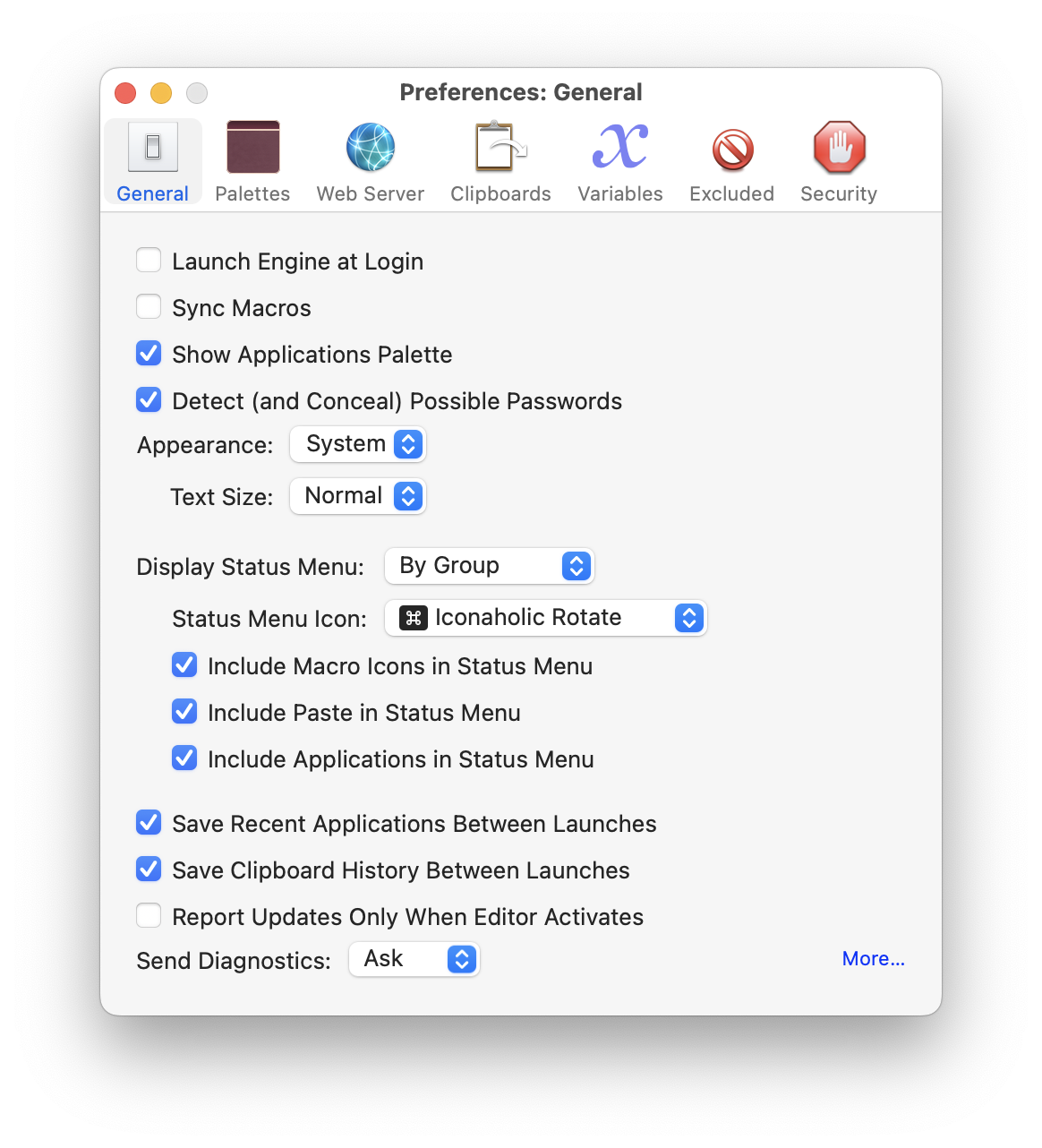
The preferences are divided into sections.
General Preferences
In the General preference pane you can:
- enable or disable launching the Keyboard Maestro Engine at Login.
- enable or disable macro syncing.
- Show or hide the Applications Palette.
- configure whether to detect clipboards that resemble passwords and obscure them.
- configure the light/dark appearance (macOS 10.14+).
- configure the default text size used in various places.
- configure whether and how to show the status menu.
- configure the style of the status menu.
- configure whether to include macro icons in the status menu.
- configure whether to include pasting clipboards in the status menu.
- configure whether to include applications in the status menu.
- configure whether to save the recent applications between logins.
- configure whether to save the clipboard history between logins.
- configure whether to only notify about updates when the editor launches.
- configure whether to send diagnostics (crash reports).
Palettes Preferences
In the Palettes preference pane you can adjust the style of the default palette, the Global Macro Palette, the Applications Palette, and the Conflict Palette.
You can configure the Conflict Palette to be placed under the mouse or to have it remain where you place it.
You can configure the Conflict Palette to include entries in the Touch Bar.
Web Server Preferences
In the Web Server preference pane you can:
- enable or disable the web server.
- configure the username, password and port of the web server.
- enable or disable web browser access.
- enable or disable iPhone access.
- enable or disable receiving clipboard entries.
- enable or disable replacing the current clipboard.
- access the web server in your default browser by clicking on Connect.
The web server is disabled by default.
If the web server and web browsing are enabled, then anyone who can connect to your Mac can execute any macro that has a Public Web trigger.
If the web server and web browsing are enabled, and if you have configured a username and password, then anyone who can connect to your Mac and login with the specified username and password can execute any of your macros.
If the web server and iPhone access are enabled, and if you have configured a username and password, then anyone who can connect to your Mac from an iPhone and login with the specified username and password can execute any of your macros.
If the web server and receiving clipboard are enabled, then anyone can send you clipboards which will appear in your clipboard history. By default they do not overwrite the current clipboard, but you can enable that to allow the current clipboard to be directly written remotely.
Macros are still only available when they are enabled and their containing macro group is enabled and active.
You can configure custom styles using the defaults write command to add a custom style, for example:
defaults write com.stairways.keyboardmaestro.editor WebServerCustomStyles -string 'body { background: green; }'
This might be useful if you are controlling multiple Macs and want to differentiate them more clearly.
Clipboards Preferences
In the Clipboards preference pane you can add, remove and rename Named Clipboards and see and change their values.
Named Clipboards store snippets or text or images (or anything the clipboard can hold) and you can copy or paste from them using the Clipboard Switcher or using appropriate macro actions.
You can paste an image into a Named Clipboard by selecting it in the list and pasting an image (if you select part of the text, it will paste the image into the styled text, which works but is probably not what you want).
Variables Preferences
In the Variables preference pane you can add and remove variables and see and change their values.
You do not need to create variables, just using them and giving them a value is all that is required for them to spring into existence.
You can also inspect variables and other values in the Value Inspector.
Excluded Preferences
In the Excluded preference pane you can add and remove applications from the global excluded applications list. Excluded applications will not be shown in the Application Switcher, and are (optionally) not hidden or quit by the Hide All Applications or Quit All Applications actions.
You can add and remove applications from the Applications Palette exclusion list. Excluded applications will not appear in the Applications Palette. You can also exclude applications by control or right clicking on them in the Applications Palette and selecting Exclude from Applications Palette.
You can also add and remove applications from the clipboard history exclusion list. When an excluded application is at the front, Keyboard Maestro will not automatically record the clipboard history each time it changes. It will still read the current System Clipboard if you explicitly ask for it in a macro or open the Clipboard History Switcher.
Security Preferences
Keyboard Maestro is designed to act on your behalf and to do many things for you - essentially acting as you in performing tasks. As such, it needs a wide variety of security permissions to perform these tasks.
This preference panel aims to summarise the important preferences and allow you to explicitly request them as needed.
Preferences Set by Command Line
You can configure various preferences using defaults write from the Mac OS X Terminal. Some preferences will take effect immediately, but others may require the editor or engine to be relaunched. These preferences are documented here only to provide utility. Their behaviour may change in the future, or have unexpected consequences.
Editor
You can adjust the get mouse location delay with:
defaults write com.stairways.keyboardmaestro.editor MouseGetCountdown -int 5
You can adjust the spelling of Favorites with:
defaults write com.stairways.keyboardmaestro.editor FavoritesDisplayName -string "Favourites"
You can turn off automatic completion (autocomplete) with:
defaults write com.stairways.keyboardmaestro.editor AutomaticCompletion -bool NO
You can limit the maximum undo stack size in the editor with (default 200MB):
defaults write com.stairways.keyboardmaestro.editor MaximumUndoSize -int 200000000
You can add some custom styling to the detail view displays with:
defaults write com.stairways.keyboardmaestro.editor DetailDisplayExtraStyle -string 'div.ActionComment div.UserText { font-family:"Monaco"; }'
You can set your preferred first day of the week (1=Sunday, 7=Saturday):
defaults write com.stairways.keyboardmaestro.editor FirstDayOfWeek -int 2
You can disable all animation in the editor with:
defaults write com.stairways.keyboardmaestro.editor DisableAnimation -bool YES
You can configure the fonts used for the various action text views with:
defaults write com.stairways.keyboardmaestro.editor Font-Normal -string "Monaco" defaults write com.stairways.keyboardmaestro.editor Font-Fixed -string "Monaco" defaults write com.stairways.keyboardmaestro.editor Font-Shell -string "USER" defaults write com.stairways.keyboardmaestro.editor Font-AppleScript -string "FIXED" defaults write com.stairways.keyboardmaestro.editor Font-JavaScript -string "SYSTEM" defaults write com.stairways.keyboardmaestro.editor Font-Swift -string "Times" defaults write com.stairways.keyboardmaestro.editor Font-HTML -string "Courier:25" defaults write com.stairways.keyboardmaestro.editor Font-JSON -string "Marker Felt:10" defaults write com.stairways.keyboardmaestro.editor Font-Comment -string "Palatino:20"
The value of this field can be one of “USER”, “FIXED” or “SYSTEM” (for the default user, fixed and system fonts), or a font name. This can optionally be followed by a colon and the point size. The default point size is 13. The font size is scaled based on the Large Text setting, and this size is used for the Normal setting.
Clipboard
If you wish to effectively disable the Keyboard Maestro Clipboard History, you can do so by setting the history size to zero, and then Keyboard Maestro will only read the clipboard when you explicitly ask it to use the clipboard.
You can set the following preferences for the Clipboard History
Maximum Number of Items (default 200)
defaults write com.stairways.keyboardmaestro.engine MaxClipboardHistory -int 200
If you set the max number of items to zero, then the Copy action will fail.
Maximum Clipboard Flavor Size (default 100MB)
defaults write com.stairways.keyboardmaestro.engine ClipboardFlavorMaximumSize -int 100000000
Multiple Clipboard Separator (default Return)
The separator added if you paste multiple items from the Clipboard Switcher can be configured in the gear menu or set to something else with the command:
defaults write com.stairways.keyboardmaestro.engine MultipleClipboardSeparator " and "
Ignored Clipboard Flavors
You can add additional clipboard flavors to be ignored using:
defaults write com.stairways.keyboardmaestro.engine ExtraIgnoredClipboardFlavors "com.whatever.badflavor"
The string should be a bar (|) separated list of flavors (technically a regular expression). These flavors will be excluded from the clipboard when Keyboard Maestro reads the clipboard.
You can also write to IgnoredClipboardFlavors, which will set the entire list of ignored clipboard flavors, but that is a bad idea since the flavors that are ignored, are ignored for a reason, and overwriting the list will produce negative results.
Maximum Position of Concealed (Password) Items (default 10)
defaults write com.stairways.keyboardmaestro.engine MaxConcealedPosition -int 10
Regular Expression Which Matches Text You Think Should or Should Not Be Concealed as Passwords
defaults write com.stairways.keyboardmaestro.engine LooksLikePassword -string "^[a-zA-Z0-9]+$" defaults write com.stairways.keyboardmaestro.engine LooksLikeNotPassword -string "^[a-zA-Z0-9]+$"
Include Microsoft PDFs in Clipboards
Microsoft applications include a PDF flavor with every copy, and starting up the PDF rendering engine is slow, making the first copy after launching a Microsoft application. Keyboard Maestro excludes PDF flavors from clipboards copied in Microsoft applications by default, but you can turn this off with:
defaults write com.stairways.keyboardmaestro.engine ExcludeMicrosoftPDFFlavor -bool NO
Include Microsoft Image Formats
Microsoft applications also include flavors for every possible image format with every copy. Keyboard Maestro excludes secondary image flavors like BMP when there is a PNG or TIFF flavor available. You can turn this off with:
defaults write com.stairways.keyboardmaestro.engine ExcludeMultipleImageFlavors -bool NO
AppleScript OSA Command
You can set the command line tool that is used to execute AppleScripts
defaults write com.stairways.keyboardmaestro.engine OSAScriptCommand -string "/usr/bin/arch -i386 /usr/bin/osascript"
Browser Used in Actions & Tokens
Change which Safari-based Browser will be targeted by the “Safari” Actions, Tokens, and Functions.
These preferences change the AppleScript Application name that is used to control the respective browser in the form of tell application “<browser name>”. Note that the Safari browser must still behave like Safari, and the Chrome browser must behave like Chrome, or the actions will not work. Do not bother trying to set them to Firefox or something like that as it will not work. All this allows you to do is select a specific version of Safari or Chrome respectively.
You can configure which Safari-based Browser is targeted in Safari Actions, as well as the name of the Safari browser shown in the actions:
defaults write com.stairways.keyboardmaestro.engine AppleScriptSafariBundleID -string "com.apple.SafariTechnologyPreview" defaults write com.stairways.keyboardmaestro.engine BrowserSafariName -string "Safari Tech"
Change which Chrome-based Browser will be targeted by the various Keyboard Maestro “Chrome Related” Actions, Tokens, and Functions.

# ~~~ For Brave Browser ~~~ defaults write com.stairways.keyboardmaestro.engine AppleScriptGoogleChromeBundleID -string "com.brave.Browser" defaults write com.stairways.keyboardmaestro.engine BrowserGoogleChromeName -string "Brave Browser" # ~~~For Chrome Canary ~~~ defaults write com.stairways.keyboardmaestro.engine AppleScriptGoogleChromeBundleID -string "com.google.Chrome.canary" defaults write com.stairways.keyboardmaestro.engine BrowserGoogleChromeName -string "Chrome Canary"
To restore the defaults back to use Google Chrome, just delete the preferences:
# ~~~ Restore to Google Chrome ~~~
defaults delete com.stairways.keyboardmaestro.engine AppleScriptGoogleChromeBundleID
defaults delete com.stairways.keyboardmaestro.engine BrowserGoogleChromeName
Add additional Browsers to the Front Browser Actions, Tokens, and Functions.
The current list of browsers supported in Keyboard Maestro as a potential front browser include:
- com.apple.Safari
- com.apple.SafariTechnologyPreview
- com.google.Chrome
- com.google.Chrome.canary
- com.brave.Browser
- com.brave.Browser.beta
- com.vivaldi.Vivaldi
- com.vivaldi.Vivaldi.snapshot
- com.microsoft.edgemac
Plus whatever browser is specified as the Safari or GoogleChrome above.
You can add additional browsers supported as the Front Browser by including their bundle IDs in the AdditionalWebBrowserBundleIDs preference. You can list as many as you like, separated by spaces or commas.
defaults write com.stairways.keyboardmaestro.engine AdditionalWebBrowserBundleIDs -string "com.example.Safari,com.example.Chrome"

Tokens
Tokens are limited to 0.9 seconds in execution time, and are executed somewhat asynchronously in Ventura and later. You can control this with:
defaults write com.stairways.keyboardmaestro.engine TokenTimeout -float 0.9 defaults write com.stairways.keyboardmaestro.engine ForceSynchronousTokens -bool YES
Engine Animation
You can disable all animation in the engine with:
defaults write com.stairways.keyboardmaestro.engine DisableAnimation -bool YES
Typed String
You can disable Shift-Space from clearing the Typed String buffer with:
defaults write com.stairways.keyboardmaestro.engine TypedStringClearWithShiftSpace -bool NO
and you can disable clicks from clearing the Typed String buffer with:
defaults write com.stairways.keyboardmaestro.engine TypedStringClearWithMouse -bool NO
and you can set the idle time for clearing the Typed String buffer (default 5 seconds) with:
defaults write com.stairways.keyboardmaestro.engine TypedStringClearTime -float 5.0
You can disable modifiers taps in the Typed String buffer with:
defaults write com.stairways.keyboardmaestro.engine AllowModifiersInTypedStrings -bool NO
Use Unicode for Keystrokes
You can force Keyboard Maestro to simulate keystrokes only as Unicode characters, rather than typing them as you would on the keyboard
defaults write com.stairways.keyboardmaestro.engine ForceInsertTextByTypingToUseUnicode -bool YES
Hot Key Triggers
You can set the maximum key down trigger time for Hot Key triggers (default 10 seconds)
defaults write com.stairways.keyboardmaestro.engine MaxKeyRepeatTime -float 10.0
You can configure the timing of a “tap” (Hot Key and USB Device Key triggers) with:
defaults write com.stairways.keyboardmaestro.engine MaxTapDownTime -float 1.0 defaults write com.stairways.keyboardmaestro.engine MaxTapUpTime -float 1.0
The default allowable down time is the double click interval, and the default allowable up time is twice the double click interval.
Sounds
You can silence the clipboard transfer sounds with:
defaults write com.stairways.keyboardmaestro.engine SilenceClipboardSounds -bool YES
And you can silence the recording sounds with:
defaults write com.stairways.keyboardmaestro.engine SilenceRecordingSounds -bool YES
Recordings
You can adjust the recording delay with:
defaults write com.stairways.keyboardmaestro.engine RecordingCountDown -int 5
Note: you can option click the Record button to avoid the delay.
You can have all recorded clicks recorded in absolute coordinates by default with:
defaults write com.stairways.keyboardmaestro.engine AlwaysRecordAbsoluteClicks -bool YEA
By default, clicks are recorded relative to the front window, if that window has remained the front window and retained its size and position for some time. Note that for a short time after recording, you can change the relative field in the action, and the values will update to appropriate values.
Conflict Palette
You can have the conflict palette use sequential hot keys from the first letter with:
defaults write com.stairways.keyboardmaestro.engine SequentialConflictPalette -bool YES
Status Menu
You can set configure whether the Status Menu includes the Paste submenu and how many items it includes with:
defaults write com.stairways.keyboardmaestro.engine StatusMenuIncludePaste -bool NO defaults write com.stairways.keyboardmaestro.engine StatusMenuPasteCount -int 30
Display Large Text
You can set configure Display Large Text color and display period with:
defaults write com.stairways.keyboardmaestro.engine DisplayLargeTextColor -string "502033" defaults write com.stairways.keyboardmaestro.engine DisplayLargeTextDisplayPeriod -float 5.0
By default recorded clicks do not restore the mouse location, but you can change that with:
defaults write com.stairways.keyboardmaestro.engine RecordedClickRestoresMouseLocation -bool NO
Notifications
You can control which notifications are displayed with:
defaults write com.stairways.keyboardmaestro.engine "Notification-Information" -bool NO defaults write com.stairways.keyboardmaestro.engine "Notification-MacroExecution" -bool NO defaults write com.stairways.keyboardmaestro.engine "Notification-MacroCancelled" -bool YES defaults write com.stairways.keyboardmaestro.engine "Notification-ActionFailed" -bool YES defaults write com.stairways.keyboardmaestro.engine "Notification-ReceivedClipboard" -bool YES
Software Updates
You can have new versions reported only when the editor activates with:
defaults write com.stairways.keyboardmaestro.engine ReportUpdatesWhenEditorActivates -bool YES
Prompt With List Show All Limit
You can set the limit for the maximum number of items shown by default in the Prompt With List action with:
defaults write com.stairways.keyboardmaestro.engine PromptWithListShowAllLimit -int 100
When there is more items than this in the list, by default the action will not show the items as the list may be too long to be practical.
WebKit Inspector for HTML Prompt
You can enable the WebKit inspector with:
defaults write com.stairways.keyboardmaestro.engine WebKitDeveloperExtras -bool YES
Then you can control-click on elements and use Inspect Element and get an inspector window, including a Console tab.
Custom Palette Theme
You can configure a custom palette theme color style with:
defaults write com.stairways.keyboardmaestro.engine CustomPaletteTheme -string "0,90,74, 110,90,74, 256,90,74"
The style includes 3 or 6 HSB colors (being background, text, highlighted letter, selected background, selected text, selected highlight letter) each specified as hue,saturation,brightness. The background brightness is dropped by 33%, but if there are only three colors, then the selected background color is the background without the 33% drop. You can select the Custom style in the Theme Editor.
Alternatively, you can specify the theme using JSON and including all the details for the theme including optional gradients. The format is:
{
"IncludeTexture":<BOOLEAN>,
"TitleBackground":<COLORorGRADIENT>,
"TitleBorder":<COLORorGRADIENT>,
"BodyBackground":<COLORorGRADIENT>,
"BodyBackgroundSelected":<COLORorGRADIENT>,
"Frame":<COLOR>,
"TitleText":<COLOR>,
"Text":<COLOR>,
"TextHighlighted":<COLOR>,
"TextSelected":<COLOR>,
"TextSelectedHighlighted":<COLOR>,
}
| Type | Value |
|---|---|
| <BOOLEAN> | “true” or “false” |
| <COLOR> | an array of three numbers, being hue (0-360), saturation (0-100), and brightness (0-100) |
| <COLORorGRADIENT> | either a <COLOR> or a dictionary {“c1”:<COLOR>, “c2”:<COLOR>, “angle”:<0-360>} |
IncludeTexture specifies whether Keyboard Maestro includes the subtle mottling texture on the main background.
For example:
defaults write com.stairways.keyboardmaestro.engine CustomPaletteTheme -string '{
"IncludeTexture":false,
"TitleBackground":{"c1" : [180,30,53], "c2" : [180,30,40], "angle":270},
"TitleBorder":[180,30,40],
"BodyBackground":{"c1" : [180,30,50], "c2" : [180,30,38], "angle":270},
"BodyBackgroundSelected":[180,30,60],
"Frame":[180,30,40],
"TitleText":[180,40,92],
"Text":[180,40,92],
"TextHighlighted":[180,40,70],
"TextSelected":[180,40,98],
"TextSelectedHighlighted":[180,40,75],
}'
Note that the “-string” is important - otherwise the defaults command will interpret the JSON itself and that will not work.
Scripting
Executing Scripts
The following Execute Script Actions are provided to execute a variety of script languages:
You can specify the script to be executed either by reference to a file or as text entered directly in the Execute Action. After pasting or typing script text into the Execute Script Action, press the Enter key to compile and format the script.
For example, the Execute an AppleScript action:
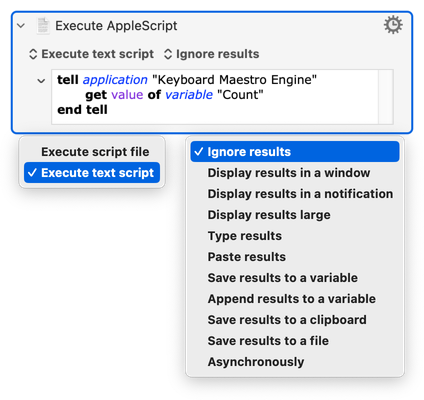
There are two setup options:
| Setup Option | Choices (Default shown first) |
|---|---|
| Script location | Execute text script (type or paste script into Action text field) Execute script file (This may be faster if it is a compiled script file .scpt) |
| Script Results | Ignored. Displayed in a floating window. Displayed briefly in a Notification. Displayed large across the screen. Typed in the current text field that has focus. Pasted in text field that has focus. Saved to a Keyboard Maestro Variable. Appended to a Keyboard Maestro Variable. Saved to the System or a Named Clipboard. Saved to a file. Ignore the results and run Asynchronously (the script runs while the macro continues on to the next Action). |
Using the Clipboard
You can also read and set the clipboard in a script, although the easiest way to set the clipboard to the results of a script is to select the Execute Script Action option to “save results to clipboard”. This works for plain text and some images returned by the script. For more complex formats, you will need to set the Clipboard directly in the script.
For more information about using the Clipboard in scripts, see:
- The unix man pages for pbcopy, pbpaste.
Automating Applications and Adding Functionality to Keyboard Maestro
AppleScripts, JavaScript for Automation scripts, Shell scripts, and Swift scripts, give you a powerful way of adding new facilities we have not specifically provided for, as well as controlling other applications.
Web Page Interactions
The Execute a JavaScript in Browser actions enable deep control over a web page, as well as extracting specific data from both the page contents and HTML.
Shell Scripts
Shell scripts can execute any installed scripting language, such as perl, python, ruby or whatever. Be aware that because shell scripts are executed in a non-interactive shell, typically none of the shell configuration files (like .login or .profile) will be executed, which may change the way the shell script behaves.
Variables can be accessed from shell scripts via the environment variables in the form $KMVAR_Variable_Name where KMVAR_ is prefixed, and spaces are converted to underscores. AppleScripts can also access the environment variables using the system attribute command, but note that system attribute is not safe for international characters.
Note that the total size of the variables stored in the environment is limited by the system to 100K, so larger variables may be excluded to ensure the variables do not take up excessive amounts of environment space.
Variables whose names start with “ENV_” override regular environment variables (eg “ENV_PATH” overrides the regular “PATH” environment variable).
AppleScript
AppleScripts can perform many tasks on the Mac and control many applications.
You can read and write variables, dictionaries and control the Keyboard Maestro engine with AppleScript:
tell application "Keyboard Maestro Engine" set calcResult to getvariable "Calculation Result" -- If the Keyboard Maestro Variable does not exist, the AppleScript Variable will be set to empty string setvariable "Calculation Result" to (calcResult + 10) -- If the Keyboard Maestro Variable does not exist, it will be created end tell
JavaScript for Automation
JavaScript for Automation (JXA) can access Variables with:
var kme = Application("Keyboard Maestro Engine"); var oldValue = kme.getvariable('Calculation Result'); kme.setvariable('Calculation Result', { to: 10 });
For details on JXA, see JavaScript for Automation. This provides an introduction to JXA and comparison with AppleScript.
JavaScript
JavaScript in web browsers can access the variable values by using the kmvar dictionary, like kmvar.Variable_Name (spaces are converted to underscores), but they have no way to write values back to variables, except by returning a result from the script.
User Interaction
AppleScripts and JavaScript For Automation scripts are executed in the background via osascript. This means they are not allowed to do user interaction. You can work around this by asking an application like System Events to do the user interaction for you, for example:
tell application "System Events" activate display dialog "Hello" end tell
See also the Variables section.
Controlling Keyboard Maestro Engine via Scripting
The primary scripting interface to Keyboard Maestro Engine is the Keyboard Maestro Engine’s do script support. You can ask Keyboard Maestro Engine to:
- execute a macro by name
- execute a macro by unique ID
- execute an action given its XML code
Note in most cases you must tell “Keyboard Maestro Engine”, not “Keyboard Maestro”.
The easiest way is to use the name, for example:
tell application "Keyboard Maestro Engine" do script "[Name of Your Macro]" end tell
The macro must be defined and enabled, and the macro group must be enabled and currently active.
If there is more than one macro with the same name, you will get an error, so you can use a UID instead of a name.
tell application "Keyboard Maestro Engine" do script "D0C150C7-8A0C-4837-918A-427E2BCFB6B9" end tell
The do script will not return until the macro is finished executing. The Return Result action can be used to return a result to the AppleScipt.
You can pass an optional parameter using the with parameter clause, which you can read in the macro as the %TriggerValue% token.
You can determine a macro’s UID by selecting it and choosing Copy UID command in the Copy as sub-menu in the Edit menu.
An even more powerful way to script Keyboard Maestro is to execute specific actions based on their XML code. This allows you to construct any action, including changing the action on the fly, without having to create a macro first. A simple example would be:
tell application "Keyboard Maestro Engine" do script "<dict><key>MacroActionType</key><string>SwitchToLastApplication</string></dict>" end tell
The easiest way to determine the appropriate XML is to create an example action in an example macro and then choose Copy as XML in the Copy as sub-menu in the Edit menu.
You can read information about the existing macros using the gethotkeys and getmacros commands. See the Keyboard Maestro Engine AppleScript dictionary for more information.
Using Keyboard Maestro Facilities from AppleScript
Keyboard Maestro Engine makes several of its facilities available to AppleScript.
You can ask it to play a sound with:
tell application "Keyboard Maestro Engine" play sound alias "Harddisk:System:Library:Sounds:Glass.aiff" end tell
You can ask Keyboard Maestro Engine to perform a calculation for you with:
tell application "Keyboard Maestro Engine" set n to calculate "JULIANDATE()" end tell
or process tokens with:
tell application "Keyboard Maestro Engine" process tokens "%LongDate%" end tell
The calculate and process tokens commands can also take an instance parameter (v10.0+) to specify the instance for local variable access.
You can ask Keyboard Maestro Engine to find strings in other scripts:
tell application "Keyboard Maestro Engine" count found in "The Source" for ".e" with regex end tell
And you can search and replace with:
tell application "Keyboard Maestro Engine" search "3+4" for "(\\d+)" replace "%CalculateFormat%CALCULATE(\\1)%Currency%" with regex and process tokens end tell
Controlling Keyboard Maestro via Scripting
Macro Groups, Smart Groups, Macros, Triggers, Actions are all available via AppleScript. So you have deep control over controlling the Keyboard Maestro editor itself, allowing you to automate creating macros in a variety of different ways.
You can disable or enable a Macro Group (or similarly Macro) from AppleScript with:
tell application "Keyboard Maestro" set enabled of macro group "Macro Group Group Name or UID" to true/false end tell
Alternatively you can use the Set Macro Enable action.
You can rename, create, delete, duplicate macro groups and macros. You can add and remove actions. You can get or set the selection.
You can start editing a Macro or Macro Group from AppleScript with:
tell application "Keyboard Maestro" editMacro "Macro/Macro Group Name or UID" end tell
See the Keyboard Maestro AppleScript dictionary for more information.
Controlling Keyboard Maestro Engine via Scripting
You can adjust Keyboard Maestro Engine windows with:
tell application "Keyboard Maestro Engine" set bounds of window "Clipboard History Switcher" to {1000, 50, 2000, 1200} end tell
URL Schemes
Editor
Another way you can control Keyboard Maestro editor is using the “keyboardmaestro” URL scheme, which supports the following formats:
| Example Editor URL Command | Description |
|---|---|
keyboardmaestro://u=support%40stairways.com/s=ABCDEFGH0123456789 | Enter your username/serial number. |
keyboardmaestro://m=Activate%20Application%20Switcherkeyboardmaestro://m=D2F427A1-51E3-4719-820B-4C25B6FF7329 | Edit a specific macro or macro group. You may used either the Macro Name, or UUID. |
keyboardmaestro://q=Activate | Filter macros with this keyword. |
keyboardmaestro://g=All%20Macros/q=Activate | Select a macro group and filter macros with this keyword. |
keyboardmaestro://a=Execute | Filter actions with this keyword. |
keyboardmaestro://c=All%20Actions/a=Execute | Select action category and filter actions with this keyword. |
Triggers
You can trigger a macro (that is Active and Enabled) using the “kmtrigger” URL scheme. The URL uses this format:
kmtrigger://macro=<Macro Name or UUID>[&<Trigger Value>]
where
<Macro Name or UUID>is either the Macro Name, OR, its UUID<Trigger Value>is the optional Trigger Value[ ]are not included. Used only to show optional parameters&must precede the Trigger Value, if it is provided.
Note both Macro Name and Trigger Value must be URL encoded.
You can easily get the Trigger URL by clicking on the “Or by Script” Trigger option, and selecting “Or by URL”.
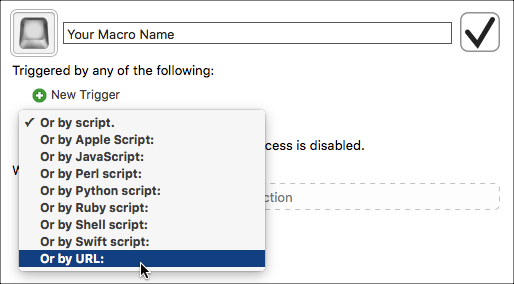

| Example Trigger URL Command | Description |
|---|---|
kmtrigger://macro=Your%20Macro%20Name | Using the Macro Name |
kmtrigger://macro=224AA8CB-07EB-4C92-8201-68FED82B6E9F | Using the Macro UUID |
kmtrigger://macro=Your%20Macro%20Name&value=Your%20Trigger%20Value | Using Macro Name with Trigger Value |
kmtrigger://macro=224AA8CB-07EB-4C92-8201-68FED82B6E9F&value=Your%20Trigger%20Value | Using Macro UUID with Trigger Value |
The kmtrigger URL will only work on the local Mac, but you can use the Remote trigger to trigger macros with a URL even from remote locations via the Keyboard Maestro trigger server.
Status Menu Icons
Keyboard Maestro allows you to select the status menu icon.
The current lovely status menu icons were done by Iconaholic, and you can also use the Classic finger tapping icons. As well as that, you can get more status menu icons from our web site or the forum and you can create and optionally contribute your own versions. You can drop a new status menu icon .zip archive on the Keyboard Maestro application dock icon to install it.
The format is fairly simple, you need a folder with the name of the icon (which must be unique relative to other contributed icons), and in that folder you have a sequence of files named StatusItem and then then the animated sequence StatusItem1, StatusItem2, etc. You can have as many as you like. If the icon is a template icon (black and clear only), then add the word “Template” to the name. And finally the extension can be either .tiff or .png. The file should be either a 16×16 icon, or ideally a retina tiff file with both a 16×16 and 32×32 at 144dpi (you can create the retina-ready tiff files using tiffutil -cathidpicheck, or you can use a tool like Opacity.app).
The two default icon folder structures look like this:
- Classic
- StatusItem.tiff
- StatusItem1.tiff
- StatusItem2.tiff
- StatusItem3.tiff
- StatusItem4.tiff
- StatusItem5.tiff
- StatusItem6.tiff
- Iconaholic
- StatusItemTemplate.tiff
- StatusItem1Template.tiff
- StatusItem2Template.tiff
- StatusItem3Template.tiff
- StatusItem4Template.tiff
Note that the “Template” appears at the end, after the animation index, and there are no spaces anywhere. You can have spaces in the folder name.
Then you archive the folder into a zip file named NameStatusMenuIcon.zip (eg ClassicStatusMenuIcon.zip) and drop it on the Keyboard Maestro application dock icon or email it to us with a cover letter indicating your permission for it to be distributed, as well as your name to be published with an optional URL if desired.
Plug In Actions
You can develop custom Macro Actions using a facility known as Plug In Actions. After you install a Plug In Action in your local Keyboard Maestro Support folder, you can use them like the built-in Actions.
Third Party Plug In Actions
You can download Plug In Actions developed by others from these sources:
How to Install
Plug In Action Install Files are .zip Archive Files
- Initial Install: Drop on the Keyboard Maestro app Dock icon
- This will create a Plug In Action sub-folder by the same name as the
.zipfile - Do not unzip the file
- To Update An Existing Plug In Action
- First Manually Delete or Move the Plug In Action Sub-Folder from:
~/Library/Application Support/Keyboard Maestro/Keyboard Maestro Actions/ folder - Then Drop the
.zipfile onto the Dock Icon
How To Use a Plug In Action
Plug In Actions are used just like the built-in Keyboard Maestro Actions.
After you have installed a Plug In Action, you may need to restart both the Keyboard Maestro Editor and Engine in order for the new Plug In Action to be recognized by Keyboard Maestro.
- In the Keyboard Maestro Editor, goto File > Quit Engine.
- Quit and re-launch the Keyboard Maestro Editor. This will also start the Engine.
To insert a Plug In Action into your Macro, use any of the normal methods to insert Actions:
- Display the Actions Panel from the menu or with the shortcut ⌘K, and select the Third Party Plugins folder:
- Menu Edit > Actions > Third Party Plugins
- Insert Action by Name, using shortcut ⌘⌃A.
Enter the Plug In Action form fields (parameters) that are shown on the action form.
Building a Plug In Action
How to Create a Plug In Action
There is no easy way to create a Plug In Action. There is no one editor (except maybe BBEdit) that can be used to create all of the files that are needed. Probably the best way to get started is to examine an existing Plug In Action, like this one:
- Fixed Wait for Safari to Finish Loading Plug In Action by @PeterNLewis.
Steps to Create a Plug In Action
- Folder: Create a folder on your local drive, using the same name that you will use for the Plug In Action, put the following files in this folder.
- Plist: Create a file named Keyboard Maestro Action.plist, which is a standard Cocoa Property list file that defines the Plug In Action form.
- See Plug In Action Plist Definition below.
- The Plug In Action Plist is an XML which defines the Action form you see in the Keyboard Maestro Editor, and identifies the name of the script file that will be run when the Plug In Action is executed in a triggered macro.
- Script: Create a script file named Action.scpt, or other suitable name (like the name of your Plug In Action), which can be an AppleScript, JXA, or Shell Script, to process the data from the Plug In Action form.
- Icon: Create icon.png which is the icon that will be displayed in the Keyboard Maestro Editor. This file is optional.
- Zip Install File: When you are finished with all of these files, create a
.ziparchive from the Plug In Action Folder.
Plug In Action Folder
A Plug In Action is Contained in a Folder, Whose Name:
- Should generally closely match the action name
- Must be made up of only ASCII alphanumerics, underscores and spaces.
- Must be unique among all plug in actions.
- Is stored in the Keyboard Maestro Macros.plist to reference the plugin action.
The Plug In Action folder contains a set of files, including:
- Keyboard Maestro Action.plist – an XML file describing the action.
- A script file
- whose name must be made up of only ASCII alphanumerics or underscores, plus an ASCII alphanumeric extension.
- It may be a shell script or an AppleScript.
- If it is a shell script, it will be made executable automatically.
- Icon File: 64×64 png icon (optional).
The Plug In Action Folder must be stored as a .zip archive file for installation.
Plug In Action PList
The format of the Keyboard Maestro Action.plist is a Cocoa Property list containing a dictionary with the following keys and values:
| Key | Description |
|---|---|
| Name | Name of the action. (which appears in the Category/Actions list) |
| Script | Name of the script file which will be run when the Plug In Action is executed. The name can only use ASCII alphanumerics or underscores, plus an ASCII alphanumeric extension |
| Parameters | An array of parameters to the script
|
| Icon | Name of the icon png file, made up of only ASCII alphanumerics or underscores plus .png Optional |
| Title | The title displayed on the action
|
| Timeout | The default timeout in seconds
|
| Author | The author of this action Optional |
| URL | URL for the author or this action Optional |
| Help | A short (Tool Tip) explanation of this action Optional |
| HelpURL | A URL for the Help link for the action (v11.0+) Optional |
| Results | What to do with the output of the script if any. Possible Values:
Multiple values can be used, separated by a bar (|), the first specified value is the default. If output is going to a clipboard or a file, the results can be an image. |
Plist Parameters
| Parameter Key | Description |
|---|---|
| Label | Name of the parameter.
|
| Type | Type of the parameter. Must be one of the following: (Text in italics is info, and not part of the Type)
The Type specifies how the value is displayed to the user and what processing is applied before it is passed to the script. |
| Menu | Values of the popup menu, separated by | Optional unless Type is PopupMenu. |
| Default | Default value of the Parameter when the Plug In Action is inserted in the Macro. Optional |
Each parameter in the Parameters array is a dictionary with the following keys:
Warning: Keys are case sensitive.
Retrieving Parameters in a Script
Parameters are passed to the script via environment variables with names starting with KMPARAM_, similar to how variables are passed to shell scripts with the Execute Script action.
So a parameter named “My Text” would be in an environment variable KMPARAM_My_Text. Note that spaces in the variable names must be replaced with underscores in your script.
Methods To Retrieve Parameters Using AppleScript
--~~~~~~~~~~~~~~~~~~~~~~~~~~~~~~~~~~~~~~~~~~~~~~~~~~~~~~~~~~ --» 1. Use AppleScript "system attribute" --~~~~~~~~~~~~~~~~~~~~~~~~~~~~~~~~~~~~~~~~~~~~~~~~~~~~~~~~~~ -- This method is "not safe for international characters" (and emoji) set myText to system attribute "KMPARAM_My_Text" --~~~~~~~~~~~~~~~~~~~~~~~~~~~~~~~~~~~~~~~~~~~~~~~~~~~~~~~~~~ --» 2. Use Shell Script with "echo" --~~~~~~~~~~~~~~~~~~~~~~~~~~~~~~~~~~~~~~~~~~~~~~~~~~~~~~~~~~ -- This method works with emoji and international characters -- but multi-line text (as from a TokenText form field) -- will be flattened into a single line set myText to do shell script "echo $KMPARAM_My_Text" --~~~~~~~~~~~~~~~~~~~~~~~~~~~~~~~~~~~~~~~~~~~~~~~~~~~~~~~~~~ --» 3. Use Shell Script with "printenv" --~~~~~~~~~~~~~~~~~~~~~~~~~~~~~~~~~~~~~~~~~~~~~~~~~~~~~~~~~~ -- This works with emoji, international characters and multi-line text -- however printenv returns an error if KMPARAM_My_Text doesn't exist. -- You can catch this error with a try command. try set myText to do shell script "printenv KMPARAM_My_Text" on error -- Parameter does NOT exist set myText to "" end try
Reload to Use Updated Plug In Actions
In normal use, once a plug in action is read, it will stay in memory and changes will not be noticed (although the script will be executed each time, so changes to that will be noticed). To cause the editor and/or engine to notice changes to the plug while in development, use AppleScript to reload the macros:
tell application "Keyboard Maestro" to reload tell application "Keyboard Maestro Engine" to reload
Plug In Action Failure
If the Plug In script fails, the action will fail, potentially aborting the macro.
Windows
Welcome Window
This window welcomes new users and gives you some options for learning about Keyboard Maestro.

If you are new to Keyboard Maestro, start the tutorial and Keyboard Maestro will walk you through creating a simple macro.
Macros Window
This window lets you manipulate Macros and Macro Groups, creating new ones, deleting old ones, enabling and disabling them, editing them and so on.
You get this window pane by launching Keyboard Maestro.

The window contains a list of Macro Groups and their associated Macros.
You can create a new Macro Group by clicking the + button below the Groups list.
You can create a new Macro by selecting a macro group and then clicking the + button below the Macros list.
You can see the selected Macro Group or Macro in the right hand column, and edit it by clicking the Edit button.
You can select the All Macros meta-Group to show all Macros, and you can use the search field to filter down the list of macros.
You can rename a Macro Group or Macro by double clicking it and changing the title.
You can delete a Macro Group by selecting it and clicking the - button below the Groups list.
You can delete a Macro by selecting it and clicking the - button below the Macros list.
Similarly, you can enable or disable Macro Groups or Macros by clicking their respective ✓ button.
You cannot delete, rename or modify the Global Macro Group.
See also the Macro Groups, Macros and Macro Editor Window sections.
Tutorial
If you are new to Keyboard Maestro, start the tutorial by clicking the Start Tutorial button in the Welcome window or by choosing the Help ➤ Tutorial menu and Keyboard Maestro will walk you through creating a simple macro.

Follow the instructions. Keyboard Maestro will hilight the location of the various buttons to help you quickly create a macro. You can even use the tutorial as a wizard to create a hot key triggered macro to perform any of Keyboard Maestro’s many actions.
Macro Group Editor
To edit a Macro Group, select it and click the Edit button. Its details will be shown in the right hand column. You can edit its name, control which applications it is available in, and how it will be activated.

Typically a group’s macros would be available everywhere (available in all applications), or it might be specific to a particular application (available in the following applications) in which case you might name the Macro Group after the application.
You can also configure the macro group to be activated only after a Hot Key press (either for a single use or toggled on and off), and whether to display the macros in a floating palette.
See also the Macros section.
Macro Editor Window
To edit a Macro, select it and click the Edit button. Its details will be shown in the right hand column. You can edit its name, add or remove triggers, and configure its action list.

To add a trigger, click the green + button and select the type of trigger. To remove a trigger, click the red ⊖ button.
To see how to execute this macro via a script, select from the “Or by script”’ menu. How you can execute the macro remotely is also displayed.
To add an action, click the New Action button, or equivalently the + button below the detail view. This will show the lists of possible actions. Double click one or more of them to add actions to the action list for this macro.
You can also Copy and Paste actions, as well as drag them around to rearrange them. Use the - button and ✓ button to delete or enable/disable the selected actions.
You can try the selected actions by clicking the Try button.
You can click the Record button to record your actions.
To learn more about creating or editing Macros, see the Macros section.
Macro Library Window
This window contains example and template macros you can add to your macro collection. You can use the macros as is, or edit them to customize them for your particular needs.
You get this window by choosing the Window ➤ Macro Library menu.
Each entry represents one or more macros, usually in a single macro group, but occasionally in more than one macro group. You can learn about them by selecting them, and then you can insert them into your macros by clicking the Insert button or by dragging them to a particular macro group (dragging is not available if the library entry represents more than one macro group as you can't drag to two macro groups).
You can add macros to your library by choosing the File ➤ Export as Macro Library menu and selecting the Add to My Macro Library checkbox. You can get Macro Library entries from us or from other Keyboard Maestro users and add them to you library by double clicking them or by choosing the File ➤ Import to Macro Library menu.
Remember to use caution when installing a macro or macro library from anyone – macros can potentially do a lot of damage and compromise the security of your Mac, so only install macros from trusted sources. When importing macros from a file they will be imported disabled (either the parent macro group will be disabled, or if it exists already, the macros themselves will be disabled) unless you hold the Option key down.
Icon Chooser Window
This window contains icons you can use to customize your macro and macro groups. You can click on an icon well in the macro or macro group editor and then show this window and select or create an icon for it.
You get this window by choosing the Window ➤ Icon Chooser menu.
There are three types of icons available. Internal Keyboard Maestro icons:
![]()
application icons available on your Mac:
![]()
and icons you create by choosing a shape, color and optional character:
When creating icons, you can reference lots of characters, including SF Symbols in macOS 11+.
Alternatively, you can copy an image from anywhere and paste it in to the icon well (although Keyboard Maestro stores a small reference to the Icon Chooser icons, so that is much more efficient that storing the image in your macros as copy & paste will).
Macro Inspector Window
This window shows you information about the selected macro or macro group.
You get this window by choosing the Window ➤ Macro Inspector menu.
Mouse Display Window
This window shows you the mouse location relative to any corner of the main screen or front window.
You get this window by choosing the Window ➤ Mouse Display menu.
You can click the 🔒 button and then five seconds later Keyboard Maestro will lock the coordinates. You can click the 📋 button to copy the values, and you can change the relative corner even while the display is locked.
Value Inspector Window
This window shows you the value of the specified variables, clipboards, calculations or tokens.
You get this window by choosing the Window ➤ Value Inspector menu.
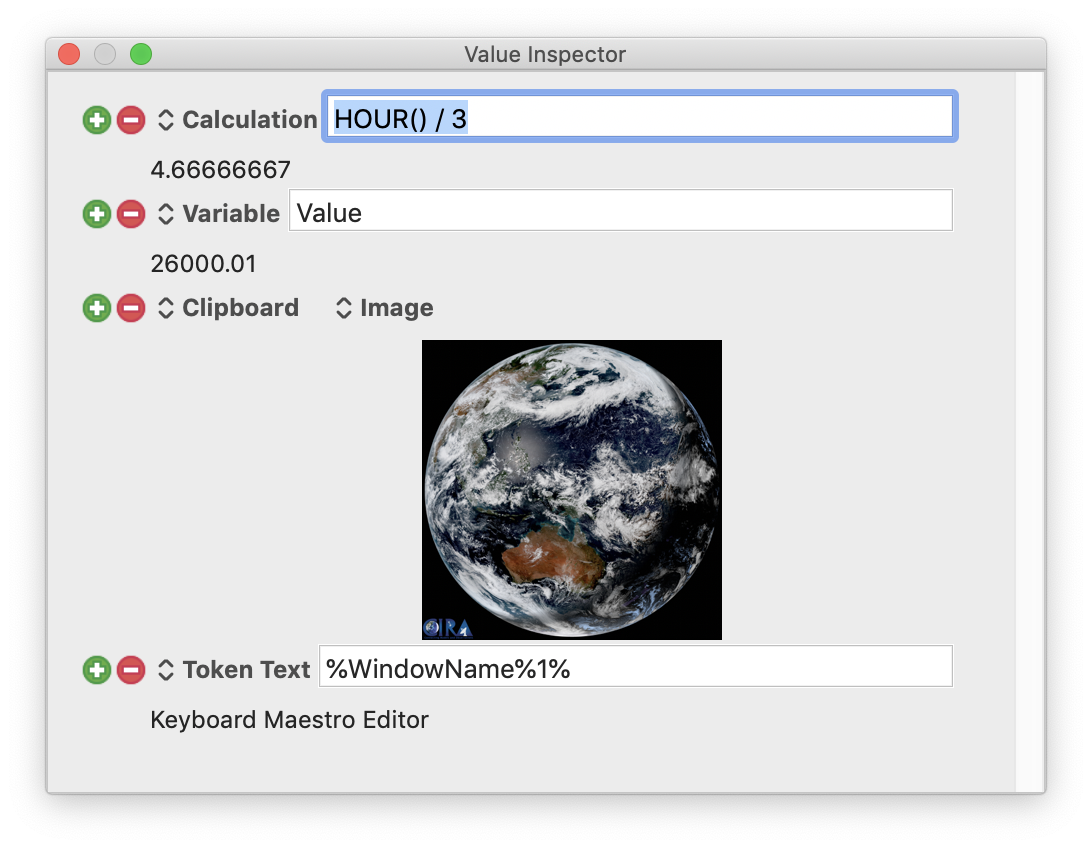
The contextual menu (control or right click in the window) will allow you to toggle whether the window is displayed only while the Keyboard Maestro editor is at the front, or whether the window floats above all applications.
Palette Theme Editor
This window allows you to configure the appearance of the various macro palette.
You can choose a style, the opacity of the palette, the size of the entries, the number of columns, whether the entries include the icon, the text and/or the trigger, and whether the palette shrinks when the mouse is not over it.
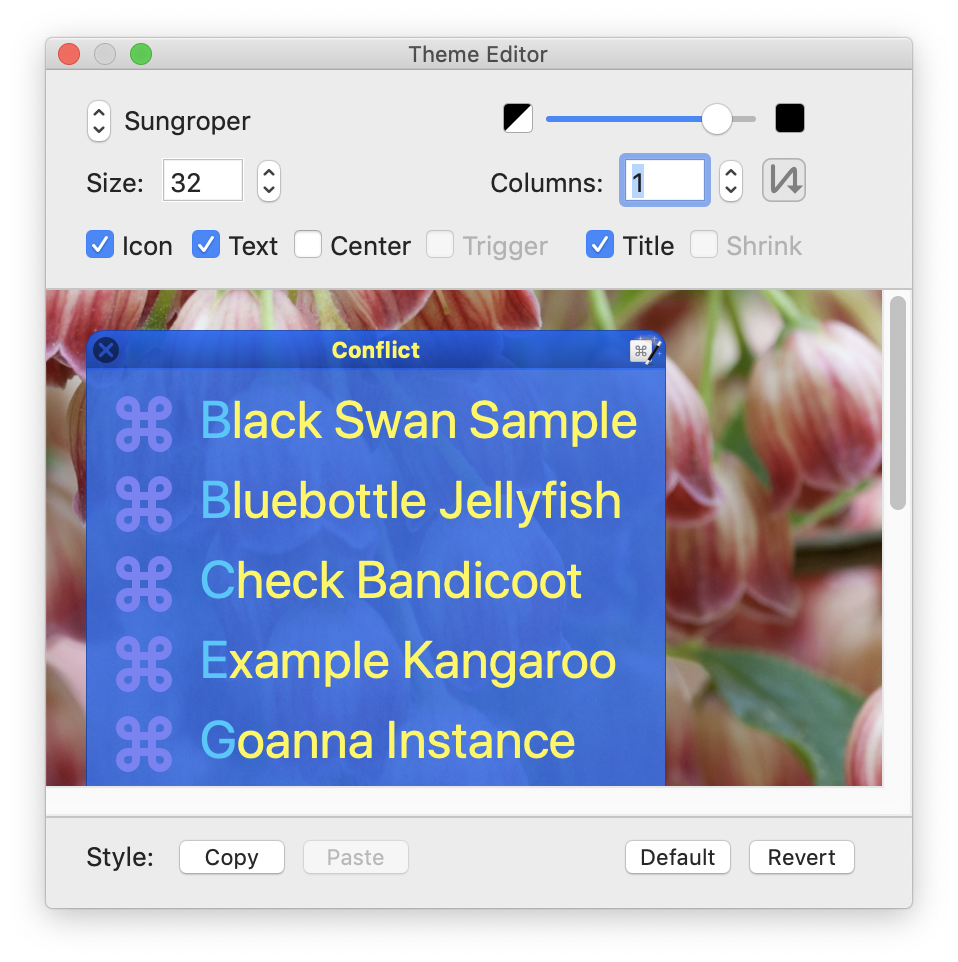
Recording Window
This window shows you when Keyboard Maestro is recording your actions.
You get this window by clicking the Record button in the Macro Editor window or by triggering a Record Quick Macro action.
Clicking on this window will stop all recording, or you can pause recording, or add a 0.25 second Pause action to the current recording. Option-clicking the Clock button will turn on “real time” recording and Keyboard Maestro will record a pause between each action to simulate playback at approximately the same speed as the recording.
To learn more about recording, see the Recording section.
Macro Debugger
You get this window by choosing the Status Menu ➤ Start Debugging menu by triggering a Debugger Start action.

To learn more about debugging, see the Macro Debugger section.
Conflict Palette
You get a conflict palette when a Hot Key would trigger two or more actions.
Note how the distinguisihing characters are highlighted – pressing those keys will select the desired trigger, or filter the list so that only those macros remain:
this continues until only one macro remains which is immediately executed.
Trigger Macro by Name
You get this window by executing the Trigger Macro by Name action.
Type a string to filter the macros.
Note that the filtering is not just by macro name.
Application Launcher Window
This window lets you launch applications.
You get this window by triggering the Activate Application Launcher macro.
To learn more about the Application Launcher, see the Application Launcher section.
Application Switcher Window
This window lets you switch between active applications, as well as quit or hide applications or quickly launch frequently used applications.
You get this window by triggering the Activate Application Switcher macro.
To learn more about the Application Switcher, see the Application Switcher section.
Window Switcher Window
This window lets you switch between windows in the current application, as well as close or minimize windows.
You get this window by triggering the Activate Window Switcher macro.
To learn more about the Window Switcher, see the Window Switcher section.
Named Clipboard Switcher Window
This window lets you select between named clipboards to Cut, Copy or Paste to/from.
You get this window by triggering one of the Activate Clipboard Switcher macros.

Select something and select a named clipboard and click the Cut button or Copy button to cut/copy to a named clipboard. Select a named clipboard and click the Paste button button to paste a named clipboard. Click the + button to create a new named clipboard. Select a named clipboard and click the Quick Look button to view it. Select a named clipboard and click the - button to delete it.
Click the x button to toggle whether the window should close after an action.
Use the search field to filter the named clipboards.
To learn more about the Clipboard Switcher, see the Named Clipboard Switcher section.
Clipboard History Switcher Window
This window lets you paste from your clipboard history of items that you have previously cut or copied.
You get this window by triggering the Clipboard History Switcher macro.

Cut or copy something and it will appear in this list. Select an item and click the Paste button button to paste a named clipboard. Select an item and click the ★ button (or press Command-L) to mark it as a favorite, or click the ✉ button (or press Command-S) to send it to another Mac. Select an item and click the - button to delete it (this is useful if you want to delete a password or other sensitive information).
To view an item more fully, select it and click the Quick Look button (or press Space) to display the Quick Look window.
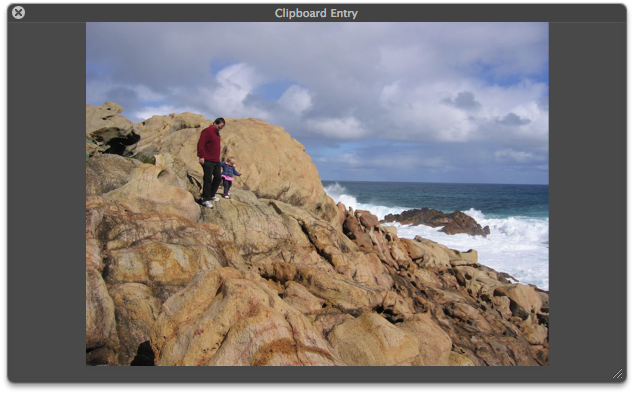
To send a clipboard to another Mac running Keyboard Maestro, click the ✉ button to display the sending window.
Select the desired local destination, or type a host:port destination to send it to a remote Mac, and click the send button. Keyboard Maestro will keep trying to send to the Mac even if it can't connect right now, so as long as both Macs are connected to the Internet eventually, the clipboard should get through. While a clipboard is being sent, it is marked with a progress icon. If a clipboard is marked to be sent in the future, it is marked with a ➹. Once it has been successfully sent, it is marked with a ➚. If it fails to be sent, and Keyboard Maestro has given up, it is marked with a !. Clipboards that have been received are marked with a ✉.
Click the x button to toggle whether the window should close after an action.
Use the search field to filter the named clipboards.
To learn more about the Clipboard History Switcher, see the Clipboard History Switcher section.
Preferences Window
This window lets you configure Keyboard Maestro.
You get this window by launching Keyboard Maestro and choosing the Keyboard Maestro ➤ Preferences menu.
To learn more about the Preferences, see the Preferences section.
Preferences General Pane
This window pane lets you configure general preferences.

Preferences Palettes Pane
This window pane lets you configure the default palettes style, as well as the global and conflict palette styles.
You can also configure whether the conflict palette appears under the mouse.
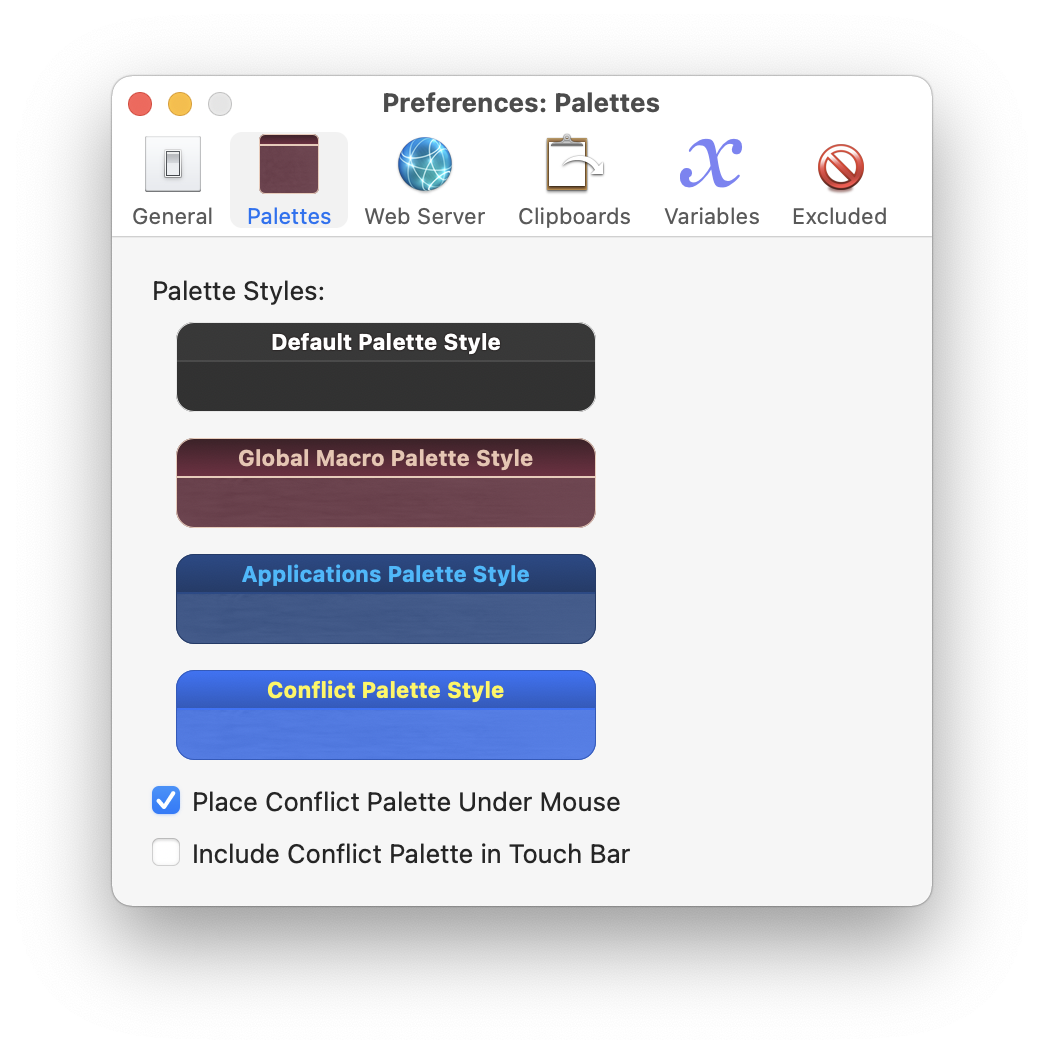
Preferences Web Server Pane
This window pane lets you configure the built-in web server which enables remote execution of macros.
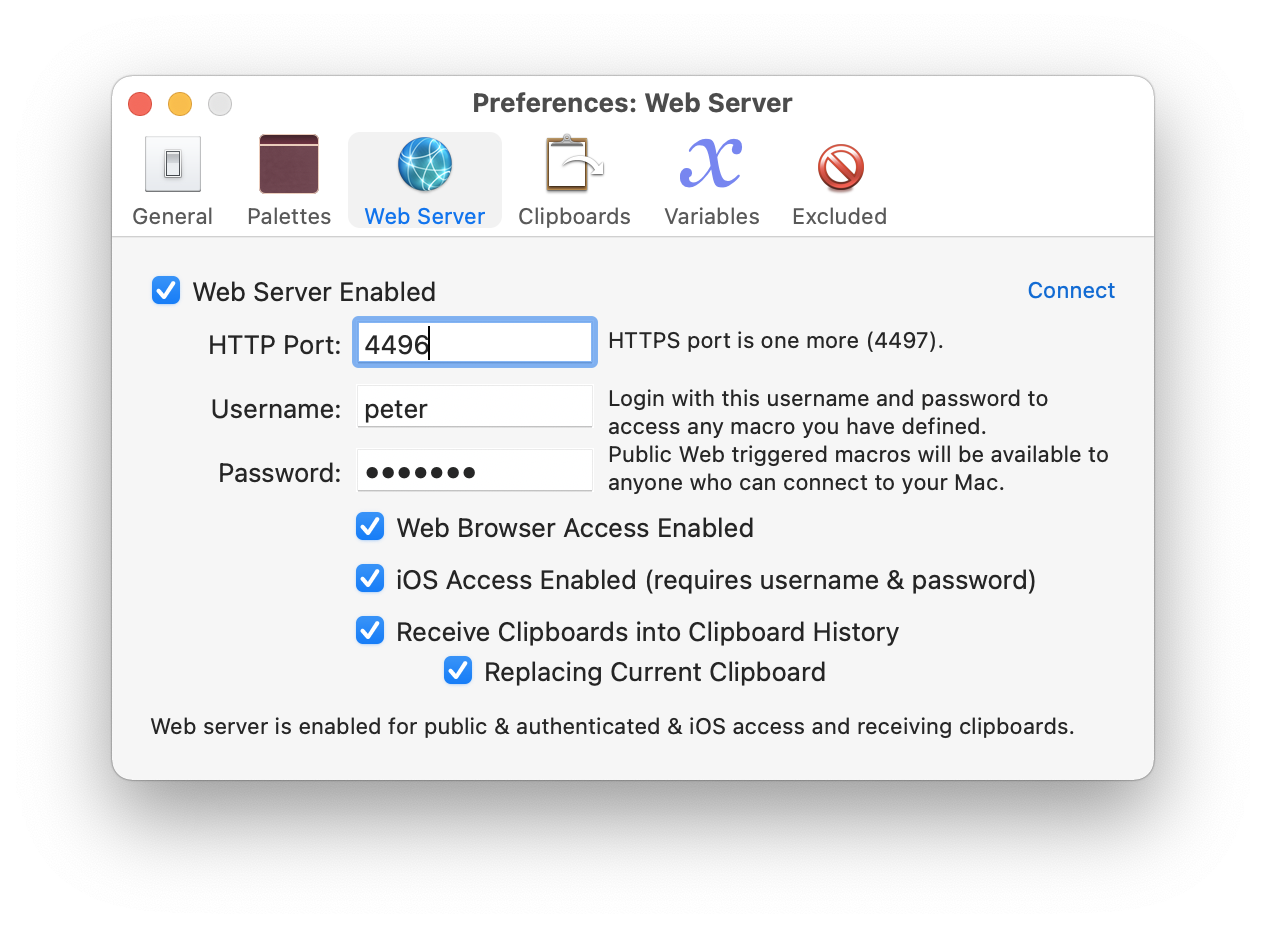
Preferences Clipboards Pane
This window pane lets you add, remove and rename Named Clipboards and see and change their values.

Preferences Variables Pane
This window pane lets you add and remove variables, and see and change their values.
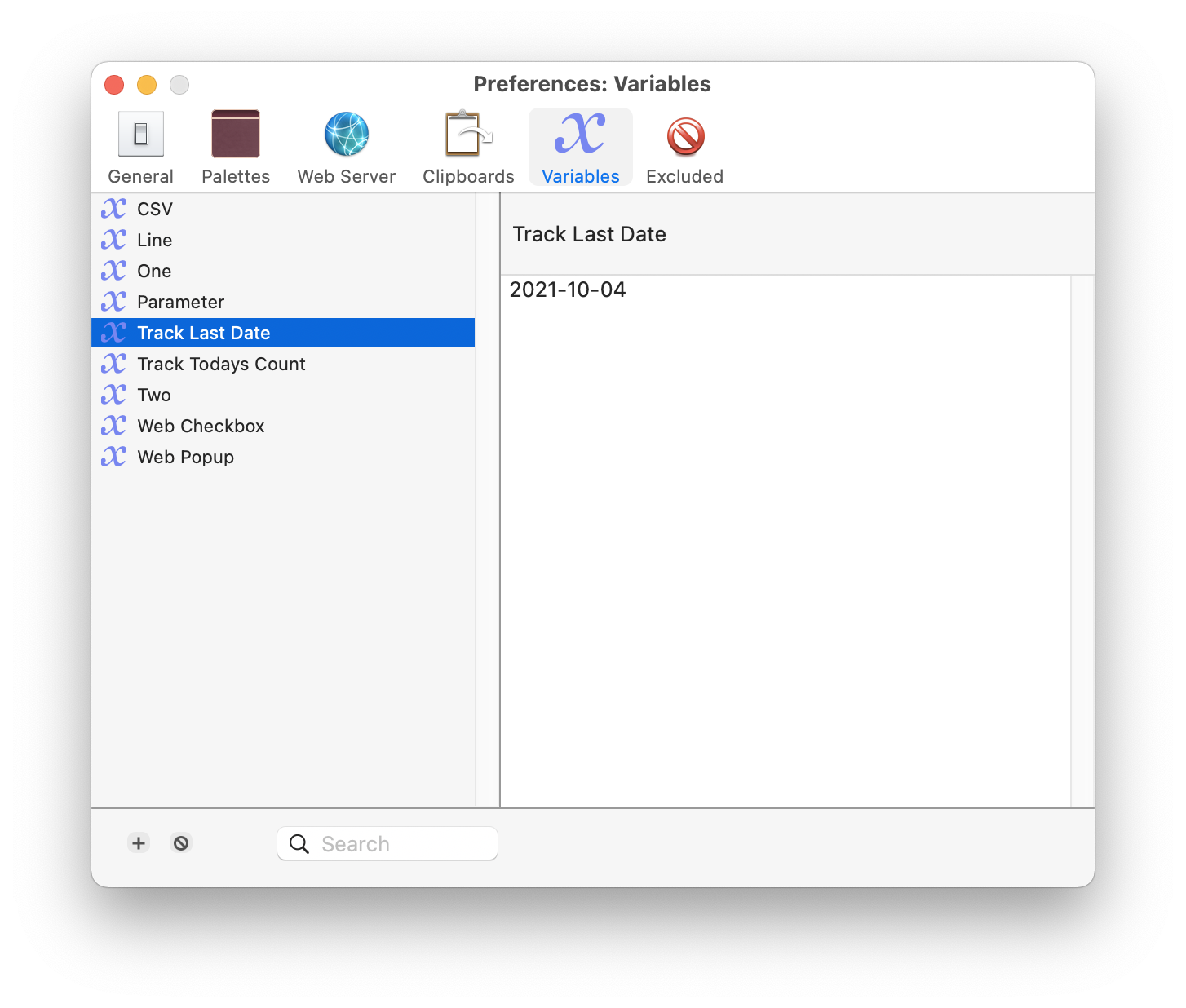
Variables listed in the Variables Panel include:
- Variables with values.
- All variables referenced directly in any action (although not as tokens).
- Minus all variables whose value has been set to “%Delete%” (this is provided for people who prefer not to see certain variable names in the pane or in variable insertion menus).
Preferences Excluded Pane
This window pane lets you add and remove applications from the global Excluded Applications list.
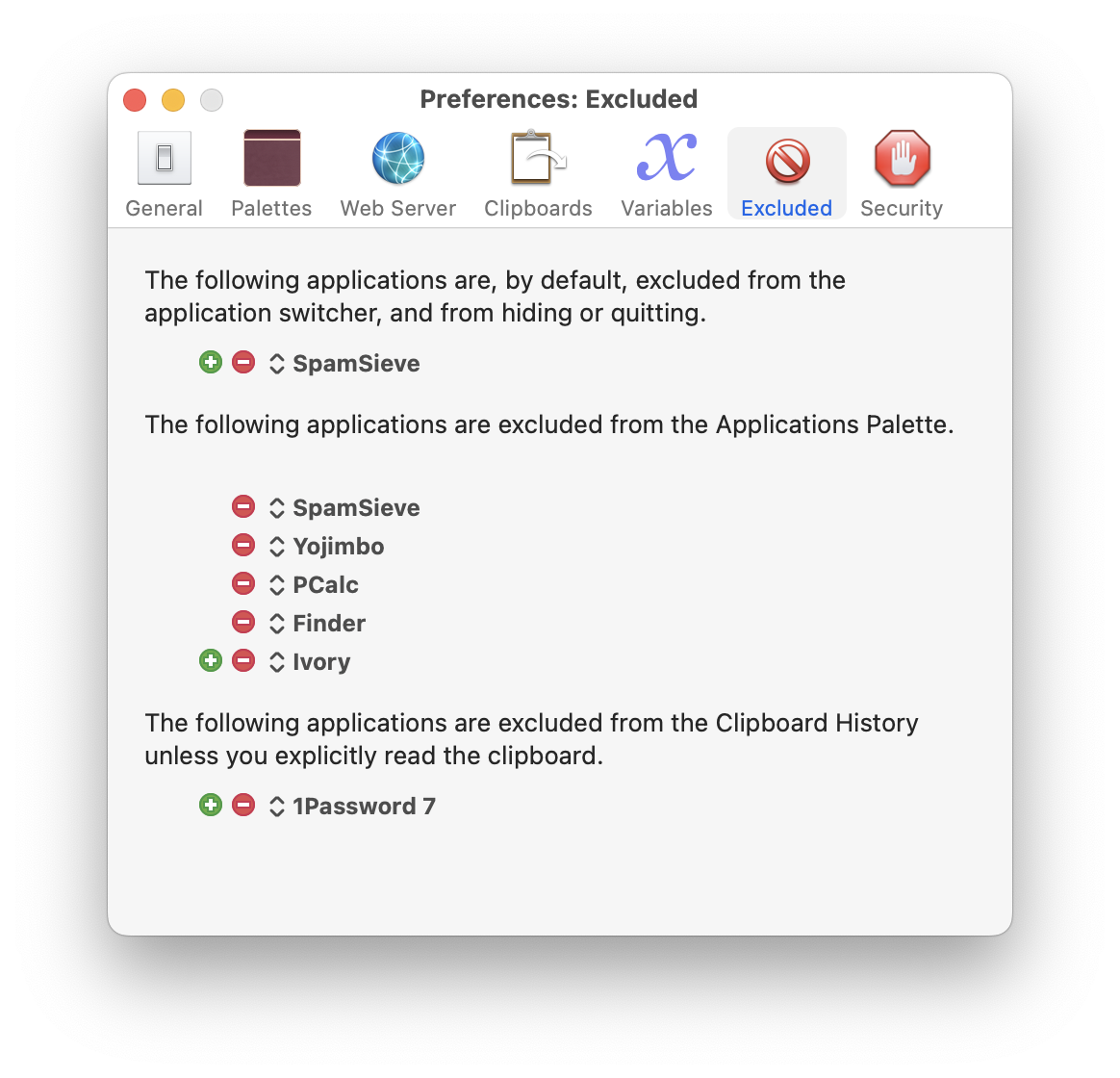
Preferences Security Pane
This window pane lets you see what system Security restrictions might limit your macros.
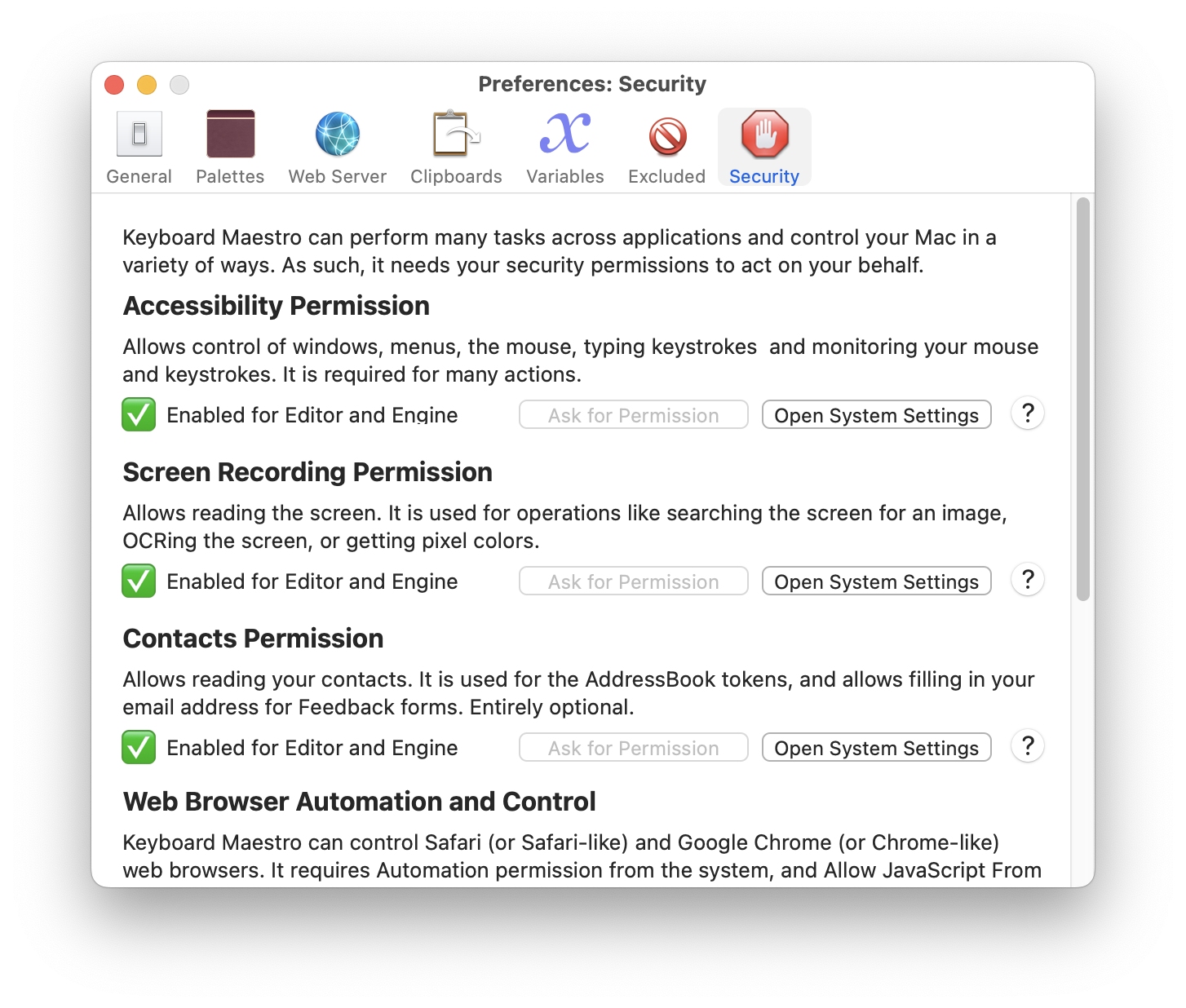
About Window Pane
This window shows you the version of this copy of Keyboard Maestro, to whom it is registered, and allows you to visit the web site.
You get this window by launching Keyboard Maestro and choosing the Keyboard Maestro ➤ About Keyboard Maestro menu.
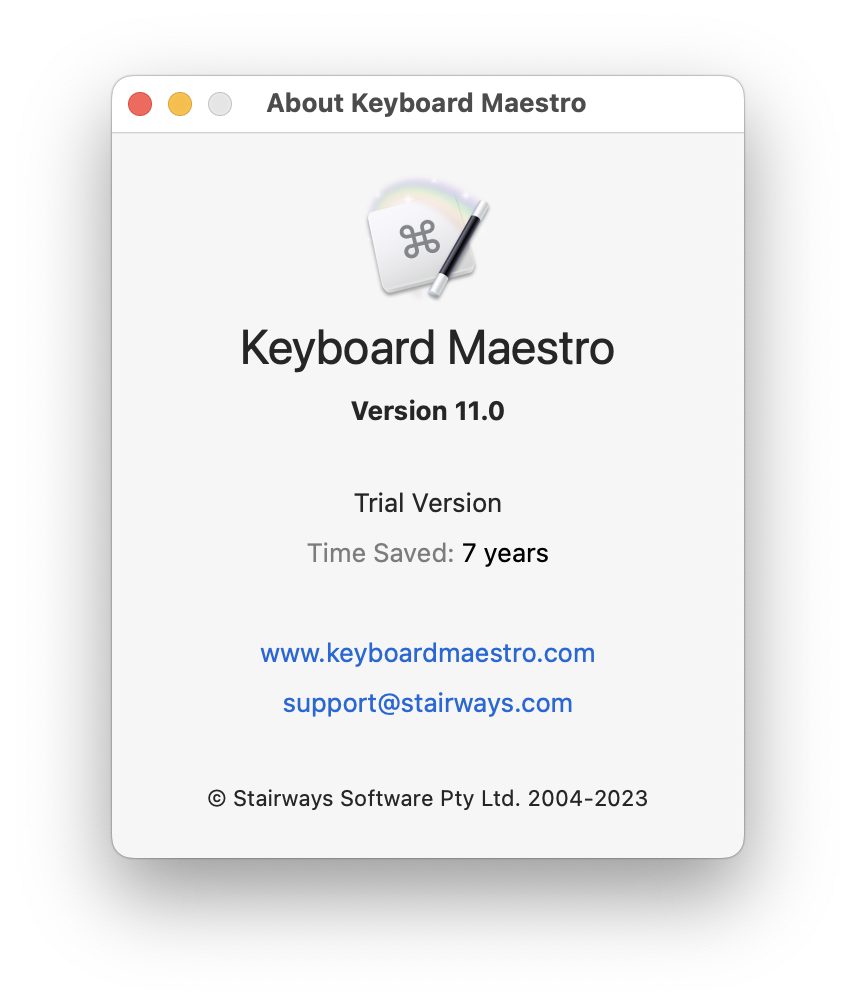
Menus
Below is a complete list of all menus. Note that in some cases you must hold down the Option Key ⌥ (or Alt or Opt) to see the menu item. For example, the “Expand All Actions” item in the Actions menu.
Keyboard Maestro
The Keyboard Maestro menu contains menu items relating to the Keyboard Maestro application as a whole.
About Keyboard Maestro
The About Keyboard Maestro command in the Keyboard Maestro menu displays the About Keyboard Maestro window.
Purchase Keyboard Maestro
The Purchase Keyboard Maestro command in the Keyboard Maestro menu lets you purchase Keyboard Maestro online.
Purchase Keyboard Maestro Upgrade
The Purchase Keyboard Maestro Upgrade command in the Keyboard Maestro menu lets you purchase an upgrade to Keyboard Maestro online.
Register Keyboard Maestro
The Register Keyboard Maestro command in the Keyboard Maestro menu displays the serial number entry window allowing you to enter your username (email address) and serial number. Make sure you enter them exactly as sent to you. If your email address shows up as “Registered to” in the About Keyboard Maestro box, then you are already registered. If your license does not work, ensure that you are entering the username and serial number exactly as shown, that there are no extra invisible characters included, and that your license matches the major version of Keyboard Maestro that you are using.
Deregister or Reregister Keyboard Maestro
The Deregister or Reregister Keyboard Maestro command in the Keyboard Maestro menu lets you remove the registration from Keyboard Maestro and then optionally re-register. You could do this if you are getting rid of the Mac (though you would generally simply erase the Mac in that case). Hold the Option key down to select this menu item.
Check For Update
The Check For Update command in the Keyboard Maestro menu checks to see if there are any updates to Keyboard Maestro and offers to download and install them if there are.
Preferences
The Preferences (or Settings) command in the Keyboard Maestro menu displays the Preferences window.
Services
The Services command in the Keyboard Maestro menu is used to perform Mac OS X Services which are shared functions available across multiple applications. You can learn more about Mac OS X Services from your Mac OS X documentation, and you can install new services which will work with Keyboard Maestro. Keyboard Maestro includes full support for Services, so relevant Services on your system are available in Keyboard Maestro. You can also export a macro as a Text Service to have it available here (and for other applications).
Hide Keyboard Maestro
The Hide Keyboard Maestro command in the Keyboard Maestro menu will hide the Keyboard Maestro application and all its windows. Click on Keyboard Maestro's Dock icon or choose Show All to show Keyboard Maestro again. Note that generally you should just quit the Keyboard Maestro editor when you are not modifying your macros.
Hide Others
The Hide Others command in the Keyboard Maestro menu will hide all other applications. Choose Show All to show them again.
Show All
The Show All command in the Keyboard Maestro menu will show all hidden applications.
Quit Keyboard Maestro Editor
The Quit Keyboard Maestro Editor command in the Keyboard Maestro menu will Quit Keyboard Maestro. The Keyboard Maestro Engine will remain running and all enabled Keyboard Maestro features will continue to operate (unless you have specifically quit the Keyboard Maestro Engine).
File
The File menu is where you import or export Macros or launch or quit the Keyboard Maestro Engine.
New Smart Group
The New Smart Group command in the File menu creates and starts editing a new smart group.
New Macro Group
The New Macro Group command in the File menu creates and starts editing a new macro group.
New Macro
The New Macro command in the File menu creates and starts editing a new macro.
New Macro Wizard
The New Macro Wizard command in the File menu lets you quickly outline the macro and then creates and starts editing the new macro.
New Editor Window
The New Editor Window command in the File menu creates a new editor window. Closing the last editor window will quit the Keyboard Maestro editor (the Keyboard Maestro Engine will continue operating as usual).
Close
The Close command in the File menu closes the front window.
Close All
The Close All command in the File menu closes all the windows and quits the Keyboard Maestro editor (the Keyboard Maestro Engine will continue operating as usual). Hold the Option key down to select this menu item.
Run Macro
The Run Macro command in the File menu runs the currently selected macro.
Share
The Share menu in the File menu lets you share the selected macro group, macro or actions with any appropriate sharing service on your Mac, including sharing to the forum. If you hold the Shift key down before starting your menu selection you can share just an image of the selection, which will allow you to share to services that only allow selection of images.
Export Actions
The Export Actions command in the Export sub-menu in the File menu exports the selected actions to a file that you can import later or on another Mac or send to others.
Export Macros
The Export Macros command in the Export sub-menu in the File menu exports the selected macros to a file you can import on another Mac. This is one way to transfer macros from one Mac to another or to share macros with friends or colleagues.
If a Macro Group is selected and no macros are selected then the entire Macro Group is exported as a single .kmmacros file.
Export as Macro Library
The Export as Macro Library command in the Export sub-menu in the File menu exports the selected macros to a library file that you can share with others. If you create any interesting macros please consider sending them to us and we will make them available on our web site or in a future version of Keyboard Maestro.
See also the Macro Library section.
Note that you should generally only export as library if you want to import the macros multiple times. Otherwise just exporting the macros is sufficient.
Export as Folder
The Export as Folder command in the Export sub-menu in the File menu exports the selected macros to a folder containing macro group folders and individual macro export files. You can use this to preserve your macros in a version history structure or for archiving purposes.
Export All Macros as Folder
The Export All Macros as Folder command in the Export sub-menu in the File menu exports all of your macros to a folder containing macro group folders and individual macro export files. You can use this to preserve all of your macros in a version history structure or for archiving purposes.
Export as Trigger File
The Export as Trigger File command in the Export sub-menu in the File menu lets you save a file that will trigger a macro when opened (that is, a file you can open in the Finder to trigger a macro).
Export as Text Service
The Export as Text Service command in the Export sub-menu in the File menu lets you save a Text Service that will trigger a macro when selected in the Services menu. The incoming text is available in the %TriggerValue% token.
Export as Finder Quick Action
The Export as Finder Quick Action command in the Export sub-menu in the File menu lets you save a Finder Quick Action that will trigger a macro when selected in the Quick Action contextual menu. The incoming file path is available in the %TriggerValue% token.
Import Actions
The Import Actions command in the Import sub-menu in the File menu lets you select a saved action file and imports the actions it contains into the current macro.
Import Macros Safely
The Import Macros Safely command in the Import sub-menu in the File menu lets you select a saved macro file and imports the macros it contains, disabling them (either disabling created macro groups, or disabling the contained macros as appropriate).
If you do not completely trust the source of the macros, you should import them this way.
Import Macros
The Import Macros command in the Import sub-menu in the File menu lets you select a saved macro file and imports the macros it contains. Hold the Option key down to select this menu item. Macros imported this way could trigger immediately, so use this command only if you completely trust the source of the macros.
Import to Macro Library
The Import to Macro Library command in the Import sub-menu in the File menu lets you import a shared macro library file into your macro library. Macros in your library are not active, but can be added into one or more macro groups to become active.
See also the Macro Library section.
Revert Macros
The Revert Macros menu in the File menu lets you revert to a previous version of your macros. If you find you have really messed up your macros, you can restore your macros to a backup version of how they were when you first launched Keyboard Maestro, or how they were yesterday or even several days ago.
Start Syncing Macros
The Start Syncing Macros command in the File menu lets you start syncing your macros with another Mac.
See also the Macro Syncing section.
Reveal Macro Sync File
The Reveal Macro Sync File command in the File menu lets you see where your macro sync file is.
See also the Macro Syncing section.
Stop Syncing Macros
The Stop Syncing Macros command in the File menu lets you stop syncing your macros.
See also the Macro Syncing section.
Launch Engine
The Launch Engine command in the File menu lets you start the Keyboard Maestro Engine manually. The Keyboard Maestro Engine performs all the Macro, Application Switcher, Window Switcher and Clipboard Switcher functions even while Keyboard Maestro itself is not running. It is launched automatically as a Startup Item when you login (assuming you have enabled that in the Preferences window) or any time you launch Keyboard Maestro. If it is not running for any reason you can start it manually with this command. This menu item only appears while the Keyboard Maestro Engine is not running.
Quit Engine
The Quit Engine command in the File menu lets you quit the Keyboard Maestro Engine. The Keyboard Maestro Engine performs all the Macro, Application Switcher, Window Switcher and Clipboard Switcher functions even while Keyboard Maestro itself is not running. It is launched automatically as a Startup Item when you login (assuming you have enabled that in the Preferences window). If you quit the Keyboard Maestro Engine these functions will no longer operate. This menu item only appears while the Keyboard Maestro Engine is running.
Edit
The Edit menu contains menu items relating to text and selections.
Undo
The Undo command in the Edit menu undoes the previous command.
Redo
The Redo command in the Edit menu redoes the previous undone command.
Cut
The Cut command in the Edit menu copies the current selection to the system clipboard and then deletes the selection.
Copy
The Copy command in the Edit menu copies the current selection to the system clipboard.
Copy as
The Copy as sub-menu in the Edit menu menu allows you to copy the selection in a variety of formats.
Copy as Text
The Copy as Text command in the Copy as sub-menu in the Edit menu menu allows you to copy the selected macro or actions as styled text.
Copy as Image
The Copy as Image command in the Copy as sub-menu in the Edit menu menu allows you to copy the selected macro or actions as an image.
Copy as XML
The Copy as XML command in the Copy as sub-menu in the Edit menu menu allows you to copy the selected macro or actions as XML.
Copy UUID
The Copy UUID command in the Copy as sub-menu in the Edit menu menu allows you to copy the selected macro or macro group’s UUID (Universally Unique ID).
Copy as Execute a Macro Action
The Copy as Execute a Macro Action command in the Copy as sub-menu in the Edit menu menu allows you to copy the selected macro as an Execute a Macro action.
Copy as Execute a Subroutine Action
The Copy as Execute a Subroutine Action command in the Copy as sub-menu in the Edit menu menu allows you to copy the selected macro as an Execute a Subroutine action.
Copy as Mark Macro Action
The Copy as Mark Macro Action command in the Copy as sub-menu in the Edit menu menu allows you to copy the selected macro as a Mark Macro action.
Copy as Set Macro Enabled Action
The Copy as Set Macro Enabled Action command in the Copy as sub-menu in the Edit menu menu allows you to copy the selected macro as a Set Macro Enable action.
Copy as Set Macro Group Enabled Action
The Copy as Set Macro Group Enabled Action command in the Copy as sub-menu in the Edit menu menu allows you to copy the selected macro as a Set Macro Group Enable action.
Copy as Toggle Macro Group Action
The Copy as Toggle Macro Group Action command in the Copy as sub-menu in the Edit menu menu allows you to copy the selected macro as a Toggle Macro Group Activation action.
Paste
The Paste command in the Edit menu pastes the current system clipboard into the current selection.
Delete
The Delete command in the Edit menu deletes the current selection.
Select All
The Select All command in the Edit menu selects all text or items.
Deselect All
The Deselect All command in the Edit menu deselects all text or items. Hold the Option key down to select this menu item.
Duplicate
The Duplicate command in the Edit menu duplicates the selected items.
Make Alias
The Make Alias command in the Edit menu makes an alias to the selected macros. It creates a new macro that just executes the original macro.
You may also use ⌘L or Drag/Drop with ⌘⌥ to another Macro Group.
Insert Action
The Insert Action command in the Edit menu lets you insert any of the many actions available in Keyboard Maestro.
Hold the Option key down to get help on the action.
Hold the Shift key down to insert the action above the selected action.
Insert Action by Name
The By Name command in the Edit ➤ Insert Action menu lets you insert any of the many actions available in Keyboard Maestro by name.
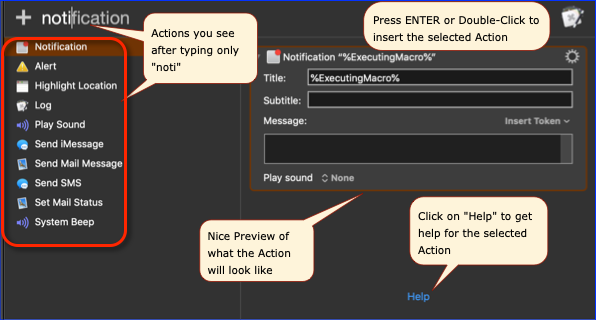
While double clicking or pressing Return, hold the Option key down to get help on the action or hold the Shift key down to insert the action above the selected action.
Insert Function
The Insert Function sub-menu in the Edit menu lets you insert any of the many functions available in Keyboard Maestro. The functions will be inserted, together with an example of any parameters it takes.
Most numeric fields in Keyboard Maestro can process an expression containing these functions. These fields are indicated either by having up/down steppers, or a C in the field while editing.
Hold the Option key down to get help on the function.
Insert Function by Name
The By Name command in the Edit ➤ Insert Function menu lets you insert any of the many functions available in Keyboard Maestro by name.
Hold the Option key down to get help on the function.
Insert Token
The Insert Token sub-menu in the Edit menu lets you insert any of the many Tokens available in Keyboard Maestro. The token will be inserted, together with an example format of any parameters it takes.
Most text fields in Keyboard Maestro can process Tokens. These fields are indicated by having a T in the field while editing.
Hold the Option key down to get help on the token.
Hold the Shift key down to show the raw token.
Insert Token by Name
The By Name command in the Edit ➤ Insert Token menu lets you insert any of the many tokens available in Keyboard Maestro by name.
Hold the Option key down to get help on the token.
Insert Variable
The Insert Variable command in the Edit menu lets you insert any of your variables.
Insert Variable by Name
The By Name command in the Edit ➤ Insert Variable menu lets you insert any of your variables by name.
Insert ICU Date Field
The Insert ICU Date Field sub-menu in the Edit menu lets you insert any of the many fields available in %ICUDateTime% token.
Hold the Shift key down to show the raw field.
Insert ICU Date Field by Name
The By Name command in the Edit ➤ Insert ICU Date Field menu lets you insert any of the many fields available in %ICUDateTime% token in Keyboard Maestro by name.
Automatic Completions
The Automatic Completions command in the Edit menu lets you toggle automatic text completion. When off, you can still complete variables, tokes, and functions by pressing F5.
Find
The Find menu in the Edit menu lets find things in Keyboard Maestro.
The Find… menu item will select the search field in the Keyboard Maestro editor window.
The Find in All Macros… menu item will select the search field in the Keyboard Maestro editor window and select the All Macros Smart Group to search all the macros.
View
The View menu contains menu items relating to display and actions.
Sort Macros by Name
The Name command in the View ➤ Sort Macros by menu sorts the macros in the main window by name.
Sort Macros by Trigger
The Trigger command in the View ➤ Sort Macros by menu sorts the macros in the main window by trigger. This is useful to see what hot keys are available, or to group all Typed String triggers together.
Sort Macros by Date Created
The Date Created command in the View ➤ Sort Macros by menu sorts the macros in the main window by the date created.
Sort Macros by Date Modified
The Date Modified command in the View ➤ Sort Macros by menu sorts the macros in the main window by the date modified (most recently modified at the top). This is useful to see what macros you have recently modified. You can also use the ◷ button at the top of the macro editor to show the recently modified macros.
Sort Macros by Date Used
The Date Used command in the View ➤ Sort Macros by menu sorts the macros in the main window by date used (most recently executed at the top). This is useful to see what macros you have recently executed, especially if you think one might have been executed inadvertently. You can also use the ⌘ button at the top of the macro editor to show the recently used macros.
Sort Macros by Size
The Size command in the View ➤ Sort Macros by menu sorts the macros in the main window by approximate storage size, with the largest at the top. Typically it is not the number of actions in a macro that makrs a macro large, instead it is usually included images. If your macro file gets very large, this can slow the performance of the Keyboard Maestro editor (though generally it will not affect the performance of the Keyboard Maestro Engine). Sorting the macros by size can find the larger macros.
Sort Macros by Use Count
The Use Count command in the View ➤ Sort Macros by menu sorts the macros in the main window by use count (most used macros at the top).
Sort Macros by Time Saved
The Time Saved command in the * View ➤ Sort Macros by* menu sorts the macros in the main window by time saved (most time saved at the top).
Disabled to Bottom
The Disabled to Bottom command in the View ➤ Sort Macros by menu sorts the disabled macros to the bottom of the macro list.
Select Groups Column
The Select Groups Column command in the View menu focuses on the Macro Groups column.
Select Macros Column
The Select Macros Column command in the View menu focuses on the Macros column.
Go to Macro
The Go to Macro menu in the View menu lets you select a recently edited or used macro.
Go to Macro by Name
The By Name menu in the View ➤ Go to Macro menu lets you select a macro by name.
Go to Last Used
The Last Used menu in the View ➤ Go to Macro menu lets you select the most recently triggered macro.
Go to Last Edited
The Last Edited menu in the View ➤ Go to Macro menu lets you select the most recently edited macro.
Go to Previous Edited
The Previous Edited menu in the View ➤ Go to Macro menu lets you select the previous edited macro (edited macros form a list, and this moves backward along the list).
Go to Next Edited
The Next Edited menu in the View ➤ Select Macro menu lets you select the next edited macro (edited macros form a list, and this moves forward along the list).
Go to Aborted Action
The Go to Last Aborted Action menu in the View menu selects the macro and the last action that failed and aborted a macro.
Reveal Parent Group
The Reveal Parent Group command in the View menu selects the parent macro group of the currently selected macros. If you are editing a macro and the parent macro group is not the only selected macro group, then the parent macro groups’s name is shown in the top right corner of the window. Clicking on this name will also reveal the parent macro group.
Show Disabled Macro Groups
The Show Disabled Macro Groups command in the View menu shows all macro groups (enabled or disabled) in the Macro Groups column. You can hide all the disabled Macro Groups with the Hide Disabled Macro Groups command.
Hide Disabled Macro Groups
The Hide Disabled Macro Groups command in the View menu hides all disabled macro groups in the Macro Groups column. Instead, a single placeholder group is shown that “contains” all the disabled Macro Groups. You can double click the Disabled Macro Groups placeholder to temporarily reveal the disabled macro groups. You can show all the disabled Macro Groups with the Show Disabled Macro Groups command.
Evaluate Condition Results
The Evaluate Condition Results command in the View menu toggles whether the editor evaluates conditions in macros it is displaying. If it does, macros with conditions will display their current value in real time in the editor (eg “(currently true)”). If not, they will display “(click for result)” and you can click on that to enable the Evaluate Condition Results facility.
Note that evaluating results may have a performance issue if the results are complex to evaluate (eg searching the screen).
This facility is turned off when you import a macro safely to ensure that scripts in conditions do not get to execute before you have a chance to verify their safety.
Enable
The Enable command in the View menu enables Macro Groups, Macros or Actions as appropriate.
Disable
The Disable command in the View menu disables Macro Groups, Macros or Actions as appropriate.
Start Editing Macros
The Start Editing Macros command in the View menu turns on edit mode. Edit mode allows you to modify macros and macro groups. You may prefer to leave it on permanently, or you may like to turn it off when you are not making changes to give a more concise and visually appealing view of the macros and macro groups.
Stop Editing Macros
The Stop Editing Macros command in the View menu turns off edit mode.
Rename
The Rename command in the View menu edits the name of the currently selected Macro Group or Macro.
Record
The Record command in the View menu toggles recording on and off. It is available while editing a macro. Hold the option key down to record without a delay.
Record Without Delay
The Record Without Delay command in the View menu toggles recording on and off immediately (without the normal short countdown). It is available while editing a macro. Hold the shift key down to select the menu.
Enter Full Screen
The Enter Full Screen command in the View menu will expand the window to full screen.
Actions
The Actions menu contains menu items relating to actions. These items have analogs in the action gear ⚙ menu and contextual menu for actions, and some menu items appear only in the appropriate menu.
Show Actions
The Show Actions command in the Actions menu shows the action list. It is available while editing a macro. Double click or drag actions from the action list to add them to your macro. This menu toggles to Hide Actions when the action list is already showing. Alternatively you can choose Insert Action by Name from the Edit menu to insert actions by name or use the Insert Action menu in the Edit to select actions.
Try
The Try command in the Actions menu tries the selected actions. It is available while editing a macro.
Enable
The Enable command in the Actions menu enables actions.
Disable
The Disable command in the Actions menu disables actions.
Rename
The Rename command in the Actions menu renames actions.
Set Color
The Set Color menu in the Actions menu sets the color of actions.
Note: A blue striped color is reserved to mark the action as a match for the current search.
Set Note
The Set Note command in the Actions menu sets the notes of actions.
Paste Above
The Paste Above command in the Actions menu pastes previously copied actions above the selected actions.
Paste Below
The Paste Below command in the Actions menu pastes previously copied actions below the selected actions.
Paste Replacing
The Paste Replacing command in the Actions menu pastes previously copied actions, replacing the selected actions.
Move Action Up
The Move Action Up command in the Actions moves the selected actions before the action proceeding the first selected action.
Move Action Down
The Move Action Down command in the Actions moves the selected action(s) after the action following the last selected action.
Add to Favorites
The Add to Favorites command in the the Actions menu adds the currently selected action(s) as a Favorite action which you can insert later. The favorite action saves all the current action configuration.
Engroup
The Engroup menu in the Actions lets you enclose the selected actions within a container action such as a Group, Repeat, If Then Else or other control flow action. You can also turn the selected macros into a sub-macro.
Degroup
The Degroup command in the Actions removes the selected actions from their parent container action, and removes the container action if it is now empty.
Set Action Timeout
The Set Action Timeout command in the Actions menu sets the timeout for the selected action.
Timeout Aborts Macro
The Timeout Aborts Macro command in the Actions menu controls whether the macro is aborted if the action is timed out.
Notify on Timeout
The Notify on Timeout command in the Actions menu controls whether you are notified if the action is timed out.
Failure Aborts Macro
The Failure Aborts Macro command in the Actions menu controls whether the macro is aborted if the action fails.
Notify on Failure
The Notify on Failure command in the Actions menu controls whether you are notified if the action fails.
Expand Action
The Expand Action command in the View menu expands (discloses) the selected actions. Hold the option key down to expand all actions in a given sublist.
Expand All Actions
The Expand All Actions command in the View menu expands (discloses) the selected actions and all other actions in the same sublist. Hold the option key down to select this command.
Collapse Action
The Collapse Action command in the View menu collapses the selected actions. Hold the option key down to collapse all actions in a given sublist.
Collapse All Actions
The Collapse All Actions command in the View menu collapses the selected actions and all other actions in the same sublist. Hold the option key down to select this command.
Parent Action
The Parent Action command in the View menu moves the selection to the containing action.
Enter Action
The Enter Action command in the View menu moves the selection to the contained action.
Help
The Help command in the View menu displays the wiki help for the selected action.
Window
The Window menu contains menu items relating to windows.
Minimize
The Minimize command in the Window menu minimizes the front window.
Zoom
The Zoom command in the Window menu zooms the front window.
Keyboard Maestro Editor
The Keyboard Maestro Editor command in the Window menu brings the frontmost Keyboard Maestro macro editing window to the front.
Macro Library
The Macro Library command in the Window menu shows or hides the macro library.
See also the Macro Library section.
Icon Chooser
The Icon Chooser command in the Window menu shows or hides the Icon Chooser.
See also the Icon Chooser section.
Macro Inspector
The Macro Inspector command in the Window menu shows or hides the Macro Inspector.
See also the Macro Inspector Window section.
Mouse Display
The Mouse Display command in the Window menu shows or hides the Mouse Display, which shows the mouse location in real time.
See also the Mouse Display Window section.
Value Inspector
The Value Inspector command in the Window menu shows or hides the Value Inspector, which shows values of variables, tokens, calculations, or clipboards that you can select.
See also the Value Inspector Window section.
Bring All to Front
The Bring All to Front command in the Window menu brings all Keyboard Maestro windows to the front.
Help
The Help menu contains menu items relating to Help.
You can use the search field in this menu to find menus or help on any topic in the wiki.
Interactive Help
The Interactive Help command in the Help menu starts the in-application assistance system. If you're having trouble with something not working the way you expect, this system may help you find out where the problem is, or offer suggestions for other sources of assistance.
Keyboard Maestro User Manual
The Keyboard Maestro User Manual command in the Help menu displays the Keyboard Maestro user manual on the Keyboard Maestro Wiki.
Keyboard Maestro Quick Start
The Keyboard Maestro Quick Start command in the Help menu displays the Keyboard Maestro quick start help web page, which quickly gets you up to speed in using Keyboard Maestro.
Welcome to Keyboard Maestro
The Welcome to Keyboard Maestro command in the Help menu displays the Welcome message, giving you a quick overview of what support resources are available for helping you get started using Keyboard Maestro.
Keyboard Maestro Web Site
The Keyboard Maestro Web Site command in the Help menu takes you to the Keyboard Maestro web site.
Keyboard Maestro Wiki
The Keyboard Maestro Wiki command in the Help menu takes you to the Keyboard Maestro wiki.
Keyboard Maestro Forum
The Keyboard Maestro Forum command in the Help menu takes you to the Keyboard Maestro forum.
Stairways Software Web Site
The Stairways Software Web Site command in the Help menu takes you to the Stairways Software web site.
Tutorial
The Tutorial command in the Help menu starts the in-application tutorial. The tutorial will walk you through creating a simple macro. By varying the actions slightly, you can create a variety of macros that are triggered by hot keys and that open various documents.
Practice Gestures
The Practice Gestures command in the Help menu starts the gesture system and lets you practice gestures, to ensure you can reliably trigger Gesture triggered macros.
Show Active Macro Groups
The Show Active Macro Groups command in the Help menu shows a palette that lists the current active macro groups. You can use this palette to see which macro groups are active (which means the enabled macros they contain are active).
ICU Date Format References
The ICU Date Format References command in the Help menu takes you to the ICU Date Format References web site.
ICU Regular Expression References
The ICU Regular Expression References command in the Help menu takes you to the ICU Regular Expression References web site.
Regular Expression Unicode Properties
The Regular Expression Unicode Properties command in the Help menu takes you to the Regular Expression Unicode Properties web site.
MacSparky Field Guide
The MacSparky Field Guide command in the Help menu takes you to the MacSparky Field Guide, a high quality, tech-savvy, video tutorial on using Keyboard Maestro from David Sparks.
Elgato Stream Deck Details
The Elgato Stream Deck Details command in the Help menu takes you to the Stream Deck page, which includes details about installing the plugin and working with a Stream Deck from Keyboard Maestro.
Third Party Licenses
The Third Party Licenses command in the Help menu displays the licenses folder containing the third party licenses for code used in Keyboard Maestro.
Open Logs Folder
The Open Logs Folder command in the Help menu displays the Keyboard Maestro Logs folder.
Open Preferences Folder
The Open Preferences Folder command in the Help menu displays the Keyboard Maestro Preferences folder.
Report Bugs or Feature Requests
The Report Bugs or Feature Requests command in the Help menu allows you to report any bugs you find or and features you would like implemented (hat tip to the wonderful image editor, Acorn).
Service and Support
The Service and Support command in the Help menu displays the service and support details, including how to contact us and where you can get more assistance.
Status Menu
The Status Menu menu appears on the right side of the menu bar showing (by default) the Keyboard Maestro icon (although you can control the icon in the General preference pane). It is generally visible any time the Keyboard Maestro Engine is running (unless you turn it off in the General preference pane). You use it to control the Keyboard Maestro Engine, to execute your Status Menu triggered macros, and to switch to applications.
Launch Keyboard Maestro Editor
The Launch Keyboard Maestro Editor command in the Status Menu menu launches Keyboard Maestro so you can edit your macros. You can also edit your macros directly by holding down the option key while choosing them in the Status Menu menu or in a palette.
Paste
The Paste menu in the Status Menu menu includes the recent text items in the clipboard history so you can easily paste in past items using this menu.
Hold the Shift key down to paste as plain text, and the Option key down to just set the clipboard without pasting.
Activate Clipboard History Switcher
The Activate Clipboard History Switcher command in the Status Menu ➤ Paste menu lets you activate the Clipboard History Switcher.
Your Macros
Your macros that include the Status Menu Trigger and that are currently active will be listed in this menu. You can select them to trigger them.
This is great for less frequently used macros that you will not remember a hot key or other trigger, as well as for macros that feel like they should be menu commands, such as actions that perform a complicated task.
Show Applications Palette
Toggles the display of the Applications Palette.
Recent
The Recent menu in the Status Menu menu contains a list of all recently quit applications.
Running
The Running menu in the Status Menu menu contains a list of all running applications.
Applications
The Applications menu in the Status Menu menu contains a list of all applications.
Utilities
The Utilities menu in the Status Menu menu contains a list of all utility applications.
Cancel
The Cancel command in the Status Menu menu contains a list of all currently running macros and allows you to cancel them.
You can also cancel all currently running macros by holding all the modifiers (Command, Control, Option, Shift) down and clicking on the Status Menu menu.
Start Debugging
The Start Debugging command in the Status Menu menu opens the macrodebugger window and starts debugging.
See also the Macro Debugger section.
Show Active Macro Groups
The Show Active Macro Groups command in the Help menu shows a palette that lists the current active macro groups. You can use this palette to see which macro groups are active (which means the enabled macros they contain are active).
Quit Keyboard Maestro Engine
The Quit Keyboard Maestro Engine command in the Status Menu menu quits the Keyboard Maestro Engine.
Tips
Remembering Macro Hot Keys
Hot Key triggers are only useful if you can remember which key does what.
Consider using mnemonic keys. For example, in your email client, you might define a set of Macros to Insert Text action, so use Control-A for your Address, Control-S for your Signature, Control-N for your Name, and so on.
Be consistent in your choice of Hot Keys. For example, use function keys to launch applications, Control-Function Keys to open documents, Control-Letter to insert text, and so on.
Consider using a single hot key for a set of related functionality. Keyboard Maestro will display a conflict palette and let you select from the choices.
Keyboard Maestro also interoperates with KeyCue – if you use both applications and hold the control key down KeyCue will display all your active Hot Keys.
Use the Conflict Palette
If you have two or more macros with the same Hot Key, pressing that key will display the conflict palette, listing all the conflicting macros. You can then press further keys to filter the list until one remains which is then immediately executed.
Use the Trigger Macro by Name Action
Another way to reduce having to remember Hot Keys is to use the Trigger Macro by Name action to trigger macros based on their name.
Use the Insert Menus
In the editor, there are menus in the Edit menu to inserting actions, functions and text tokens and variables. These can be very useful for both learning about what is available and quickly inserting elements. You can also use text completions to insert functions in numeric fields and tokens and text token fields.
If you hold down the Option key while selecting from these menus you can get help on any of the actions, functions or tokens.
There are also By Name versions to quickly insert actions, functions, tokens or variables by name.
Use the Insert Action by Name
Once you are confident using Keyboard Maestro, consider using the Insert Action by Name instead of the Action Selector. When you know the generally available actions, this is usually more efficient.
Pay Attention to the Gear Icon
The gear ⚙ menu in the top right of the menu shows you a variety of different things depending on exactly how it looks.
If the action has a timeout, then a clock face will appear in the middle of the gear. If the timeout has been left as the default, the time will be three o'clock, otherwise the time will be an impossible 4.5 o'clock.
If the action has extra configuration options, or a custom note, the gear menu will have a blue center.
The gear menu itself also shows you whether the item has notes, and whether it will abort or notify you if the action fails.
And finally, the gear menu includes a Help command which will take you to the wiki help on the action.
Use Function Keys for Global Hot Keys
It is quite hard to come up with global Hot Keys that will not conflict with those keys used by any application (a conflict is not really a problem, the Macro Hot Key will simply override the application, but this is not always desirable). It is best to use function keys, especially in conjunction with modifiers, as global Hot Keys since they tend not to be used by most applications.
Use the Number Pad
Remember that the number pad is available (and distinct from the numbers on the main keyboard) to use as hot keys.
Troubleshooting
See the wiki Troubleshooting page for how to resolve any problems we have anticipated.
Around 80% of all support emails we receive are related to Apple’s security permissions, including:
Keyboard Maestro includes a Security preference pane in its Preferences window which summarises some of the important security settings and whether they are enabled. Ensuring that everything is enabled will resolve a lot of troubleshooting issues.
Unfortunately Apple’s permission system has been filled with bugs since Mojave, including things like:
- Checkboxes not showing up in the permission system.
- Checkboxes not being able to be ticked.
- Checkboxes showing as ticked, but not actually granting the permissions.
- The system telling Keyboard Maestro it has permission, when it really does not.
Remember to unlock the System Preferences which is required for changing some (but not all) permissions.
Thankfully, you can pretty much always resolve these by sufficient bashing on the permission system:
- Restart.
- Use
tccutilto reset the permission system. - Quit and relaunch Keyboard Maestro or the Keyboard Maestro Engine.
- Ensure you move the Keyboard Maestro.app to the Applications folder using the Finder.
Occasionally you can resolve the issues by re-installing the Keyboard Maestro.app:
- Quit Keyboard Maestro Engine
- Quit Keyboard Maestro (editor)
- Delete the Keyboard Maestro.app
- Download a fresh copy of Keyboard Maestro.
- Using the Finder, move the Keyboard Maestro.app to the Applications folder.
- Launch Keyboard Maestro.app
This will not affect any existing macros.
In-built Assistance
The next most common issue is a macro doing nothing, or something weird is happening when you don't expect it to. In both these cases, choose Help ➤ Interactive Help menu) to bring up an interactive assistance system which might help you narrow down the problem.
Keyboard Maestro can detect some of the System Permission problems described above, when the system is not lying to it.
How do I get more help?
For more information about a specific Keyboard Maestro feature consult the Keyboard Maestro User Manual, post a question to the Keyboard Maestro Forum, visit the Keyboard Maestro web site or the Keyboard Maestro Wiki or contact us.
Generally the best place to ask about specific macros is the forum since there are many helpful people there and so you will get more varied and quicker answers.
While we are happy to help you learn how to use Keyboard Maestro, we cannot generally help with writing specific macros - use the forum for that.
We always respond to email, however email is no longer a guaranteed medium and spam filters can delete your message to us or our message to you. Messages sent using the feedback form will always get to us, emails sent to us will pretty much always get to us, but if you do not receive a response within one business day check your spam filters to see if they have trapped our reply. If you use the feedback form and want a reply, make sure you enter your email address!
Support
For sales enquiries, customer service, technical support, or to contact project management, email us at support@stairways.com or use our Web Site Feedback Form.
Extensive online documentation on Keyboard Maestro can be found in the Keyboard Maestro User Manual and on the wiki at Keyboard Maestro Wiki.
You can join the Keyboard Maestro Forum online community consisting of the developers and Keyboard Maestro users — this is the best place to get help with specific macros.
For ideas, see the Macro Examples section, or the Macro Library section of the Keyboard Maestro Wiki.
You can download Keyboard Maestro from https://download.stairways.com/. You can download old versions of our applications from the archive site at https://files.stairways.com/.
You can purchase Keyboard Maestro at https://purchase.stairways.com/.
You can look up your current or previous license status and serial numbers, and get information about discounted upgrades from https://enquiry.stairways.com/.
For more information about anything to do with Keyboard Maestro visit https://www.keyboardmaestro.com/.
Glossary
| Active/Deactivated | A Macro Group is active only if the conditions of the macro group are satisfied (eg a specific application is frontmost). A macro is available to be triggered only if it is enabled, and it’s parent macro group is enabled and active. Active is a transient state and can change over time as the state of the system changes (eg as different applications are frontmost) |
| Collection | An ordered list of things (like “Lines” in a Variable or File) that you can iterate through using the For Each action |
| Clipboard | The system clipboard is where you store items when you Copy and Paste. When you Copy an item, it is temporarily stored in the Clipboard and when you Paste, the item is copied from the Clipboard into your currently selection |
| Clipboard History | Normally the system stores only one clipboard. Keyboard Maestro keeps a history of your system clipboard, ensuring you never lose data on the clipboard and allowing you to copy and paste multiple items, |
| Clipboard Switcher | is a feature of Keyboard Maestro that allows you to copy or paste to/from a set of Named Clipboards |
| Conflict Palette | is a palette that lets you disambiguate your selection when a macro trigger triggers multiple macros simultaneously |
| Enabled/Disabled | Macros and Macro Groups can be enabled or disabled in the editor. A macro is available to be triggered only if it is enabled, and it’s parent macro group is enabled and active. |
| Excluded Applications | is the set of applications that should not appear in the Application Switcher list, allowing you to hide applications you rarely want to switch to. These applications are also ignored when hiding other applications |
| Global Macro Group | a predefined Macro Group that always exists and is the default location for new Macros |
| GUID | see UUID |
| Hot Key | A keystroke that acts as a Macro Trigger to start the execution of Macro Actions in a Macro |
| KeyCue | software from ergonis that displays command keys and can also display Keyboard Maestro Hot Keys (more info) |
| Keyboard Maestro Engine | The process that enables your Macros, Application Switcher, Window Switcher, Named Clipboard Switcher and web server to work even after you quit Keyboard Maestro |
| Mac OS X | see macOS |
| macOS | The Apple Macintosh Operating System. Formerly known as “OS X”. |
| Macro | Macros are used to automate your workflow, procedure, or process on your Mac. A Macro consists of • A set of steps called Actions. • One or more Triggers to execute the Macro, if it is Active. |
| Macro Action | an action you wish to perform, such as opening a file, typing some text, controlling Safari, and so on |
| Macro Group | a set of Macros which can be restricted to only a defined set of applications |
| Macro Palette | a floating palette containing any active Macros that have a Macro Palette trigger. The palette only appears in applications with at least once active Macro Palette triggered Macro |
| Macro Trigger | an event, such as a Hot Key, application launch, time of day, that starts the execution of a Macro |
| Michael Kamprath | the original developer of Application Switcher and Keyboard Maestro |
| Named Clipboard | Keyboard Maestro provides a set of named clipboards where you can permanently store information (text, logos, graphics, etc) |
| Notification Center | Mac OS X Mountain Lion introduced a system wide notification center which shows you alerts in the upper-right corner of your screen, without interrupting what you're doing |
| OS X | Apple’s Macintosh operating system versions 10.0 and up |
| Palette | a floating window containing macros that you can trigger. There are several different kinds of palettes and you can style them in various ways |
| Program Switcher | the premier application management utility for Classic Mac OS, written by Michael Kamprath it was in part the inspiration for Keyboard Maestro and forms one of the components of Keyboard Maestro |
| Quick Macro | a macro recorded on the fly in another application. see the Recording section |
| Record Quick Macro | the action that when triggered records a Quick Macro. see the Recording section |
| Regular Expression | aka RegEx, a way of matching strings based on patterns. When Keyboard Maestro refers to “matching” it means by regular expression, in particular ICU Regular Expressions |
| Sandboxed | an Apple technology that limits what an application can do and how it can interface with the rest of the system and other applications. This is great for security for applications that work with just their own data, but is impossible with workflow applications like Keyboard Maestro |
| Shortcut | a Shortcut is another name for a Macro (it is also another name for an Alias but that is a different context to the normal Keyboard Maestro Macro context) |
| Smart Group | a saved search set of Macros |
| Sorting Characters | You can control the sorting order of macros by prefixing two characters and a closing parenthesis to the name, eg “01)My Macro”. The prefix will be removed before displaying in the macro palette or status menu, but will be used to control the order of the macros shown. |
| Status Menu | the icon menus at the right of your menu bar |
| Text Tokens | See Tokens |
| Tokens | tokens allow you to insert dynamic text, such as the current date or time, into various text fields, see the Tokens section |
| Tokenized | see Tokens |
| Toolbar | see Palette |
| UID | see UUID |
| UUID | a Universally Unique IDentifier for Macros and Macro Groups and other purposes that remains the same even if you rename or modify a macro or macro group, or import a Macro built on another Mac. Also known as a GUID. |
| Variables | Like most programming languages, Keyboard Maestro allows you to create Variables to store data for use later on in the same Macro, or in other Macros. Variables can be set from many actions. You can set variables to specific text, to the result of a calculations, from user input, from the Keychain, by searching other variables, from the clipboard or Named Clipboards, as the result of scripts, and from many other sources. For more details, see Variables. |
| Z-order | refers to the order of windows from frontmost to furthest back |
Administrative Details
Requirements
Keyboard Maestro 11 requires macOS 10.13 or later.
Distribution
You may distribute this application in any way you wish as long as you only distribute the unmodified Keyboard Maestro package, as downloaded from www.stairways.com. You may not break Keyboard Maestro up into its component files and distribute parts of it separately.
History
Following on the success of Application Switcher for Classic Mac OS, Michael Kamprath wrote Keyboard Maestro for Mac OS X and released it in early 2002. Incorporating an impressively powerful hot key macro facility, as well as Application and Clipboard Switching facilities, it rapidly became an indispensable tool for many Mac OS X users, including us here at Stairways Software.
Development continued on version 1 through the end of 2002, and then work began on version 2. The first beta of 2.0 was released in early 2003 and development continued until the 2.0b6 beta released in May 2003. After that, life and work got in the way. Keyboard Maestro languished for over a year as Michael found that he did not have the time or energy to continue development.
Around May 2004, we contacted Michael as a concerned user to query the long delay in the eagerly awaited 2.0 release. When we learned that Michael was considering abandoning the application we offered to purchase it from him to ensure that we would not lose this valuable tool, as well as to continue the fine tradition that he had started.
On June 30, 2004 the deal was struck and Stairways Software acquired all the rights to Keyboard Maestro. Our aim was to resolve the outstanding issues with Keyboard Maestro and release 2.0 as soon as possible, which we did in September 2004. Keyboard Maestro 2 introduced many new Macro Triggers (such as Application, Time of Day, and so on), Macro Groups to allow easy control over when macros are active, and many new actions.
Development of Keyboard Maestro competed for resources with development of Interarchy until the latter was sold to lead developer Matthew Drayton in early 2007. After a short break, development on Keyboard Maestro 3 started in earnest and resulted in many new features, including improved and streamlined user interface, recording, new triggers, built-in web server, new actions, and numerous minor enhancements. Keyboard Maestro 3 was released in April 2008 followed by a succession of releases over the rest of 2008.
Development of Keyboard Maestro 4 began in late 2008 and was released in late 2009. Version 4 was a complete rewrite of the user interface, bringing with it a modern look and feel reminiscent of various modern Apple applications. Further minor releases were made through 2010, followed by the initial release of Keyboard Maestro’s baby brother Switcher Maestro and the Mac App Store version in January 2011.
By that point, development of Keyboard Maestro 5 was well under way and was released in July 2011. Keyboard Maestro 5 built on the solid user interface of version 4, but added depth and breadth of power with almost no addition of complexity. Keyboard Maestro added such powerful features as control flow, conditions, variables, and calculations as well as many new actions, and enhancements to the application and clipboard history switchers. Further minor releases were made over the next year, adding things like a For Each action, File actions and Image actions.
Development of Keyboard Maestro 6 began in mid 2012 and was released in May 2013. Version 6 kept the user interface largely unchanged, while adding significant new features, including macro syncing, macro debugging, plug in actions, full support for styled text, support for controlling Safari and Google Chrome web browsers, trigger by name facility. Keyboard Maestro 6 also sported a stylish new icon from Iconaholic as well as customizable status menu icons and full Retina graphic support. It was followed by a succession of releases throughout 2013 and 2014.
Development of Keyboard Maestro 7 began in late 2014 was was released in July 2015. Version 7 concentrated on streamlining the editor, adding things like Smart Groups, auto-completion, Insert Action by name and menu, disclosure folding for sub-action lists, renaming, coloring, and adding notes to actions and more. Version 7 also added themed palettes, and the usual plethora of new actions and triggers. Macro Groups could now be targeted at specific windows, and macros could be triggered by window, folder or clipboard changes. It was followed by a succession of releases throughout 2016.
Development of Keyboard Maestro 8 began in late 2016. Version 8 concentrated on further refinements to the editor, including AppleScript support, in-built assistance, variable text sizes, machine learning, dragging, Touch Bar support, expansion of various action menus and more. Also new is enhanced MIDI support, Local/Instance variables, Dictionaries, Gesture, Cron and Remote triggers, and a bunch of new actions, conditions, collections and tokens.
Development of Keyboard Maestro 9 began in mid 2018. Version 9 concentrated on adding Dark Mode support across all of Keyboard Maestro, multiple editor windows to the editor, OCR support, wide ranging JSON support, and extending support for regular expressions. Version 9 also brings support for Stream Deck, and has a hardened runtime and is notorized for additional security. There is also a plethora of new actions and lots of other refinements.
Development of Keyboard Maestro 10 began in early 2021. Version 10 added further refinements to the editor, including saved Favorite actions and lots of extensions to contextual menus. The Engine also received some new facilities like displaying macro groups in the menu bar and more control over engine windows. There were a variety of new triggers and actions, including the “long press” option for Hot Key triggers and Paste by Name, Prompt for Screen Location, displaying progress, Try/Catch/Throw actions, and more.
Development of Keyboard Maestro 11 began in late 2022. Version 11 added new features to the editor, including the New Macro Wizard and Security preference pane, new search strings, enhanced AppleScript support and additions to many actions. The Engine added a new keyboardmaestro command line tool, modern JavaScript syntax, control over variables sent to scripts, support for Apple Text Recognition, and more. There were new triggers, and many new actions including Prompt for Snippet, Create Calendar Entry, Send Pushover Notification, Set Screen Resolution, Get Location and more.
Going forward, we plan to continue developing Keyboard Maestro, bringing it to new levels of both power and ease of use in the long tradition of both macOS and Stairways Software.
Credits
Thanks to Michael Kamprath for all his work producing Keyboard Maestro.
Thanks to Alan Gentle for many example Macro ideas.
Thanks to Philippe Martin for some great beta testing.
Thanks to Dan Benjamin for doing the voice overs on the tutorial videos.
Thanks to Noah Kadner for the voice overs on the intro video.
Thanks to Rakesh Kumar for the set of Switcher Macros.
Thanks to Sam Stephenson and the Prototype Core Team for the Prototype JavaScript Framework.
Thanks to Jono Hunt for the brilliant Iconaholic icon and other help.
Thanks also:
- to Jerry Krinock for NS(Attributed)String+Geometrics.
- to John Gruber, Aristotle Pagaltzis for Title Case.
- to Kelan Champagne for the YRKSpinningProgressIndicator.
- to Matt Gemmell – Magic Aubergine for MGAnimatedView and MGTemplateEngine.
- to Michael Ash for MAKVONotificationCenter.
- to Matthew Ball for MBCoverFlow.
- to Rainer Brockerhoff for RBSplitView.
- to Keith Blount for KBWebArchiver.
- to Brian D K Jones for VDKQueue.
- to James Berry for Tag.
- to Flying Meat for FMDB.
- to Random Ideas for NSTimer+Blocks.
- for OpenCV.
- for JSON_Checker.
- for Leptonica
- for SocketRocket.
- for Tesseract.
Thanks to Ken, Corentin, Stephen, Brad and others for their great assistance with beta testing.
Thanks to Jim Underwood for outstanding assistance on the forum and wiki. Jim passed away in 2021 and he has been be sorely missed.
Thanks to Christopher Stone and ComplexPoint and many others for their great help on the forum.
Thanks to Andy for great help editing this documentation.
Thanks also to the many others who have provided input and support over the past decade.
Warranty
This application should do what we have described in this document. If it does not, you can simply stop using it. If you purchase it, and within 30 days find that it does not do what we have described here, then you can request a refund and your money will be refunded and we will cancel your license.
Licenses
Keyboard Maestro is copyright Stairways Software Pty Ltd. All Rights Reserved. You may use this application for a short trial period and then you must purchase the application or stop using it.
Keyboard Maestro is licensed on a per user basis and individual users may use it on up to five Macs. You must purchase a license for each user using Keyboard Maestro. A license is for the current major version and generally includes minor updates to it. There will likely be an upgrade fee for any future major versions.
Trademarks owned by Third Parties such as Mac, macOS, Mac OS X, OS X, and BBEdit, are owned by their respective owners and no license is granted for their use.
Fine Print
Keyboard Maestro, keyboardmaestro.com and stairways.com are the property of Stairways Software Pty Ltd. Macros can be dangerous if misused, either accidentally or maliciously, especially if you install a third-party macro. You are entirely responsible for the consequences of any macro execution, no matter what its source, even if it was included with Keyboard Maestro or comes from any Stairways Software web site including the wiki and forum. Stairways Software Pty Ltd hereby disclaims all warranties relating to this software, whether express or implied, including without limitation any implied warranties of merchantability or fitness for a particular purpose. Stairways Software Pty Ltd will not be liable for any special, incidental, consequential, indirect or similar damages due to loss of data or any other reason, even if Stairways Software Pty Ltd or an agent of theirs has been advised of the possibility of such damages. In no event shall Stairways Software Pty Ltd be liable for any damages, regardless of the form of the claim. The person using the software bears all risk as to the quality and performance of the software.
To be entirely clear, this software is provided “AS IS”. You waive the implied warranty of infringement. Stairways Software's liability to you for costs, damages, or other losses arising from your use of the software - including third-party claims against you - is limited to a refund of your license fee. Stairways Software may not be held liable for any consequential damages related to your use of the software.
Stairways Software can terminate your license by refunding your license fee.

